Convex Optimization: Modeling and Algorithms
Lieven Vandenberghe Electrical Engineering Department, UC Los Angeles
Tutorial lectures, 21st Machine Learning Summer School Kyoto, August 29-30, 2012
The tutorial will provide an introduction to the theory and applications of convex optimization, and an overview of recent algorithmic developments. Part one will cover the basics of convex analysis, focusing on the results that are most useful for convex modeling, i.e., recognizing and formulating convex optimization problems in practice. We will introduce conic optimization and the two most widely studied types of non-polyhedral conic optimization problems, second-order cone and semidefinite programs. Part two will cover interior-point methods for conic optimization. The last part will focus on first-order algorithms for large-scale convex optimization.
Scroll with j/k | | | Size
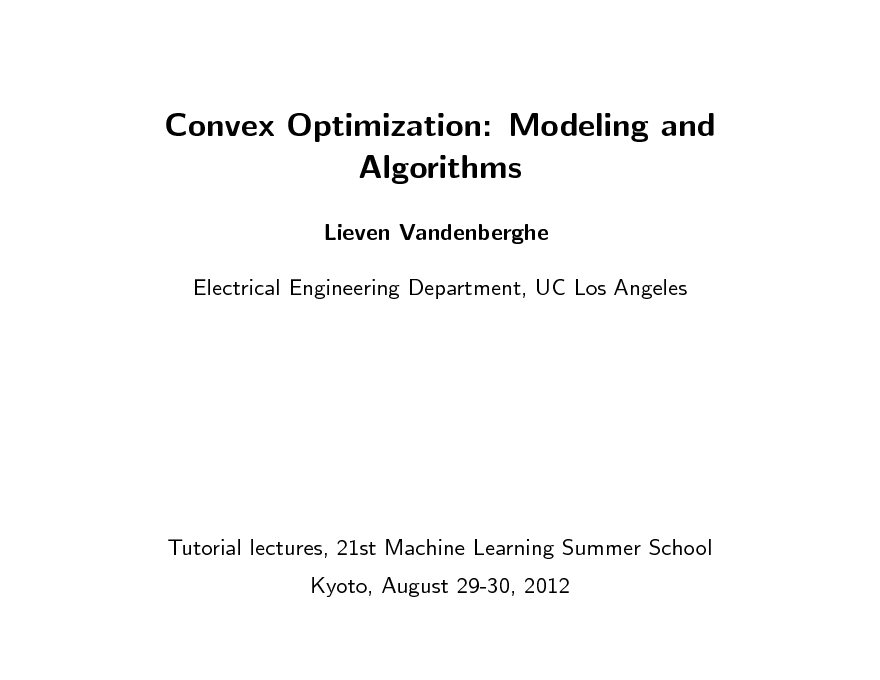
Convex Optimization: Modeling and Algorithms
Lieven Vandenberghe Electrical Engineering Department, UC Los Angeles
Tutorial lectures, 21st Machine Learning Summer School Kyoto, August 29-30, 2012
1
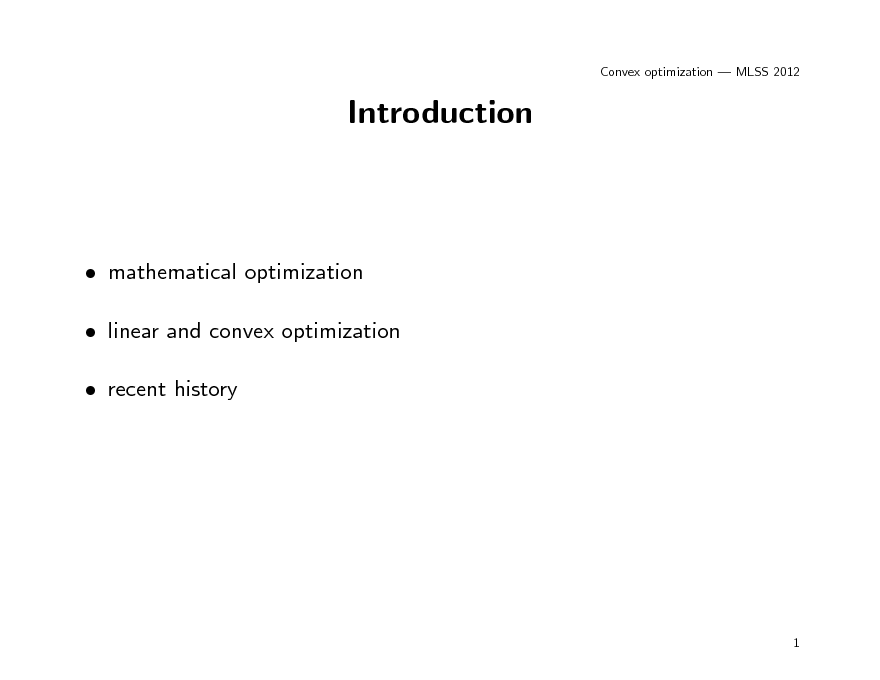
Convex optimization MLSS 2012
Introduction
mathematical optimization linear and convex optimization recent history
1
2
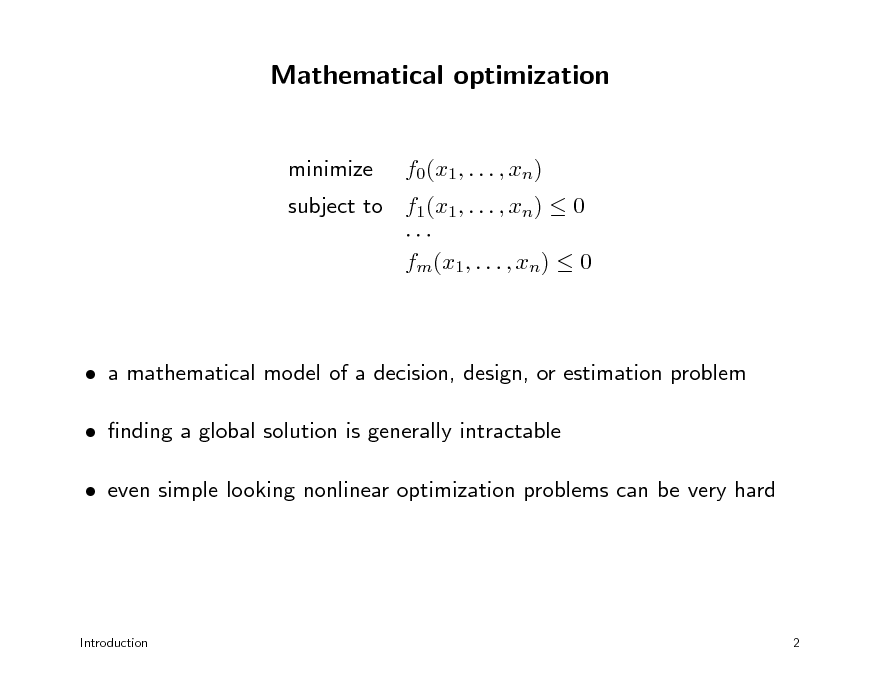
Mathematical optimization
minimize f0(x1, . . . , xn)
subject to f1(x1, . . . , xn) 0 fm(x1, . . . , xn) 0
a mathematical model of a decision, design, or estimation problem nding a global solution is generally intractable even simple looking nonlinear optimization problems can be very hard
Introduction
2
3
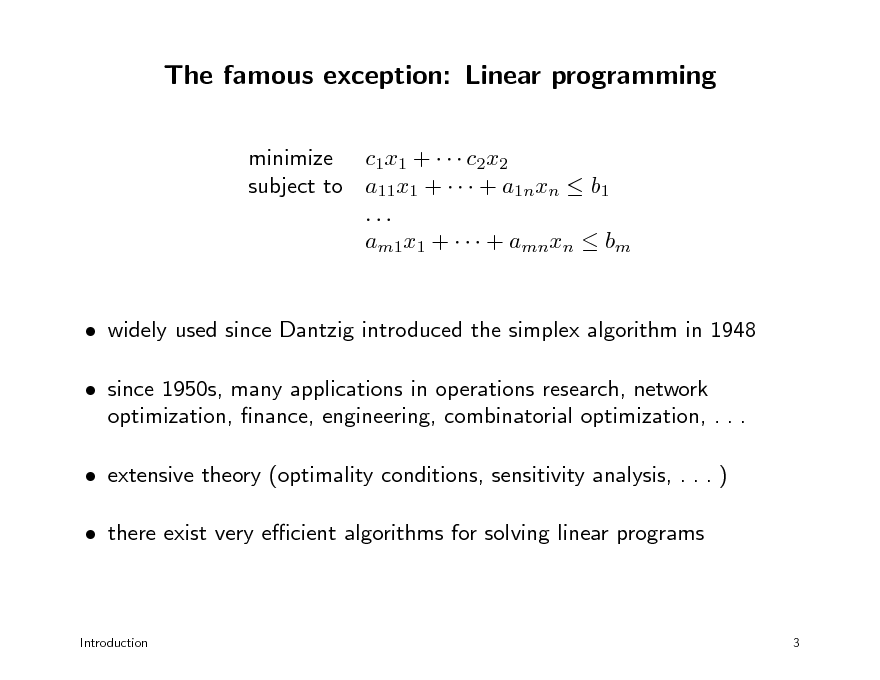
The famous exception: Linear programming
minimize c1x1 + c2x2 subject to a11x1 + + a1nxn b1 ... am1x1 + + amnxn bm widely used since Dantzig introduced the simplex algorithm in 1948 since 1950s, many applications in operations research, network optimization, nance, engineering, combinatorial optimization, . . . extensive theory (optimality conditions, sensitivity analysis, . . . ) there exist very ecient algorithms for solving linear programs
Introduction
3
4
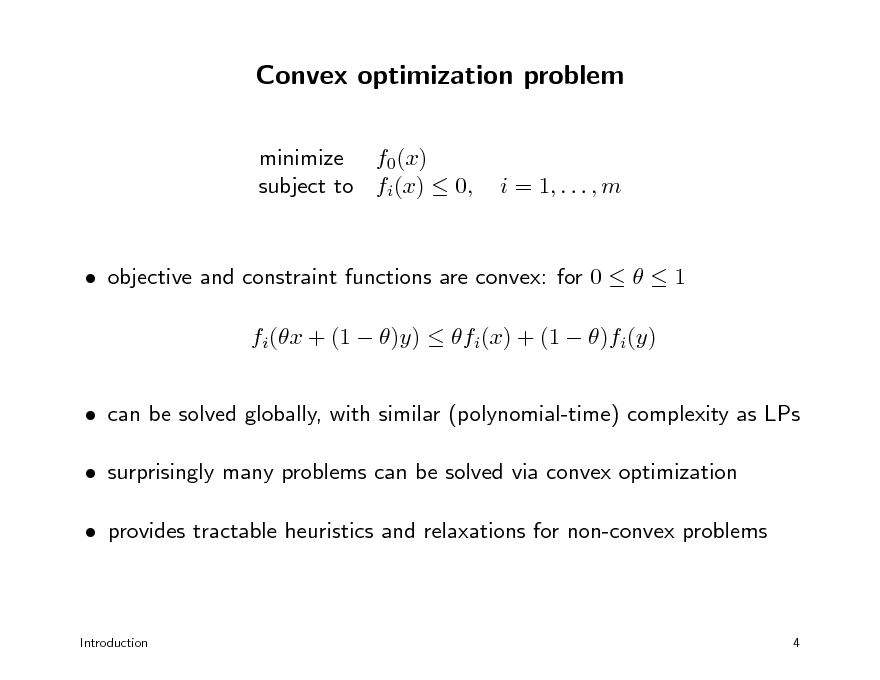
Convex optimization problem
minimize f0(x) subject to fi(x) 0,
i = 1, . . . , m
objective and constraint functions are convex: for 0 1 fi(x + (1 )y) fi(x) + (1 )fi(y) can be solved globally, with similar (polynomial-time) complexity as LPs surprisingly many problems can be solved via convex optimization provides tractable heuristics and relaxations for non-convex problems
Introduction
4
5
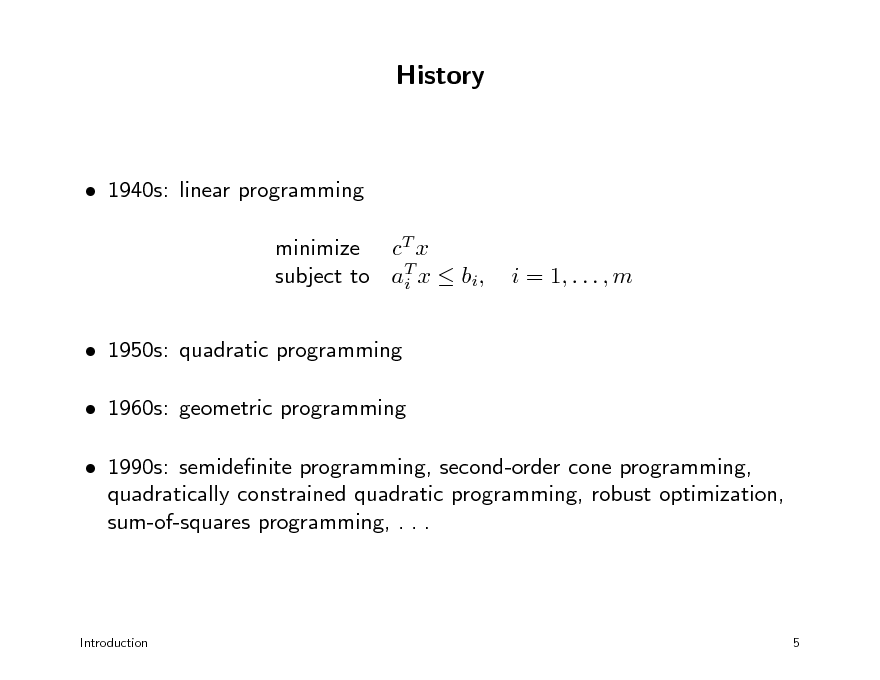
History
1940s: linear programming minimize cT x subject to aT x bi, i 1950s: quadratic programming 1960s: geometric programming 1990s: semidenite programming, second-order cone programming, quadratically constrained quadratic programming, robust optimization, sum-of-squares programming, . . . i = 1, . . . , m
Introduction
5
6
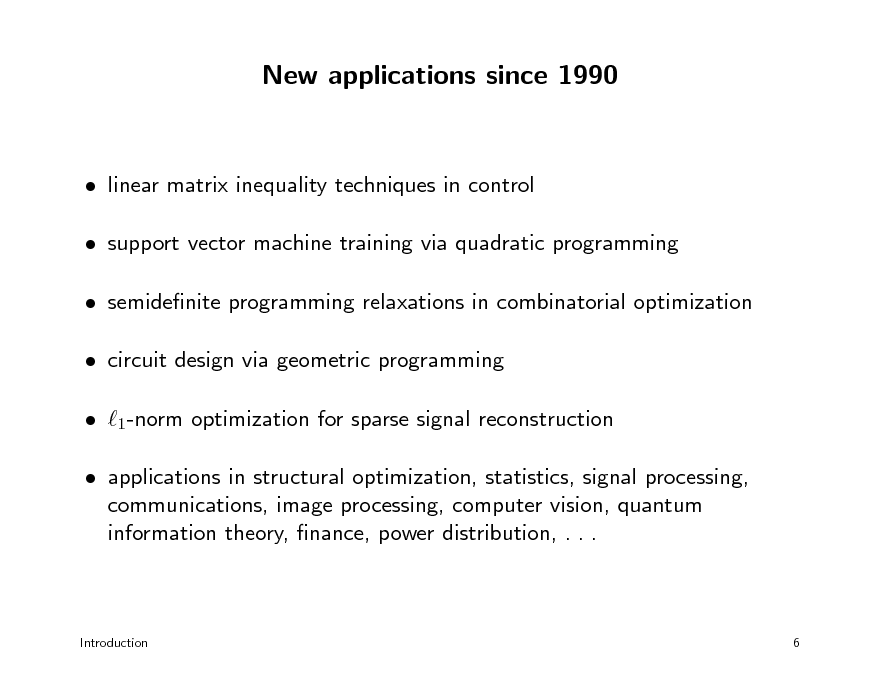
New applications since 1990
linear matrix inequality techniques in control support vector machine training via quadratic programming semidenite programming relaxations in combinatorial optimization circuit design via geometric programming 1-norm optimization for sparse signal reconstruction applications in structural optimization, statistics, signal processing, communications, image processing, computer vision, quantum information theory, nance, power distribution, . . .
Introduction
6
7
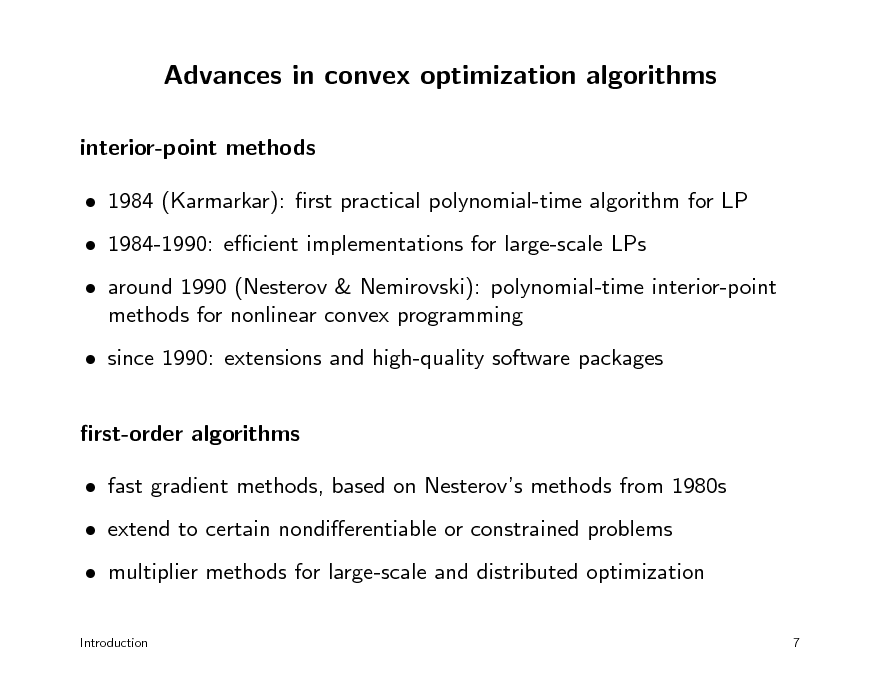
Advances in convex optimization algorithms
interior-point methods 1984 (Karmarkar): rst practical polynomial-time algorithm for LP 1984-1990: ecient implementations for large-scale LPs around 1990 (Nesterov & Nemirovski): polynomial-time interior-point methods for nonlinear convex programming since 1990: extensions and high-quality software packages rst-order algorithms fast gradient methods, based on Nesterovs methods from 1980s extend to certain nondierentiable or constrained problems multiplier methods for large-scale and distributed optimization
Introduction 7
8
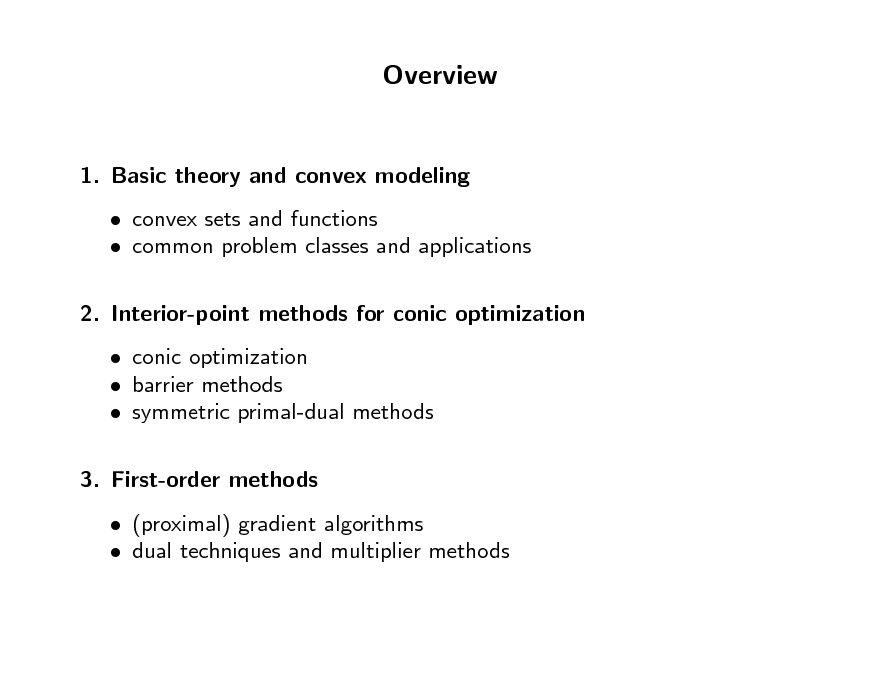
Overview
1. Basic theory and convex modeling convex sets and functions common problem classes and applications 2. Interior-point methods for conic optimization conic optimization barrier methods symmetric primal-dual methods 3. First-order methods (proximal) gradient algorithms dual techniques and multiplier methods
9
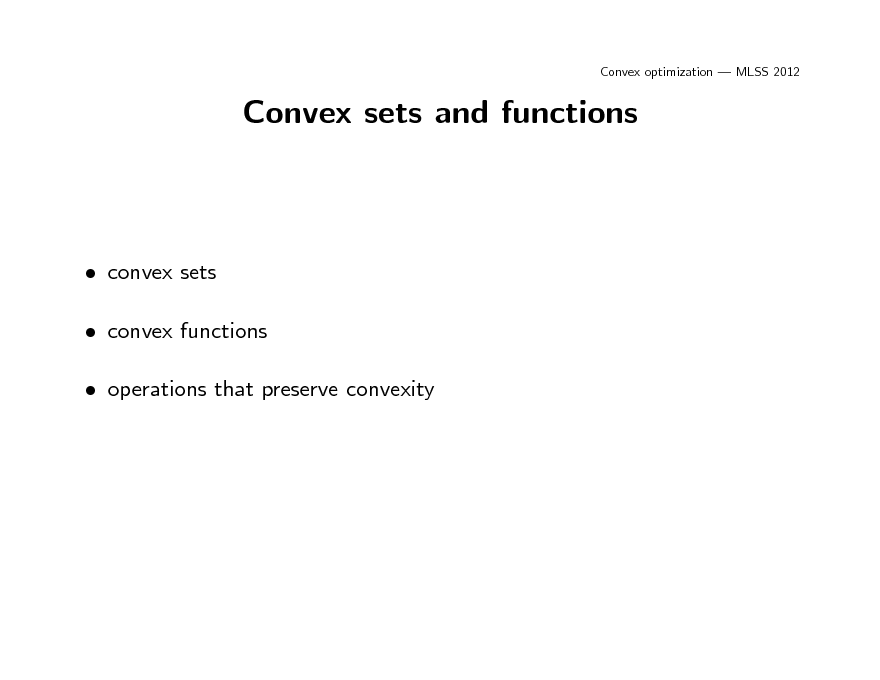
Convex optimization MLSS 2012
Convex sets and functions
convex sets convex functions operations that preserve convexity
10
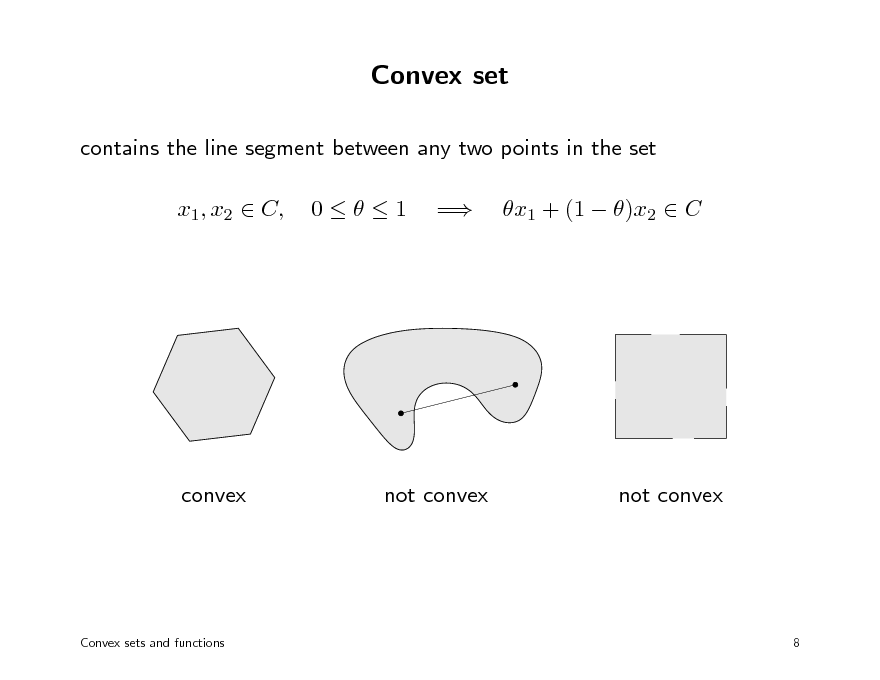
Convex set
contains the line segment between any two points in the set x1, x2 C, 01 = x1 + (1 )x2 C
convex
not convex
not convex
Convex sets and functions
8
11
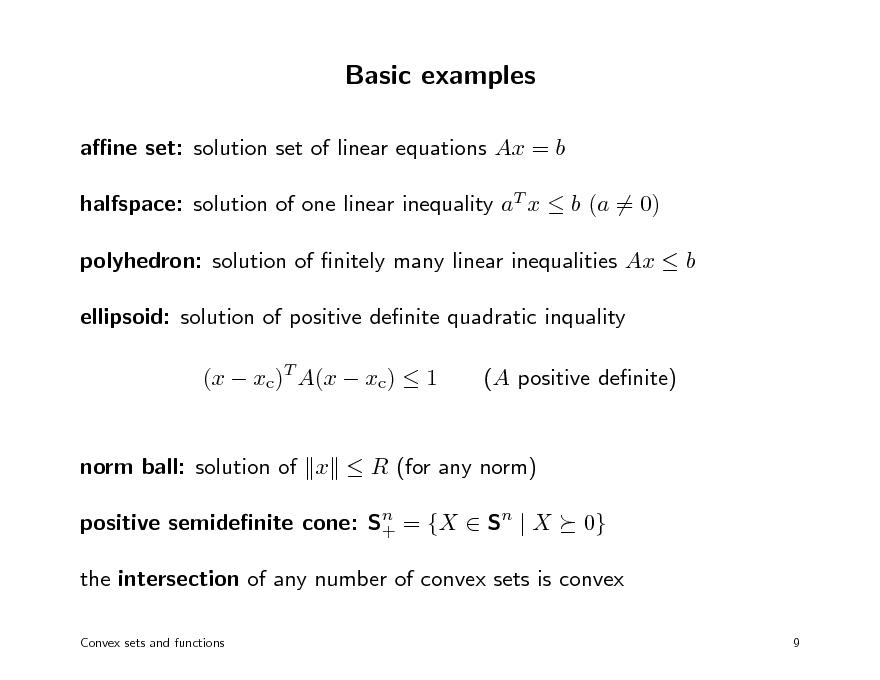
Basic examples
ane set: solution set of linear equations Ax = b halfspace: solution of one linear inequality aT x b (a = 0) polyhedron: solution of nitely many linear inequalities Ax b ellipsoid: solution of positive denite quadratic inquality (x xc)T A(x xc) 1 (A positive denite)
norm ball: solution of x R (for any norm) positive semidenite cone: Sn = {X Sn | X + 0}
the intersection of any number of convex sets is convex
Convex sets and functions 9
12
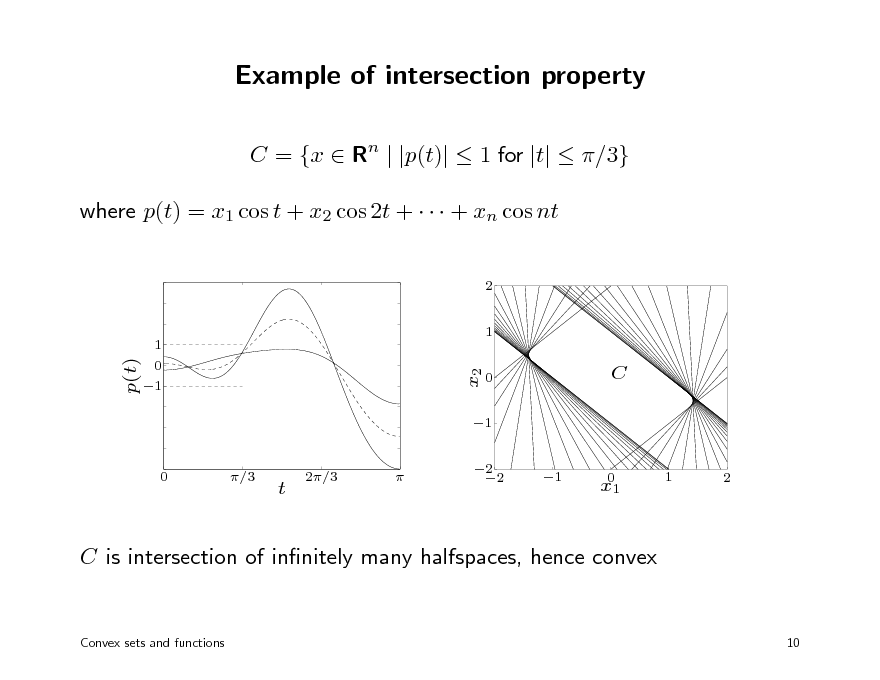
Example of intersection property
C = {x Rn | |p(t)| 1 for |t| /3} where p(t) = x1 cos t + x2 cos 2t + + xn cos nt
2 1
1
p(t)
x2
0 1
0
C
1 2 2
0
/3
t
2/3
1
0 x1
1
2
C is intersection of innitely many halfspaces, hence convex
Convex sets and functions
10
13
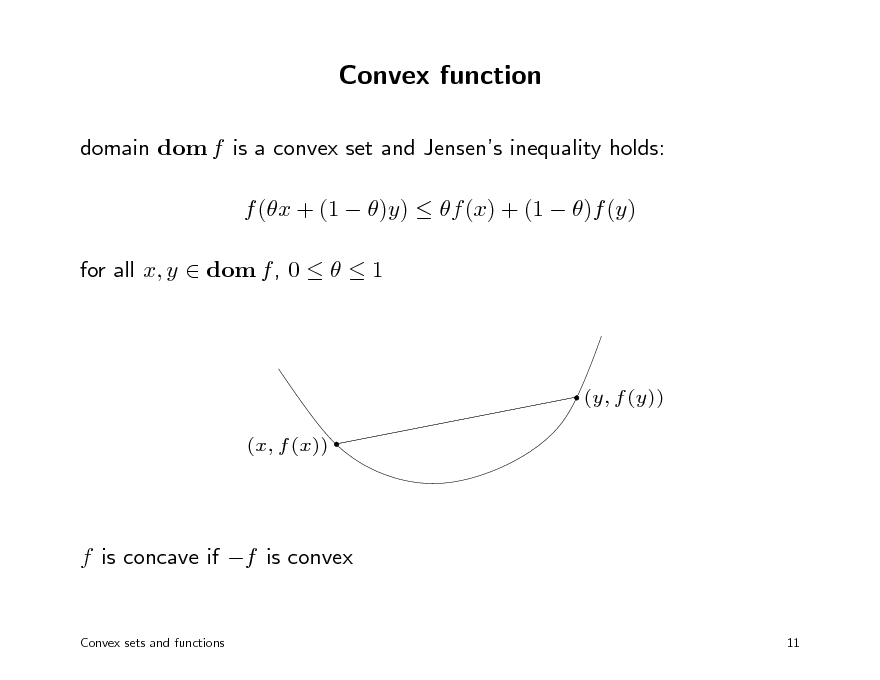
Convex function
domain dom f is a convex set and Jensens inequality holds: f (x + (1 )y) f (x) + (1 )f (y) for all x, y dom f , 0 1
(y, f (y)) (x, f (x))
f is concave if f is convex
Convex sets and functions 11
14
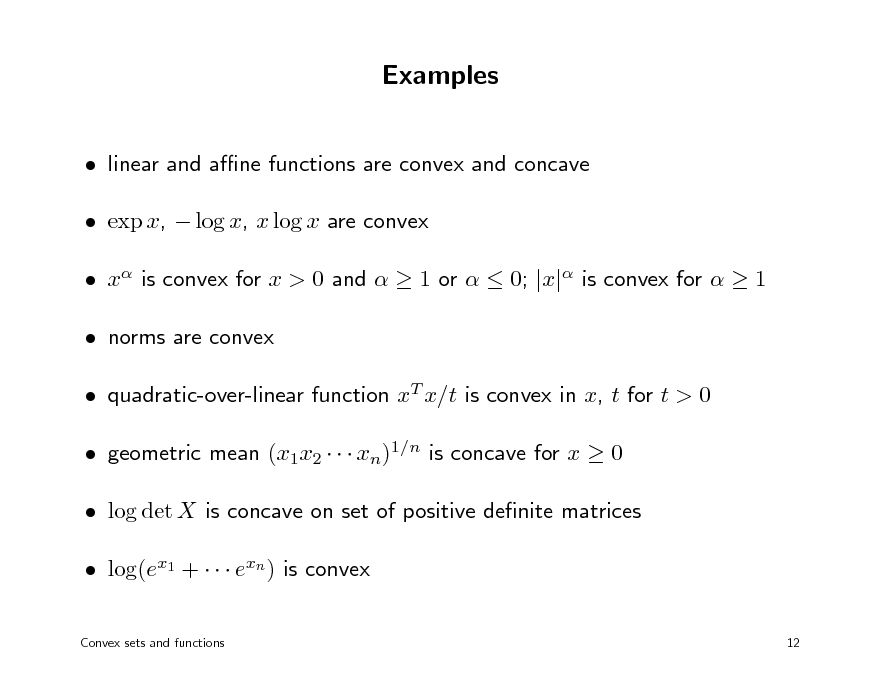
Examples
linear and ane functions are convex and concave exp x, log x, x log x are convex x is convex for x > 0 and 1 or 0; |x| is convex for 1 norms are convex quadratic-over-linear function xT x/t is convex in x, t for t > 0 geometric mean (x1x2 xn)1/n is concave for x 0 log det X is concave on set of positive denite matrices log(ex1 + exn ) is convex
Convex sets and functions 12
15
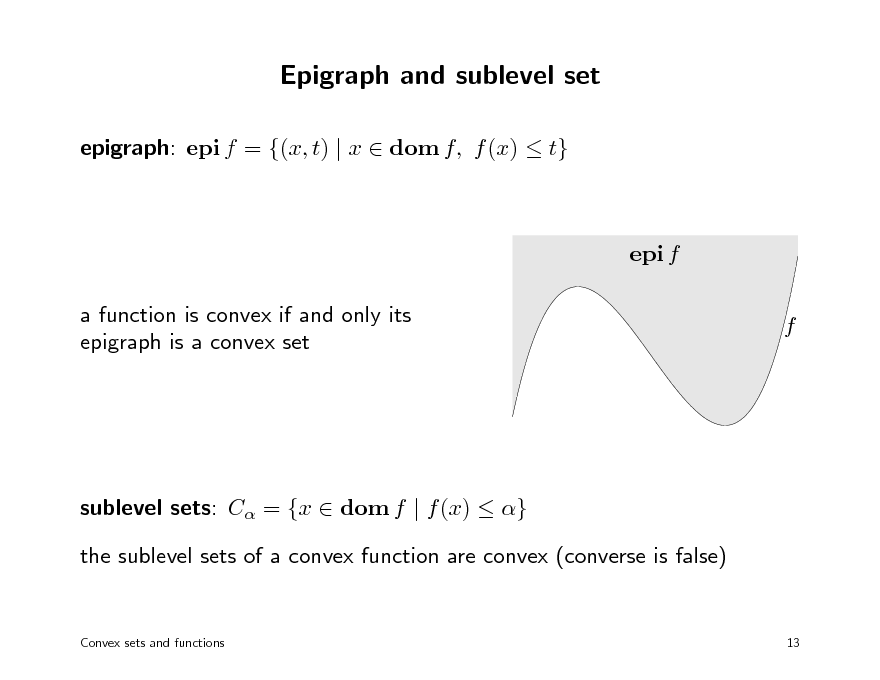
Epigraph and sublevel set
epigraph: epi f = {(x, t) | x dom f, f (x) t}
epi f a function is convex if and only its epigraph is a convex set f
sublevel sets: C = {x dom f | f (x) } the sublevel sets of a convex function are convex (converse is false)
Convex sets and functions
13
16
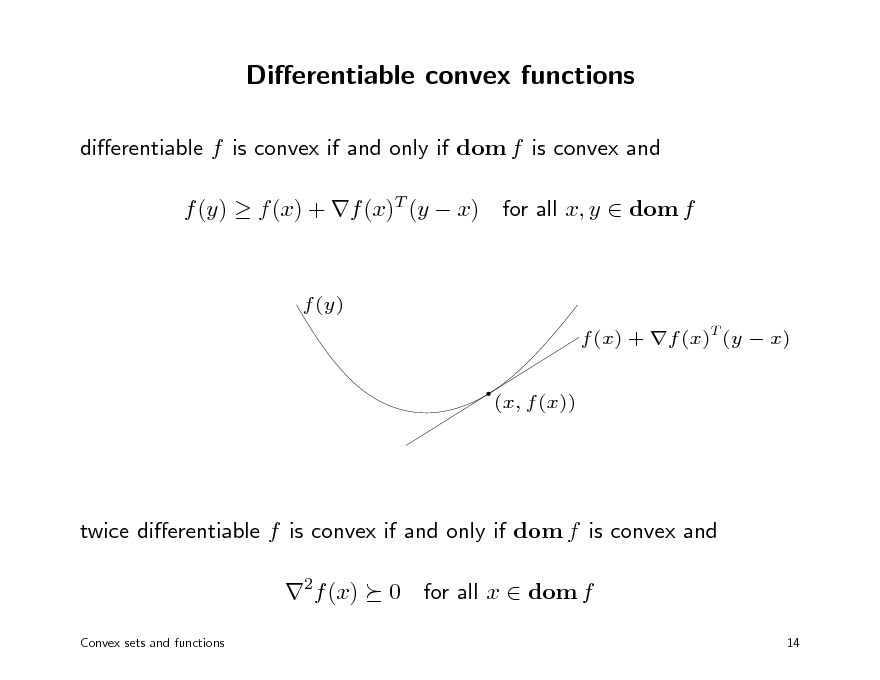
Dierentiable convex functions
dierentiable f is convex if and only if dom f is convex and f (y) f (x) + f (x)T (y x)
f (y) f (x) + f (x)T (y x) (x, f (x))
for all x, y dom f
twice dierentiable f is convex if and only if dom f is convex and 2f (x)
Convex sets and functions
0 for all x dom f
14
17
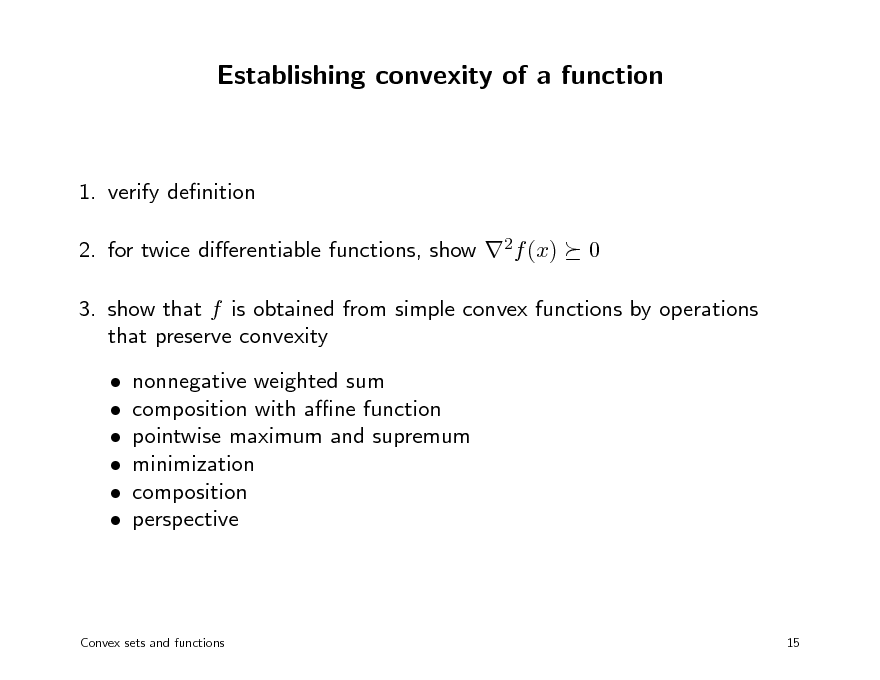
Establishing convexity of a function
1. verify denition 2. for twice dierentiable functions, show 2f (x) 0
3. show that f is obtained from simple convex functions by operations that preserve convexity nonnegative weighted sum composition with ane function pointwise maximum and supremum minimization composition perspective
Convex sets and functions
15
18
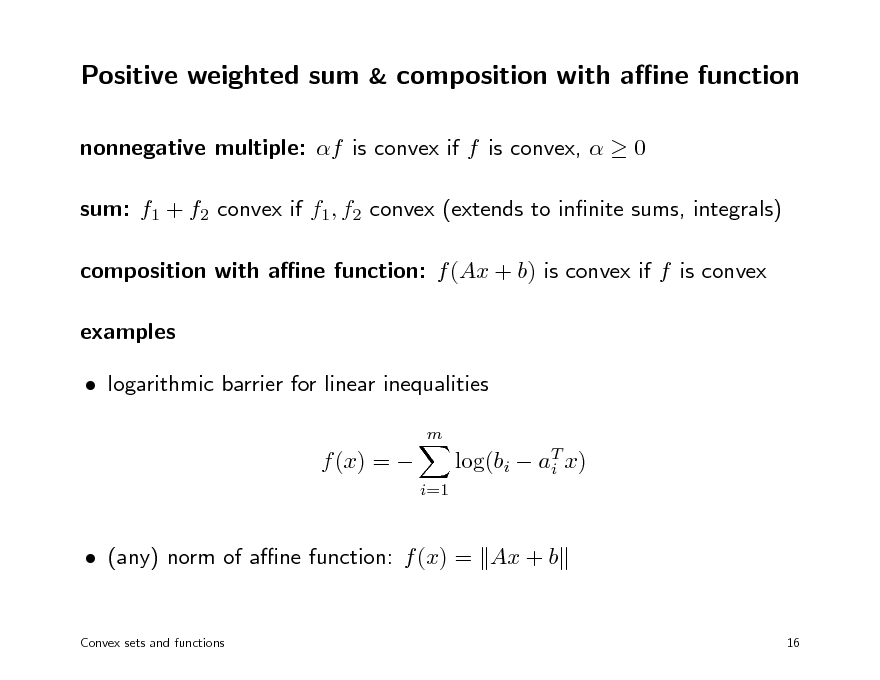
Positive weighted sum & composition with ane function
nonnegative multiple: f is convex if f is convex, 0 sum: f1 + f2 convex if f1, f2 convex (extends to innite sums, integrals) composition with ane function: f (Ax + b) is convex if f is convex examples logarithmic barrier for linear inequalities
m
f (x) =
i=1
log(bi aT x) i
(any) norm of ane function: f (x) = Ax + b
Convex sets and functions 16
19
![Slide: Pointwise maximum
f (x) = max{f1(x), . . . , fm(x)} is convex if f1, . . . , fm are convex example: sum of r largest components of x Rn f (x) = x[1] + x[2] + + x[r] is convex (x[i] is ith largest component of x) proof: f (x) = max{xi1 + xi2 + + xir | 1 i1 < i2 < < ir n}
Convex sets and functions
17](https://yosinski.com/mlss12/media/slides/MLSS-2012-Vandenberghe-Convex-Optimization_020.png)
Pointwise maximum
f (x) = max{f1(x), . . . , fm(x)} is convex if f1, . . . , fm are convex example: sum of r largest components of x Rn f (x) = x[1] + x[2] + + x[r] is convex (x[i] is ith largest component of x) proof: f (x) = max{xi1 + xi2 + + xir | 1 i1 < i2 < < ir n}
Convex sets and functions
17
20
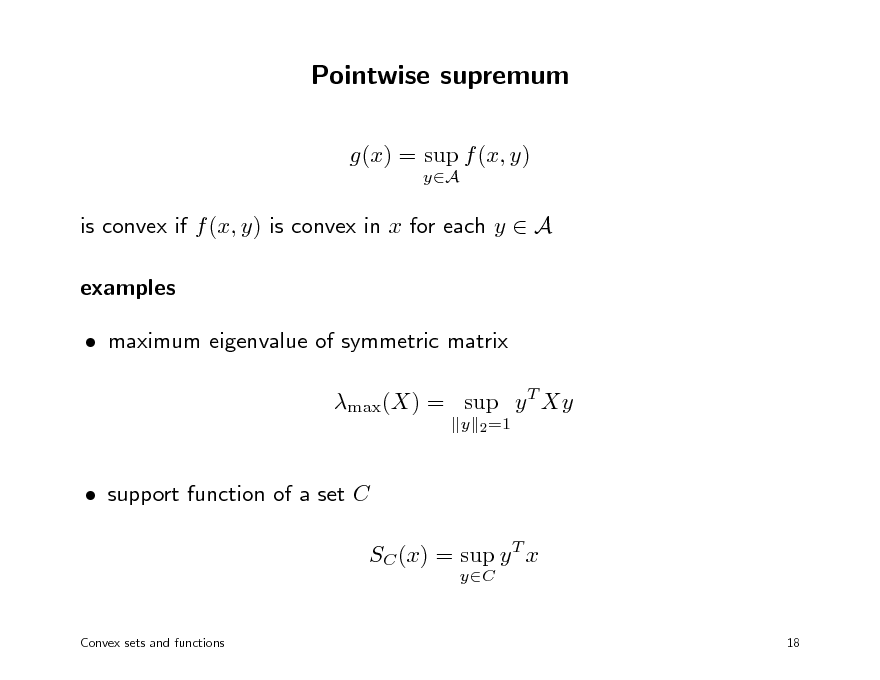
Pointwise supremum
g(x) = sup f (x, y)
yA
is convex if f (x, y) is convex in x for each y A examples maximum eigenvalue of symmetric matrix max(X) = sup y T Xy
y 2 =1
support function of a set C SC (x) = sup y T x
yC
Convex sets and functions
18
21
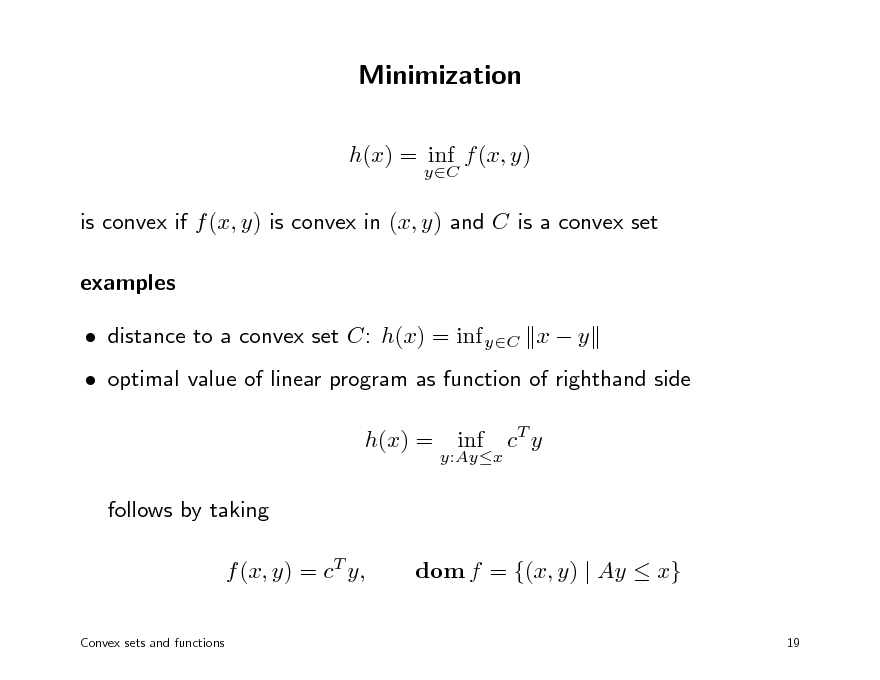
Minimization
h(x) = inf f (x, y)
yC
is convex if f (x, y) is convex in (x, y) and C is a convex set examples distance to a convex set C: h(x) = inf yC x y optimal value of linear program as function of righthand side h(x) = follows by taking f (x, y) = cT y,
Convex sets and functions
y:Ayx
inf
cT y
dom f = {(x, y) | Ay x}
19
22
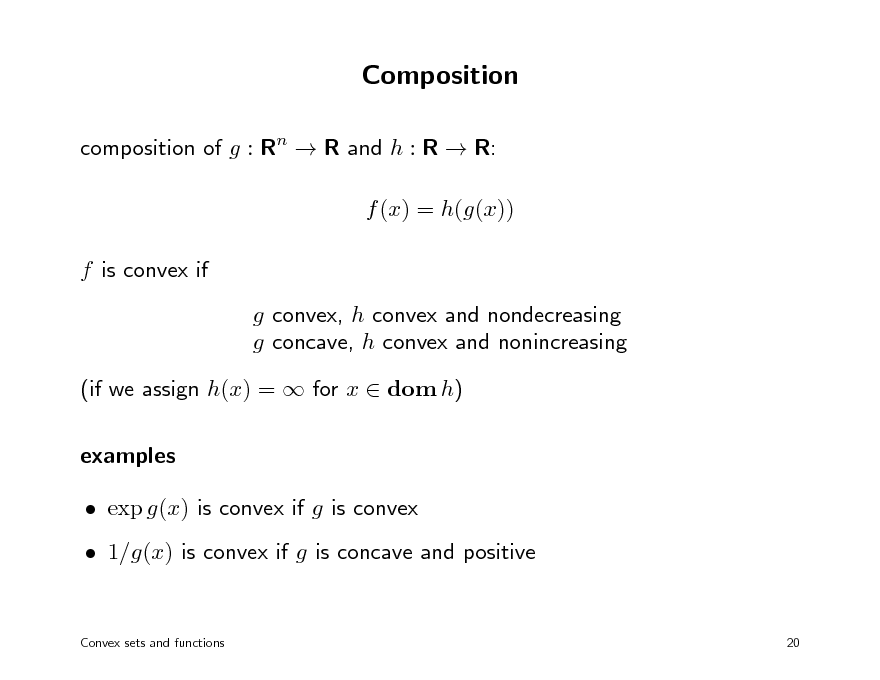
Composition
composition of g : Rn R and h : R R: f (x) = h(g(x)) f is convex if g convex, h convex and nondecreasing g concave, h convex and nonincreasing (if we assign h(x) = for x dom h) examples exp g(x) is convex if g is convex 1/g(x) is convex if g is concave and positive
Convex sets and functions 20
23
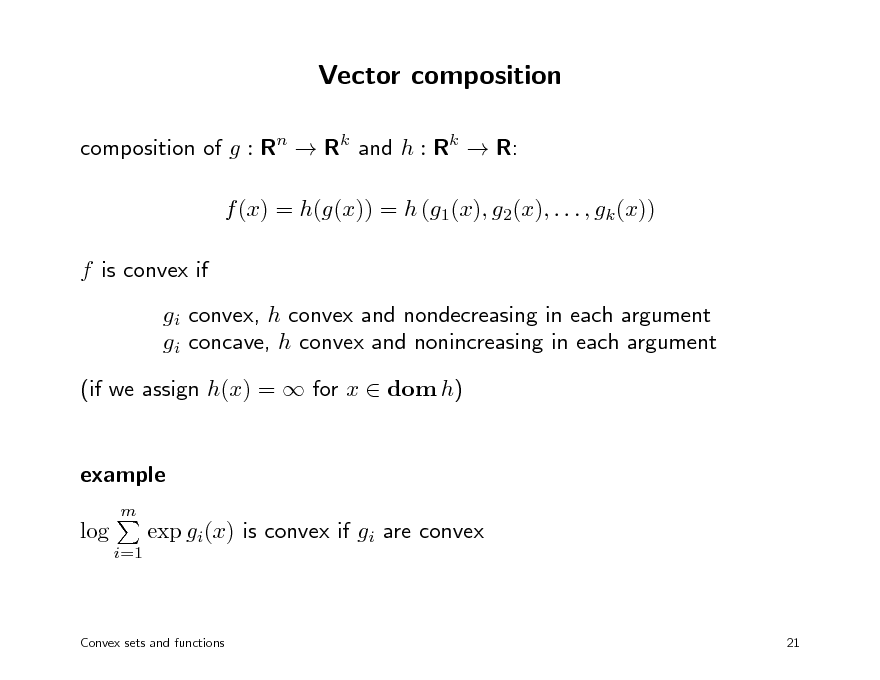
Vector composition
composition of g : Rn Rk and h : Rk R: f (x) = h(g(x)) = h (g1(x), g2(x), . . . , gk (x)) f is convex if gi convex, h convex and nondecreasing in each argument gi concave, h convex and nonincreasing in each argument (if we assign h(x) = for x dom h) example
m
log
i=1
exp gi(x) is convex if gi are convex
Convex sets and functions
21
24
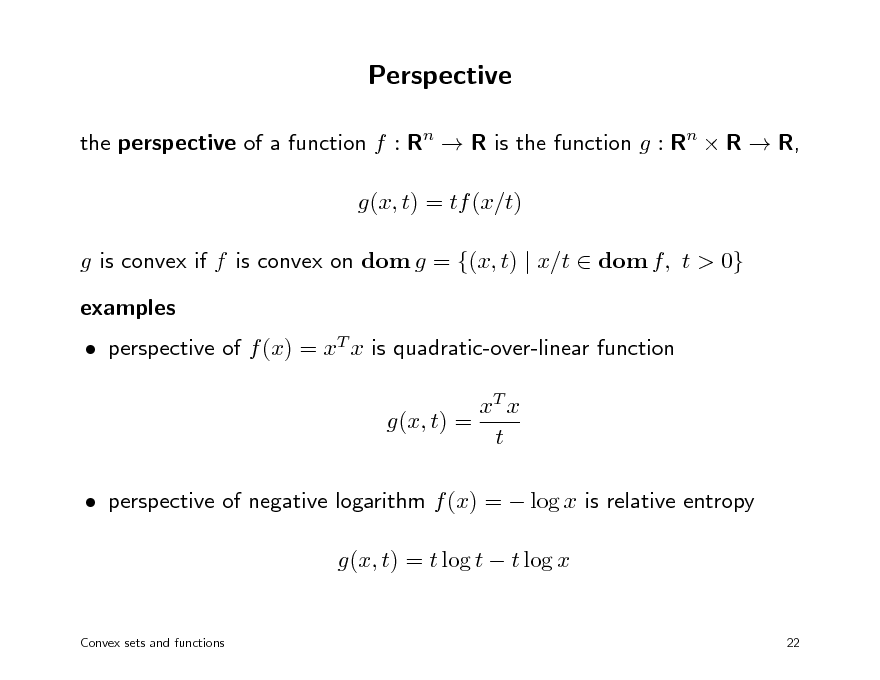
Perspective
the perspective of a function f : Rn R is the function g : Rn R R, g(x, t) = tf (x/t) g is convex if f is convex on dom g = {(x, t) | x/t dom f, t > 0} examples perspective of f (x) = xT x is quadratic-over-linear function xT x g(x, t) = t perspective of negative logarithm f (x) = log x is relative entropy g(x, t) = t log t t log x
Convex sets and functions 22
25
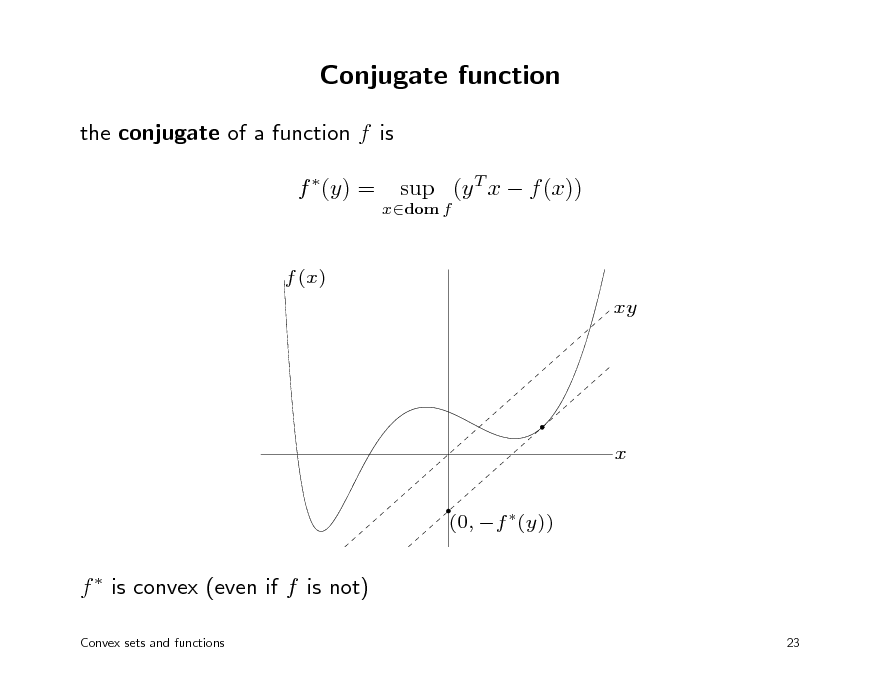
Conjugate function
the conjugate of a function f is f (y) =
xdom f
sup (y T x f (x))
f (x) xy
x (0, f (y))
f is convex (even if f is not)
Convex sets and functions 23
26
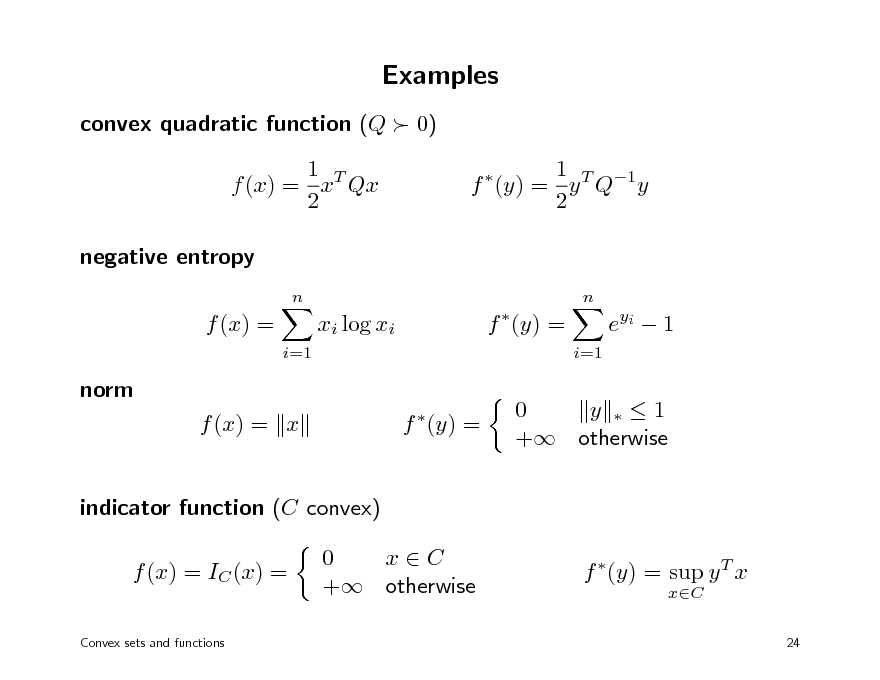
Examples
convex quadratic function (Q 0) 1 T f (x) = x Qx 2 negative entropy
n n
1 T 1 f (y) = y Q y 2
f (x) =
i=1
xi log xi
f (y) =
i=1
e yi 1
norm f (x) = x f (y) =
0 y 1 + otherwise
indicator function (C convex) f (x) = IC (x) =
Convex sets and functions
0 xC + otherwise
f (y) = sup y T x
xC
24
27
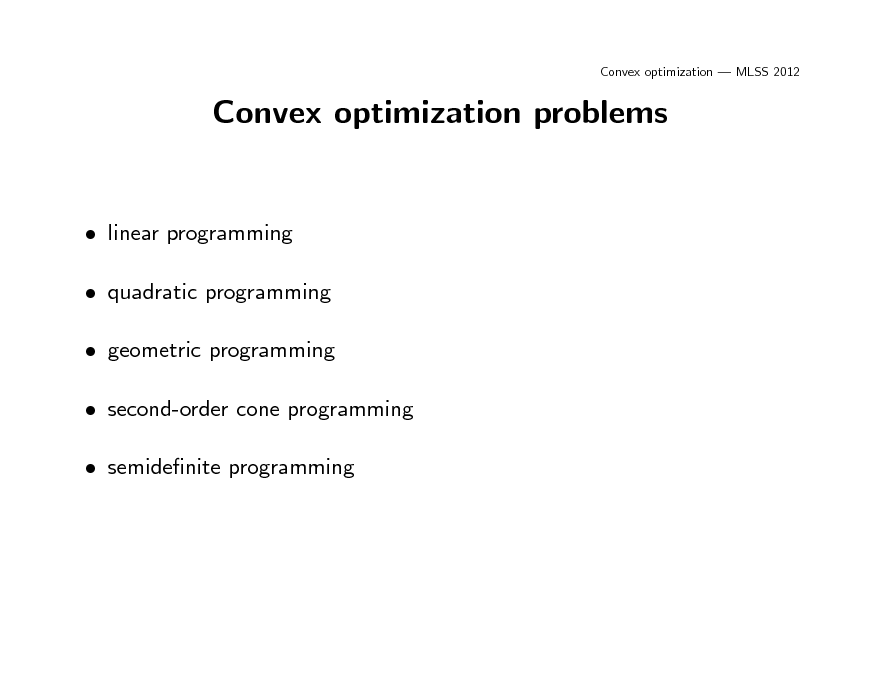
Convex optimization MLSS 2012
Convex optimization problems
linear programming quadratic programming geometric programming second-order cone programming semidenite programming
28
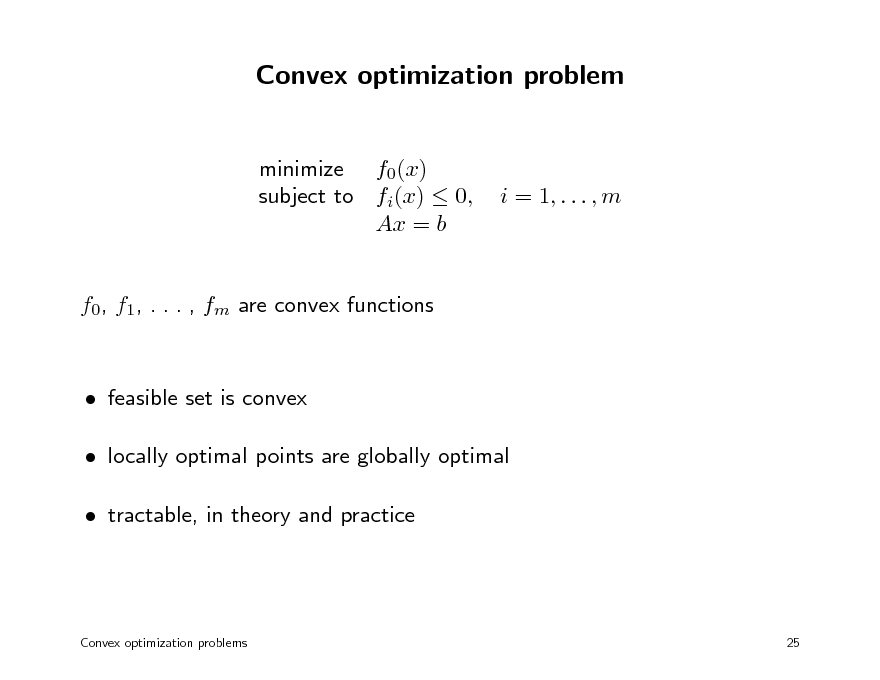
Convex optimization problem
minimize f0(x) subject to fi(x) 0, Ax = b
i = 1, . . . , m
f0, f1, . . . , fm are convex functions
feasible set is convex locally optimal points are globally optimal tractable, in theory and practice
Convex optimization problems
25
29
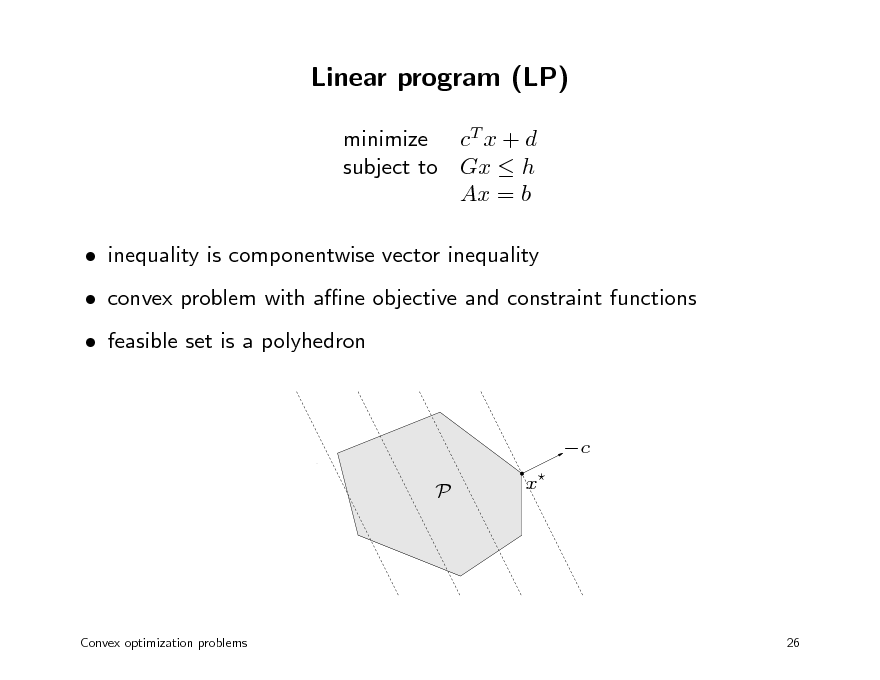
Linear program (LP)
minimize cT x + d subject to Gx h Ax = b inequality is componentwise vector inequality convex problem with ane objective and constraint functions feasible set is a polyhedron
c P x
Convex optimization problems
26
30
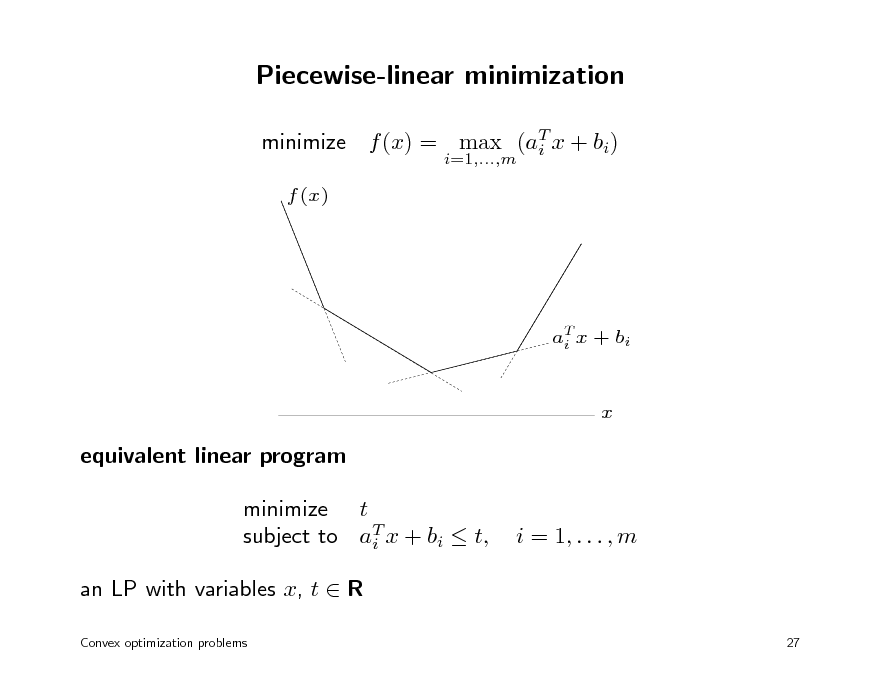
Piecewise-linear minimization
minimize f (x) = max (aT x + bi) i
i=1,...,m
f (x)
aT x + bi i
x
equivalent linear program minimize t subject to aT x + bi t, i an LP with variables x, t R
Convex optimization problems 27
i = 1, . . . , m
31
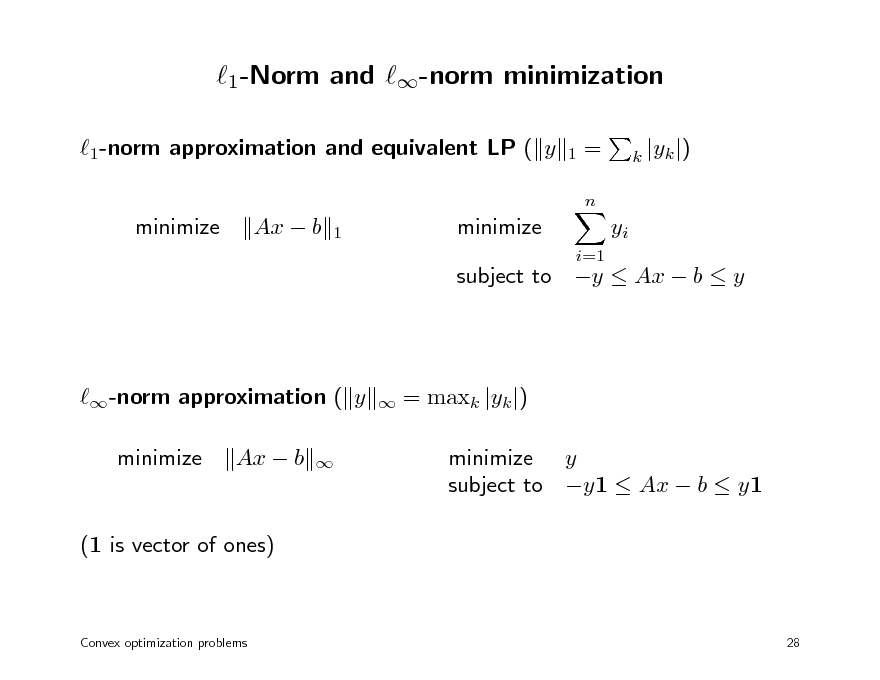
1-Norm and -norm minimization
1-norm approximation and equivalent LP ( y minimize Ax b minimize
i=1 1
=
n
k |yk |)
1
yi
subject to y Ax b y
-norm approximation ( y minimize Ax b
= maxk |yk |) minimize y subject to y1 Ax b y1
(1 is vector of ones)
Convex optimization problems
28
32
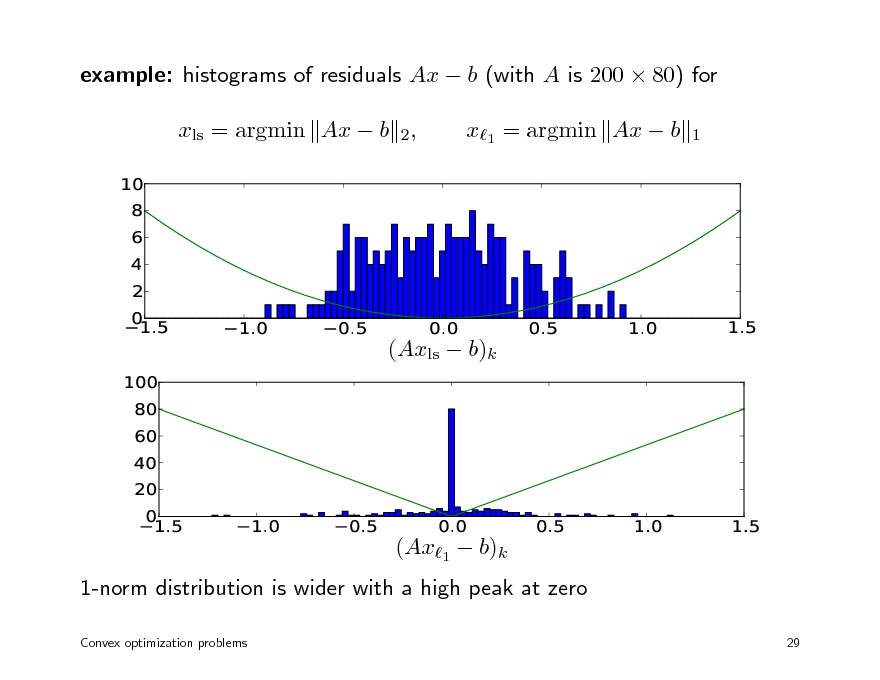
example: histograms of residuals Ax b (with A is 200 80) for xls = argmin Ax b 2,
10 8 6 4 2 0 1.5 1.0 0.5 0.0 0.5 1.0 1.5
x1 = argmin Ax b
1
(Axls b)k
100 80 60 40 20 0 1.5 1.0 0.5 0.0 0.5 1.0 1.5
(Ax1 b)k 1-norm distribution is wider with a high peak at zero
Convex optimization problems 29
33
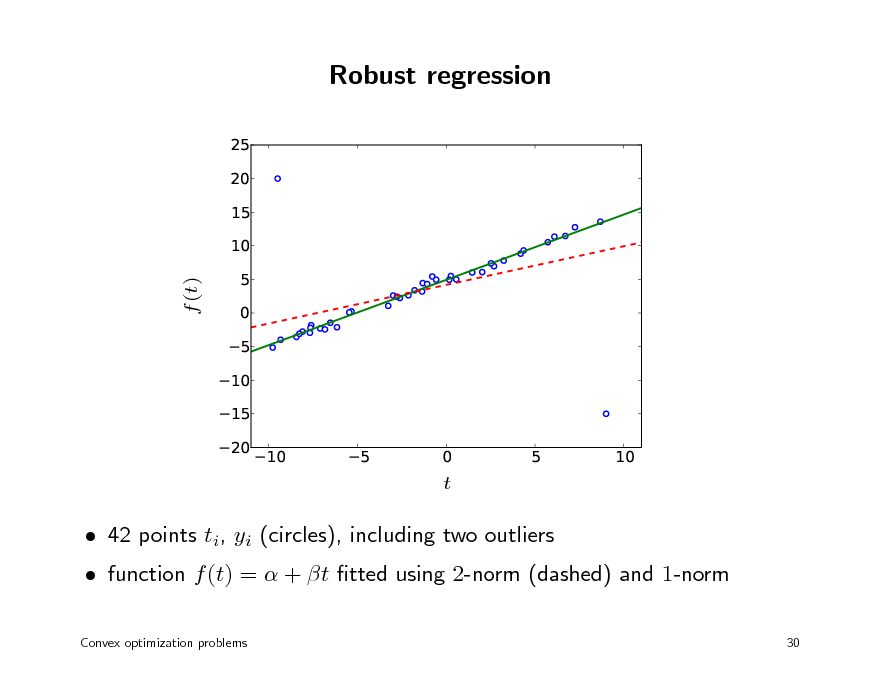
Robust regression
25 20 15 10 5 0 5 10 15 20 10
f (t)
5
0 t
5
10
function f (t) = + t tted using 2-norm (dashed) and 1-norm
Convex optimization problems 30
42 points ti, yi (circles), including two outliers
34
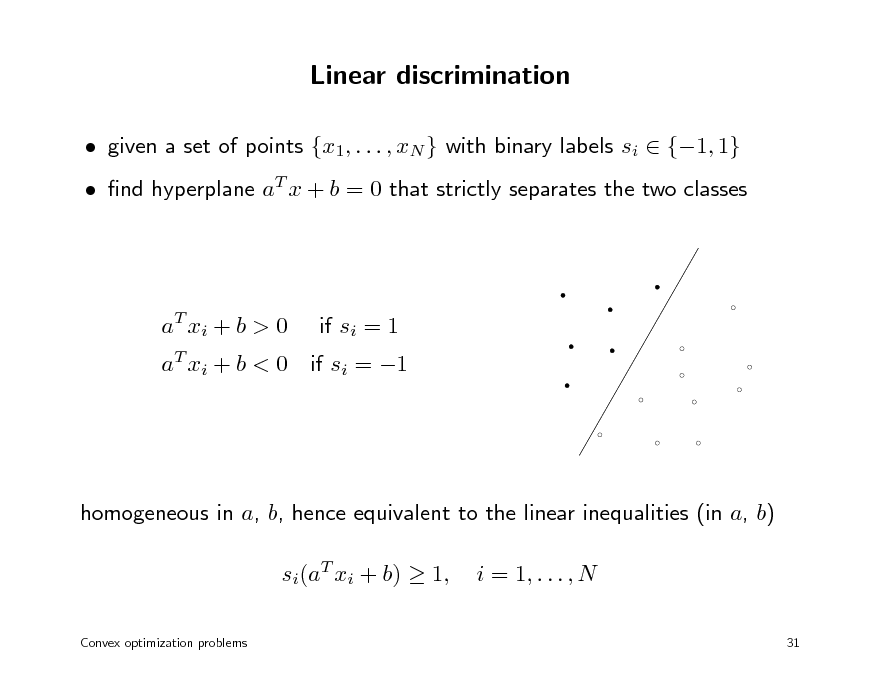
Linear discrimination
given a set of points {x1, . . . , xN } with binary labels si {1, 1} nd hyperplane aT x + b = 0 that strictly separates the two classes
a T xi + b > 0
if si = 1
aT xi + b < 0 if si = 1
homogeneous in a, b, hence equivalent to the linear inequalities (in a, b) si(aT xi + b) 1,
Convex optimization problems
i = 1, . . . , N
31
35
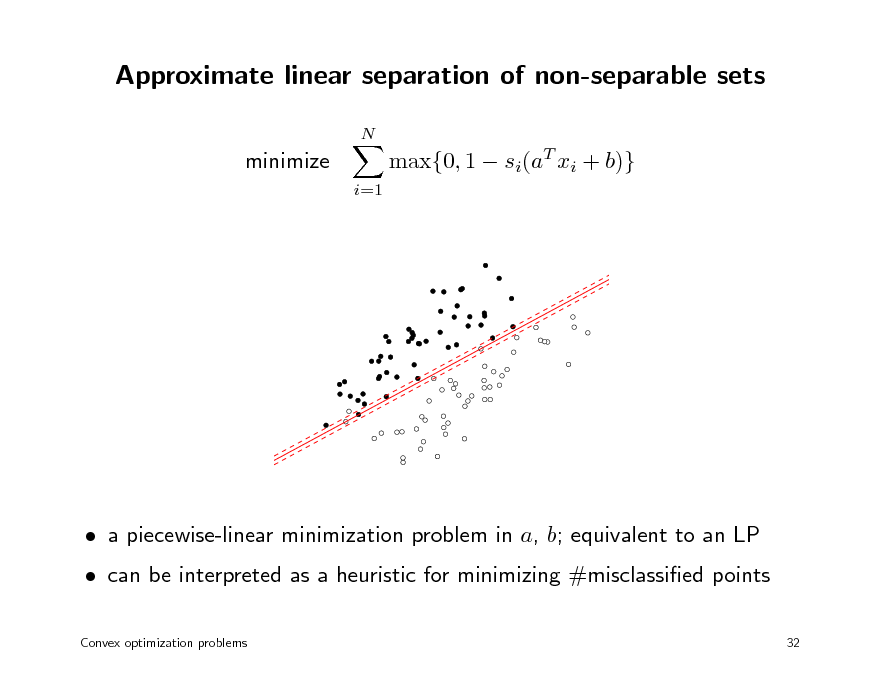
Approximate linear separation of non-separable sets
N
minimize
i=1
max{0, 1 si(aT xi + b)}
can be interpreted as a heuristic for minimizing #misclassied points
Convex optimization problems 32
a piecewise-linear minimization problem in a, b; equivalent to an LP
36
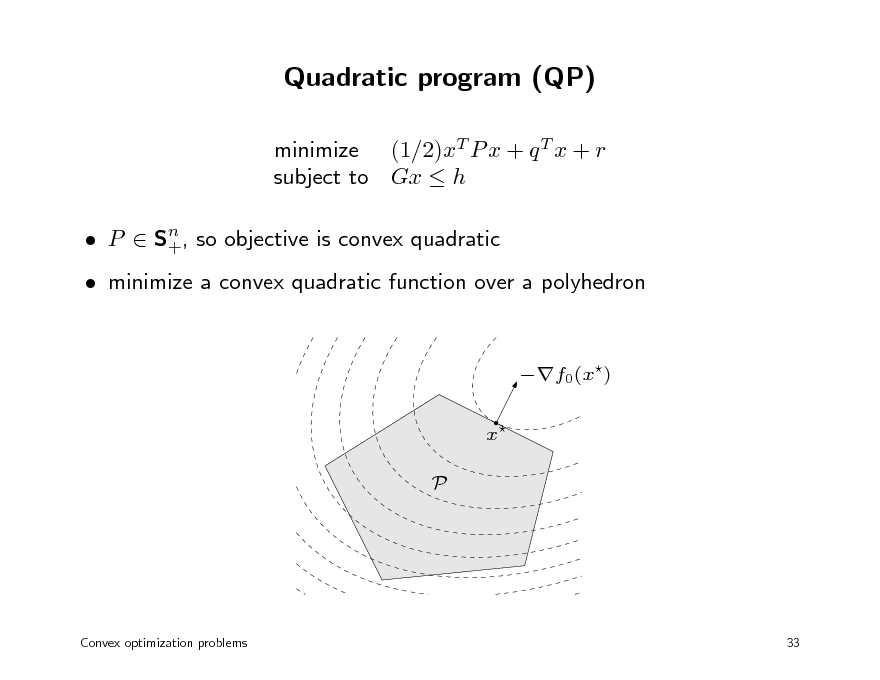
Quadratic program (QP)
minimize (1/2)xT P x + q T x + r subject to Gx h
n P S+, so objective is convex quadratic
minimize a convex quadratic function over a polyhedron
f0(x) x P
Convex optimization problems
33
37
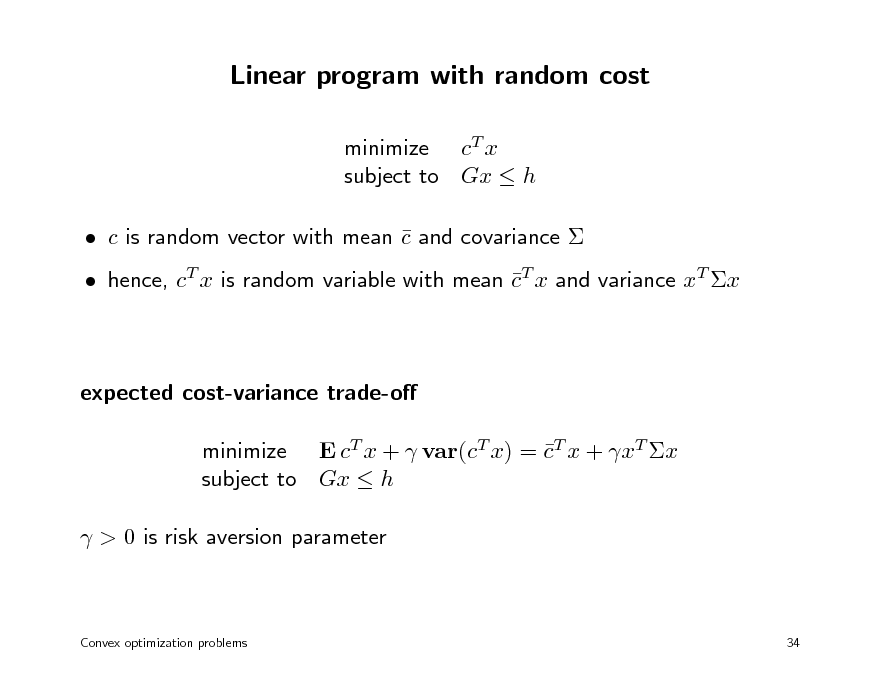
Linear program with random cost
minimize cT x subject to Gx h c is random vector with mean c and covariance hence, cT x is random variable with mean cT x and variance xT x
expected cost-variance trade-o minimize E cT x + var(cT x) = cT x + xT x subject to Gx h > 0 is risk aversion parameter
Convex optimization problems
34
38
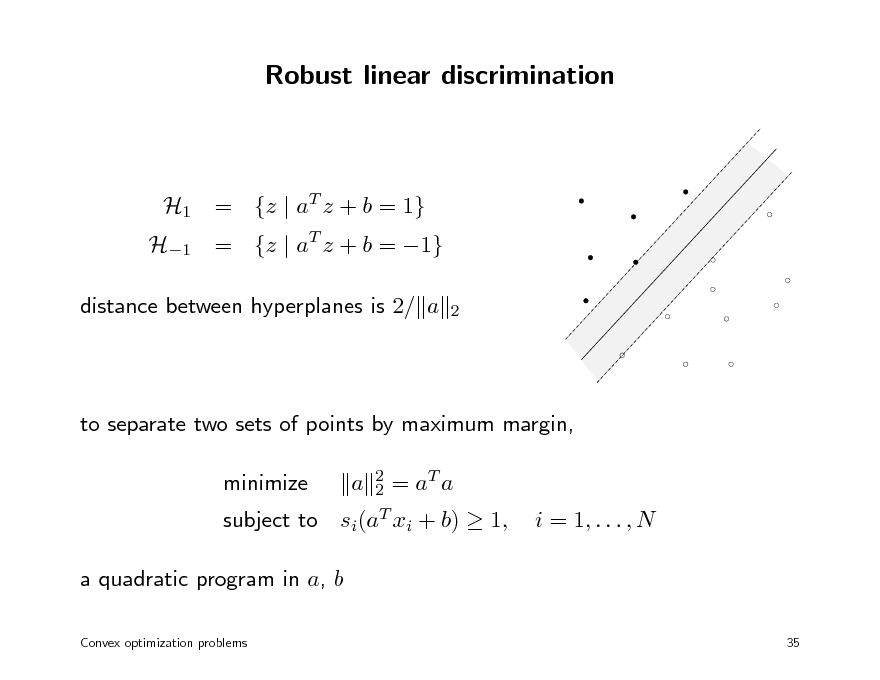
Robust linear discrimination
H1 = {z | aT z + b = 1} distance between hyperplanes is 2/ a
2
H1 = {z | aT z + b = 1}
to separate two sets of points by maximum margin, minimize subject to
2 T 2 =a a si(aT xi + b)
a
1,
i = 1, . . . , N
a quadratic program in a, b
Convex optimization problems 35
39
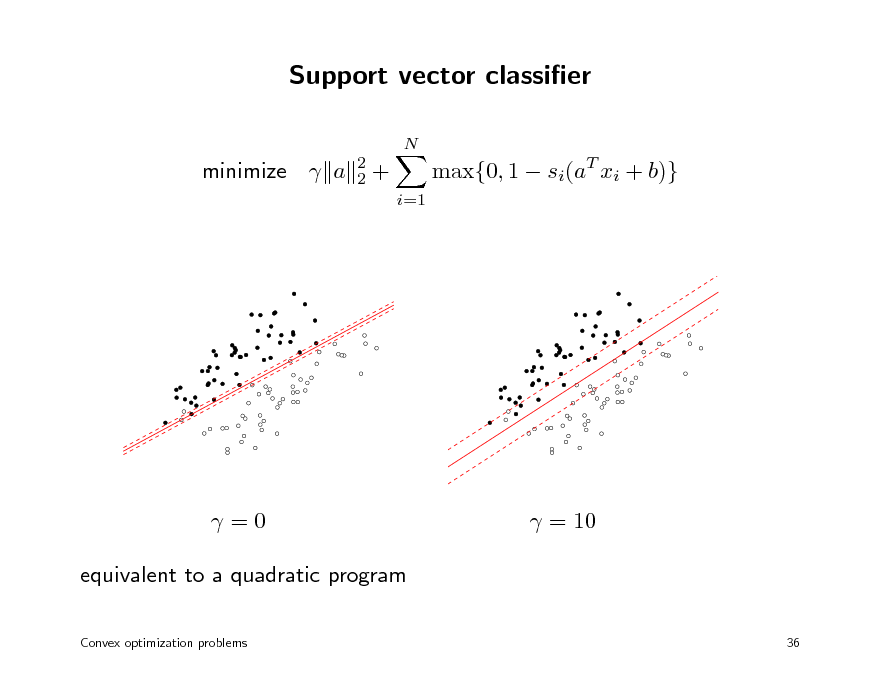
Support vector classier
N 2 2
minimize a
+
i=1
max{0, 1 si(aT xi + b)}
=0 equivalent to a quadratic program
Convex optimization problems
= 10
36
40
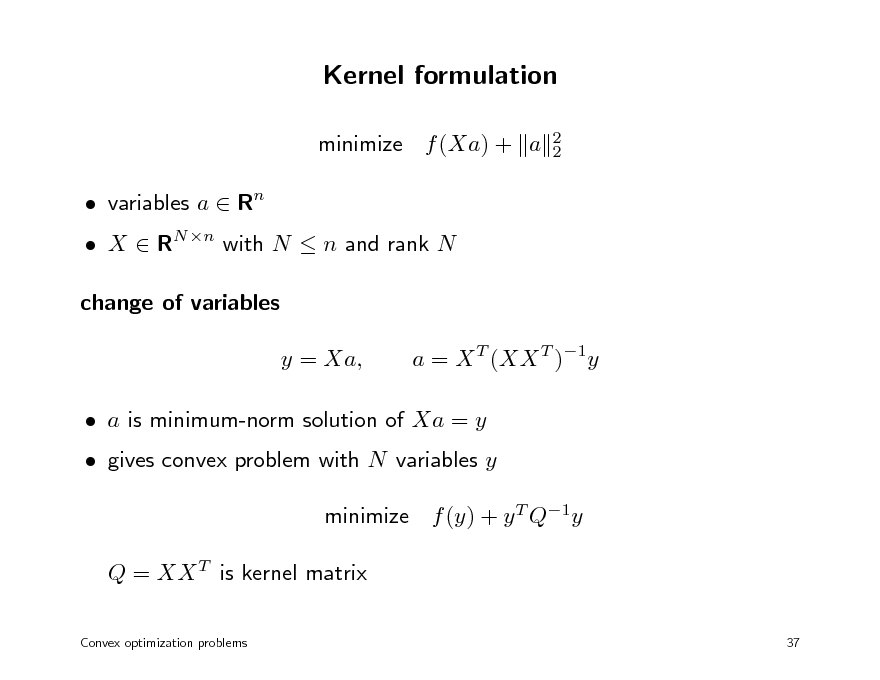
Kernel formulation
minimize f (Xa) + a variables a Rn
2 2
X RN n with N n and rank N change of variables y = Xa, a = X T (XX T )1y
a is minimum-norm solution of Xa = y gives convex problem with N variables y minimize f (y) + y T Q1y Q = XX T is kernel matrix
Convex optimization problems 37
41
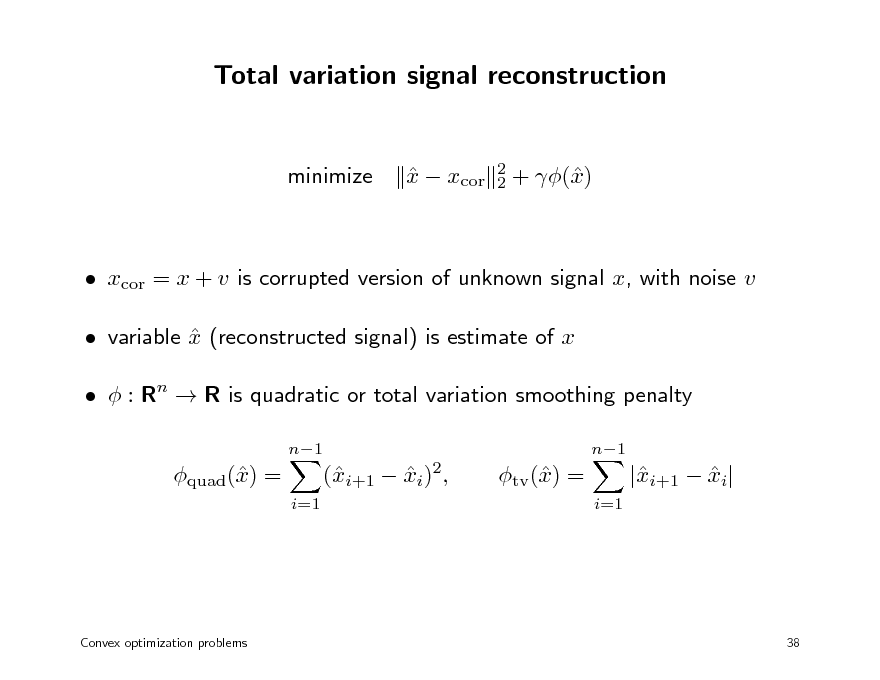
Total variation signal reconstruction
minimize
x xcor
2 2
+ () x
xcor = x + v is corrupted version of unknown signal x, with noise v variable x (reconstructed signal) is estimate of x : Rn R is quadratic or total variation smoothing penalty
n1 n1
quad() = x
i=1
(i+1 xi)2, x
tv () = x
i=1
|i+1 xi| x
Convex optimization problems
38
42
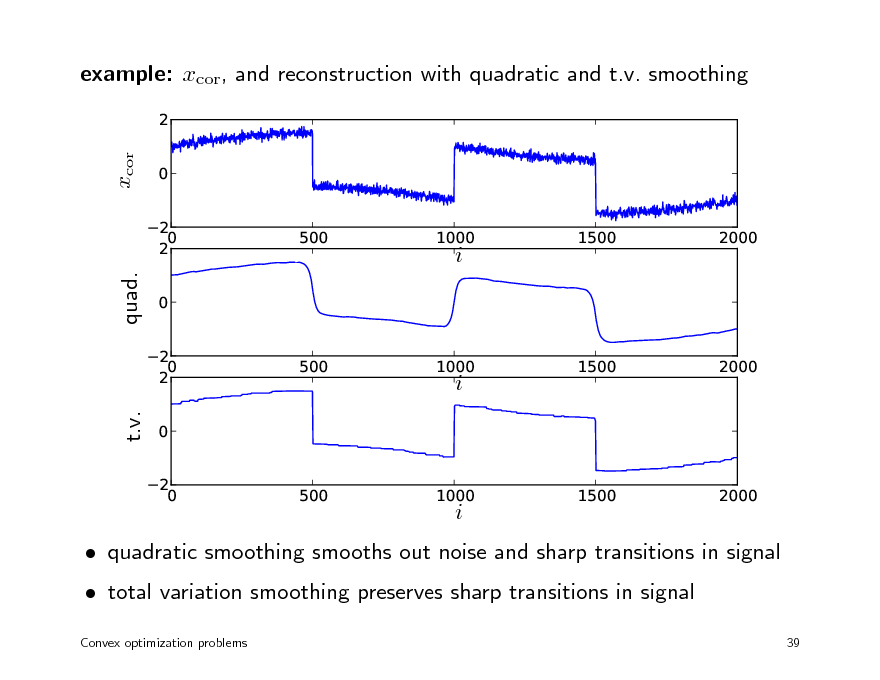
example: xcor, and reconstruction with quadratic and t.v. smoothing
2
xcor
0 2 0 2 0 2 0 2 0 2 0 500 1000 1500 2000
500
1000
i
1500
2000
quad.
500
1000
i
1500
2000
t.v.
i
quadratic smoothing smooths out noise and sharp transitions in signal total variation smoothing preserves sharp transitions in signal
Convex optimization problems 39
43
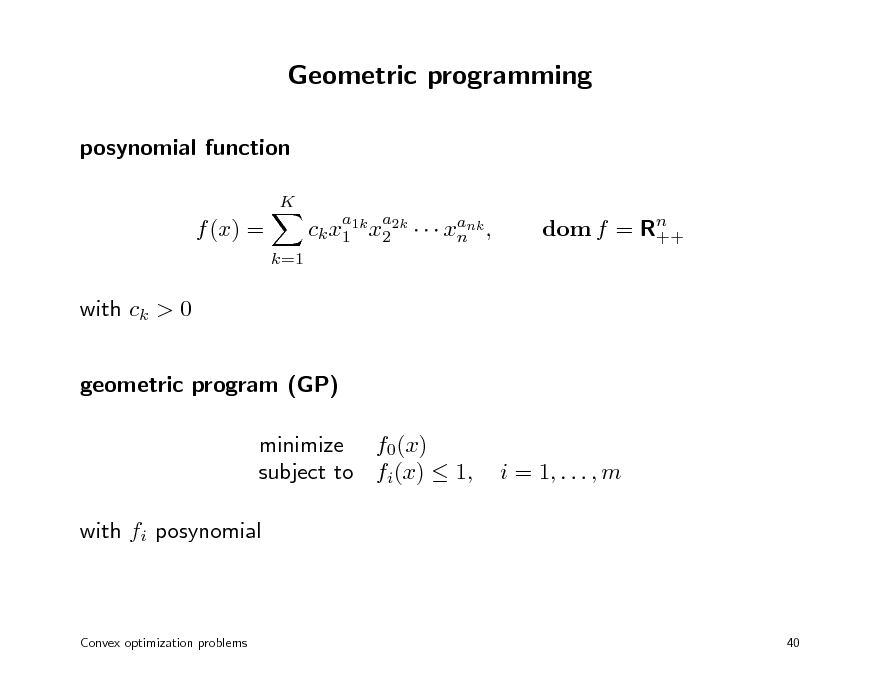
Geometric programming
posynomial function
K
f (x) =
k=1
ck x1 1k x2 2k xank , n
a
a
dom f = Rn ++
with ck > 0 geometric program (GP) minimize f0(x) subject to fi(x) 1, with fi posynomial
i = 1, . . . , m
Convex optimization problems
40
44
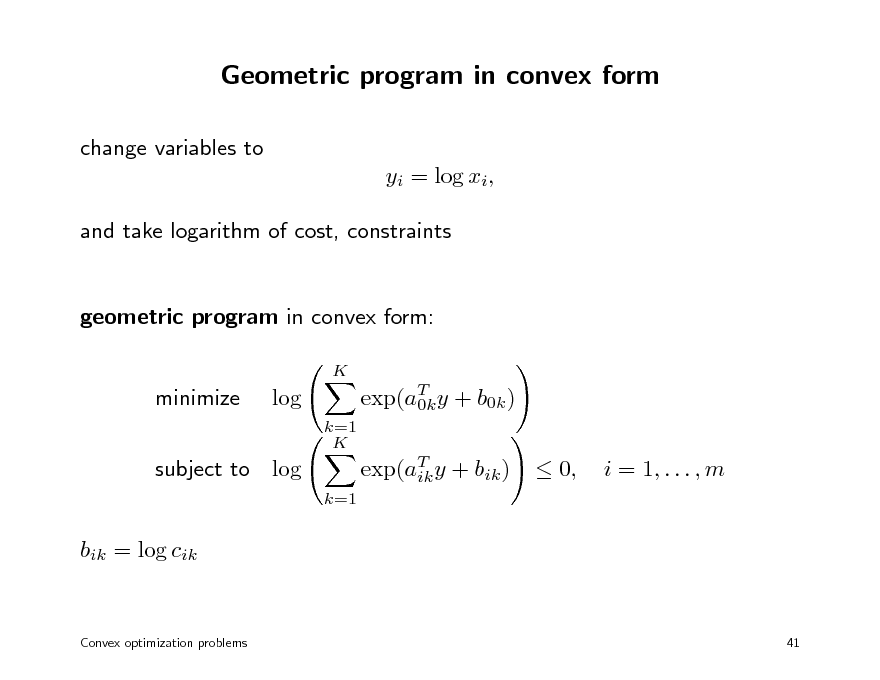
Geometric program in convex form
change variables to yi = log xi, and take logarithm of cost, constraints
geometric program in convex form:
K
minimize
log
k=1 K
exp(aT y + b0k ) 0k exp(aT y + bik ) ik
k=1
subject to log bik = log cik
0,
i = 1, . . . , m
Convex optimization problems
41
45
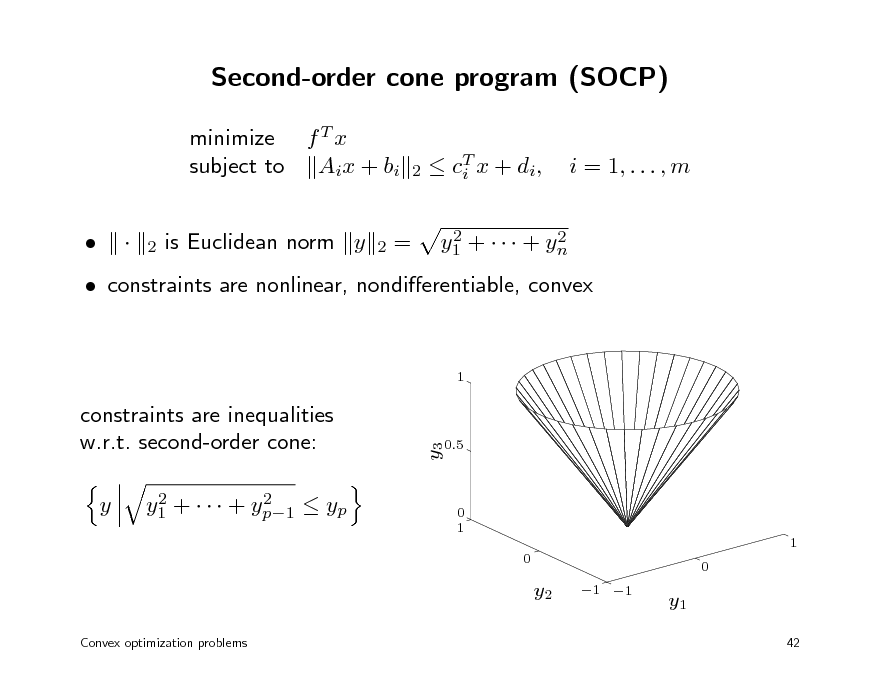
Second-order cone program (SOCP)
minimize f T x subject to Aix + bi is Euclidean norm y =
T c i x + di , 2 2 y1 + + yn
2
i = 1, . . . , m
2
2
constraints are nonlinear, nondierentiable, convex
1
y
2 2 y1 + + yp1 yp
y3
constraints are inequalities w.r.t. second-order cone:
0.5
0 1 1 0 0
y2
Convex optimization problems
1 1
y1
42
46
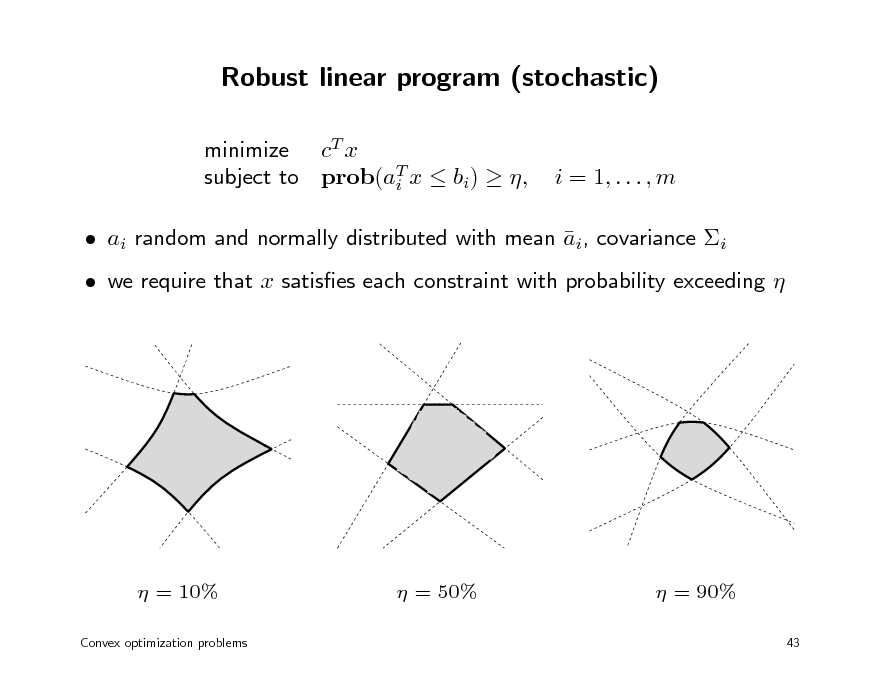
Robust linear program (stochastic)
minimize cT x subject to prob(aT x bi) , i
i = 1, . . . , m
ai random and normally distributed with mean ai, covariance i we require that x satises each constraint with probability exceeding
= 10%
Convex optimization problems
= 50%
= 90%
43
47
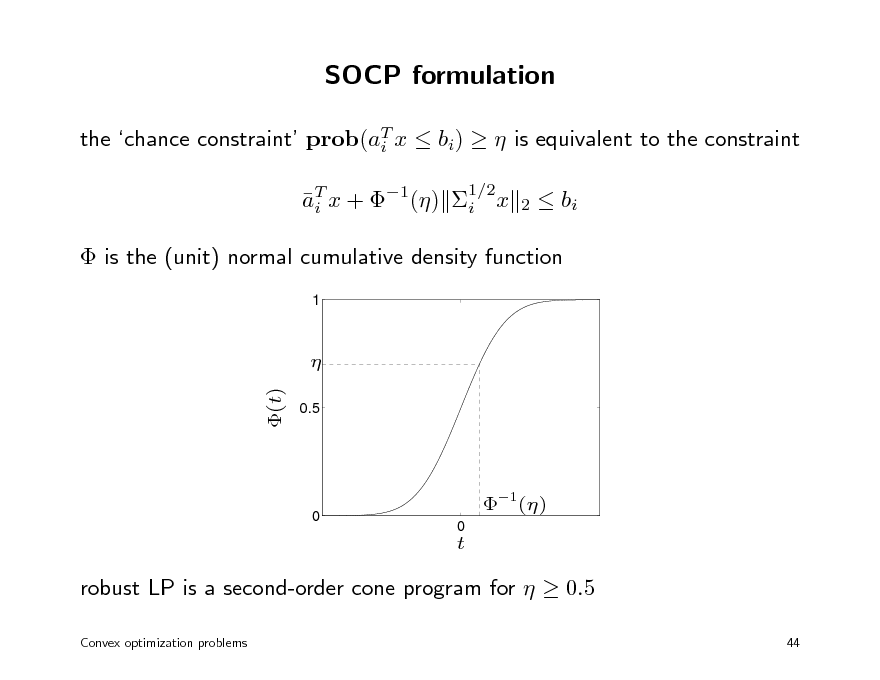
SOCP formulation
the chance constraint prob(aT x bi) is equivalent to the constraint i aT x + 1() i x i
1/2 2
bi
is the (unit) normal cumulative density function
1
(t)
0.5
0
1()
0
t
robust LP is a second-order cone program for 0.5
Convex optimization problems 44
48
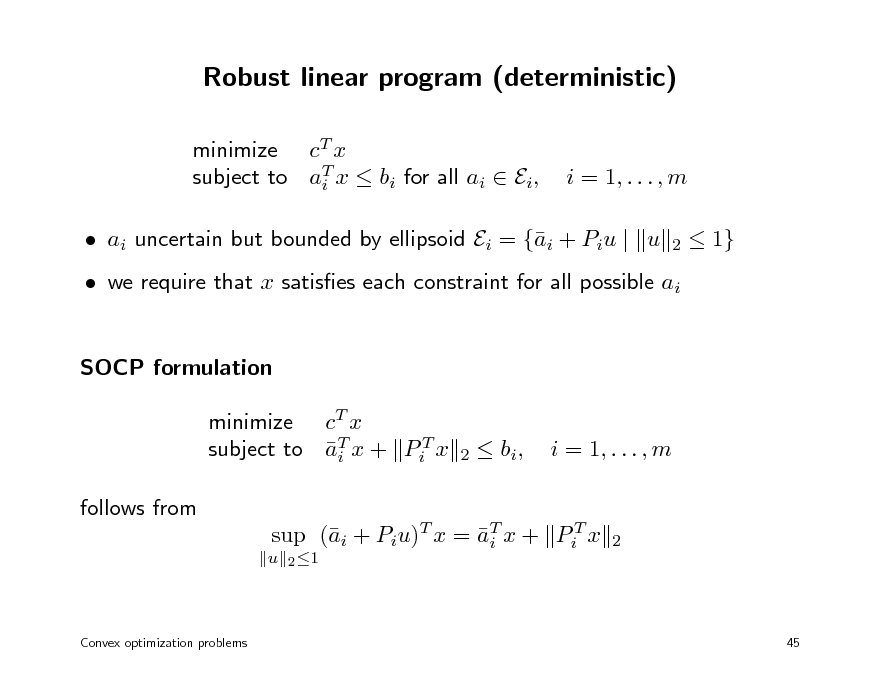
Robust linear program (deterministic)
minimize cT x subject to aT x bi for all ai Ei, i
i = 1, . . . , m
2
ai uncertain but bounded by ellipsoid Ei = {i + Piu | u a
1}
we require that x satises each constraint for all possible ai SOCP formulation minimize cT x subject to aT x + PiT x i follows from
u 2 1
2
bi ,
i = 1, . . . , m
sup (i + Piu)T x = aT x + PiT x a i
2
Convex optimization problems
45
49
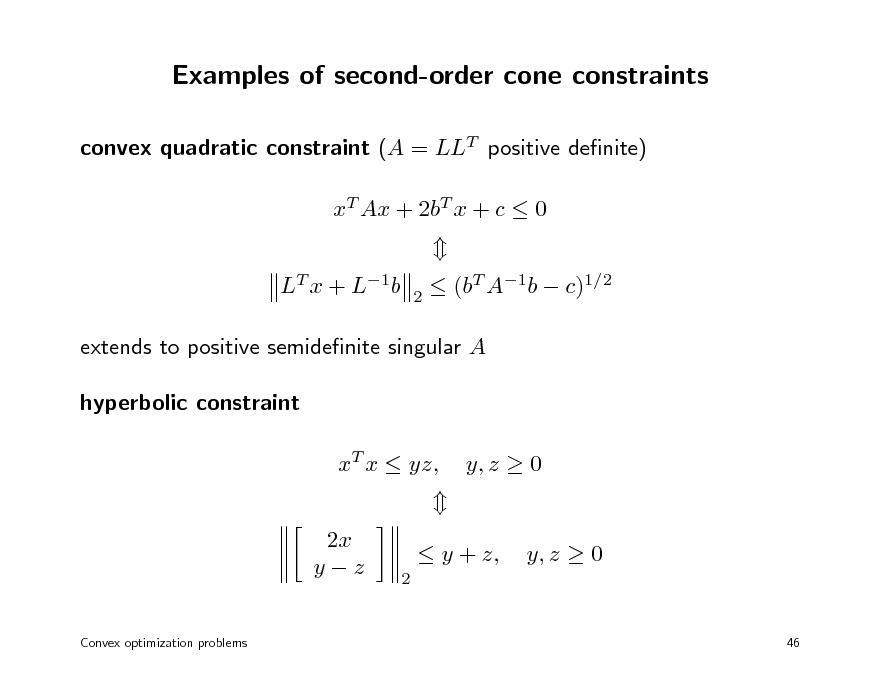
Examples of second-order cone constraints
convex quadratic constraint (A = LLT positive denite) xT Ax + 2bT x + c 0 LT x + L1b
2
(bT A1b c)1/2
extends to positive semidenite singular A hyperbolic constraint xT x yz, 2x yz
Convex optimization problems
y, z 0 y, z 0
46
2
y + z,
50
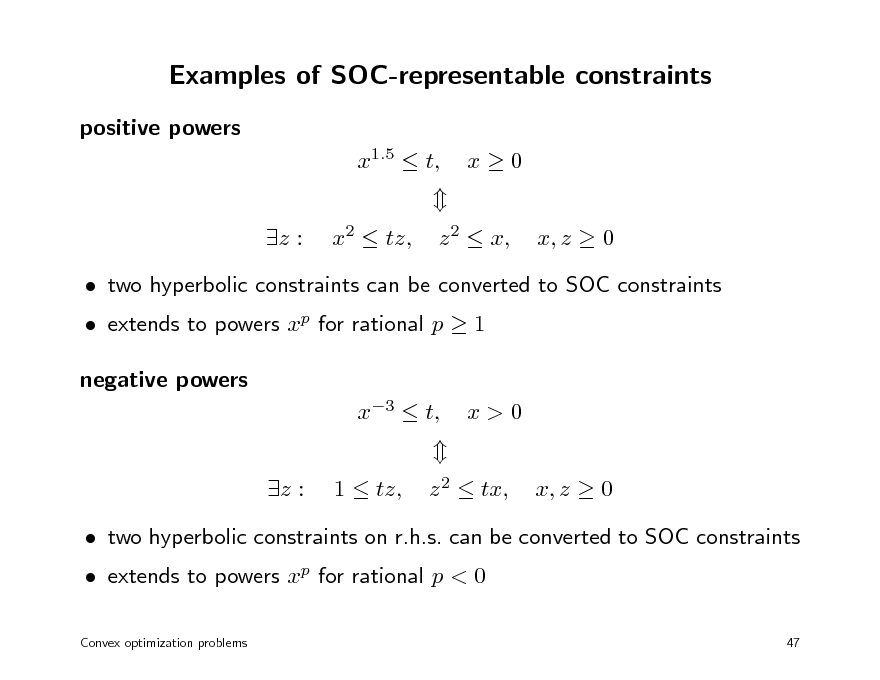
Examples of SOC-representable constraints
positive powers x1.5 t, z : x2 tz, x0 x, z 0
z 2 x,
extends to powers xp for rational p 1 negative powers x3 t, z : 1 tz,
two hyperbolic constraints can be converted to SOC constraints
x>0 x, z 0
z 2 tx,
extends to powers xp for rational p < 0
Convex optimization problems
two hyperbolic constraints on r.h.s. can be converted to SOC constraints
47
51
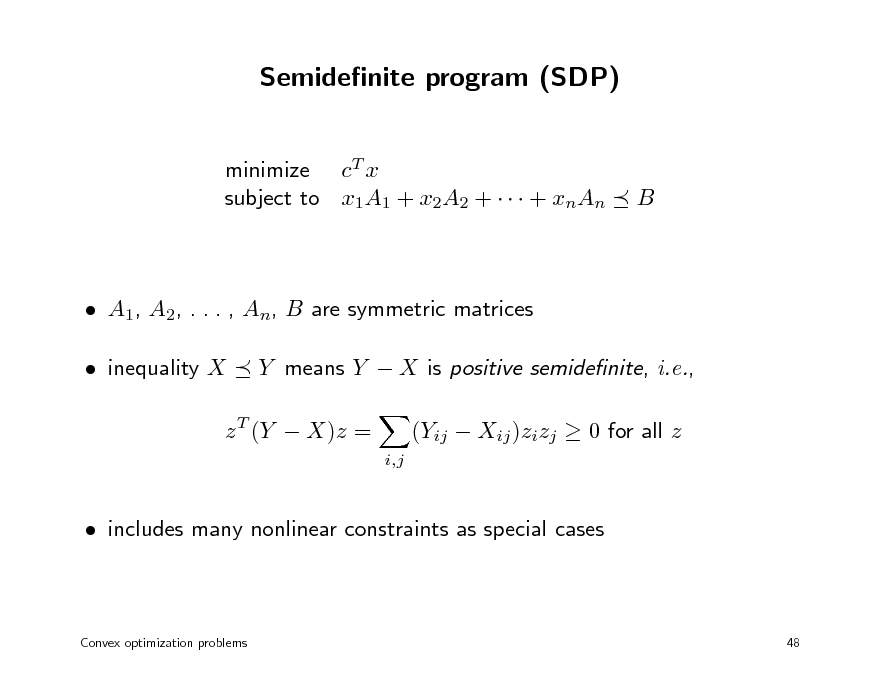
Semidenite program (SDP)
minimize cT x subject to x1A1 + x2A2 + + xnAn
B
A1, A2, . . . , An, B are symmetric matrices inequality X Y means Y X is positive semidenite, i.e.,
i,j
z T (Y X)z =
(Yij Xij )zizj 0 for all z
includes many nonlinear constraints as special cases
Convex optimization problems
48
52
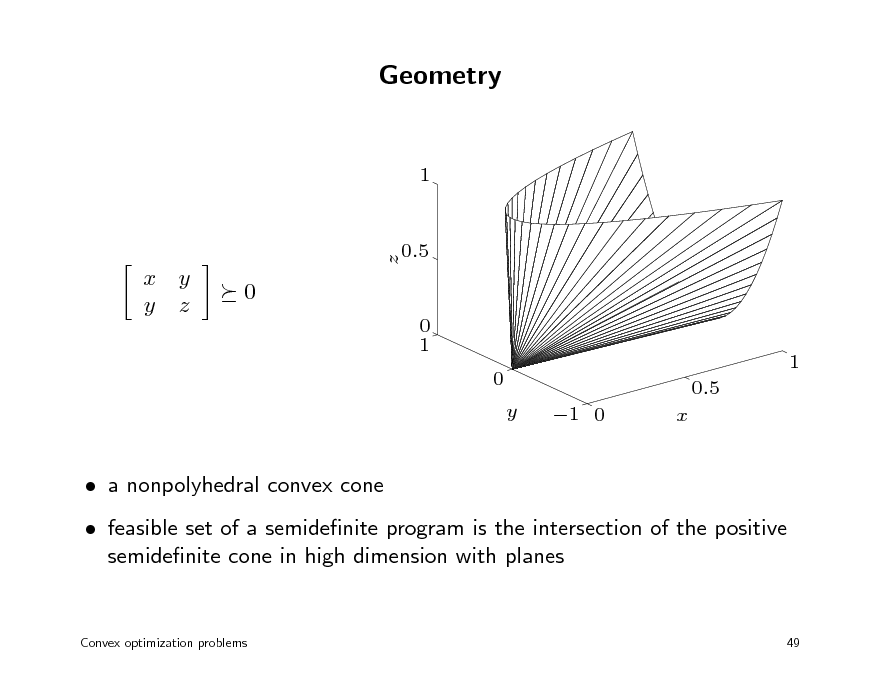
Geometry
1
x y y z
0
0 1 0 y 1 0 x 0.5 1
a nonpolyhedral convex cone feasible set of a semidenite program is the intersection of the positive semidenite cone in high dimension with planes
Convex optimization problems
z
0.5
49
53
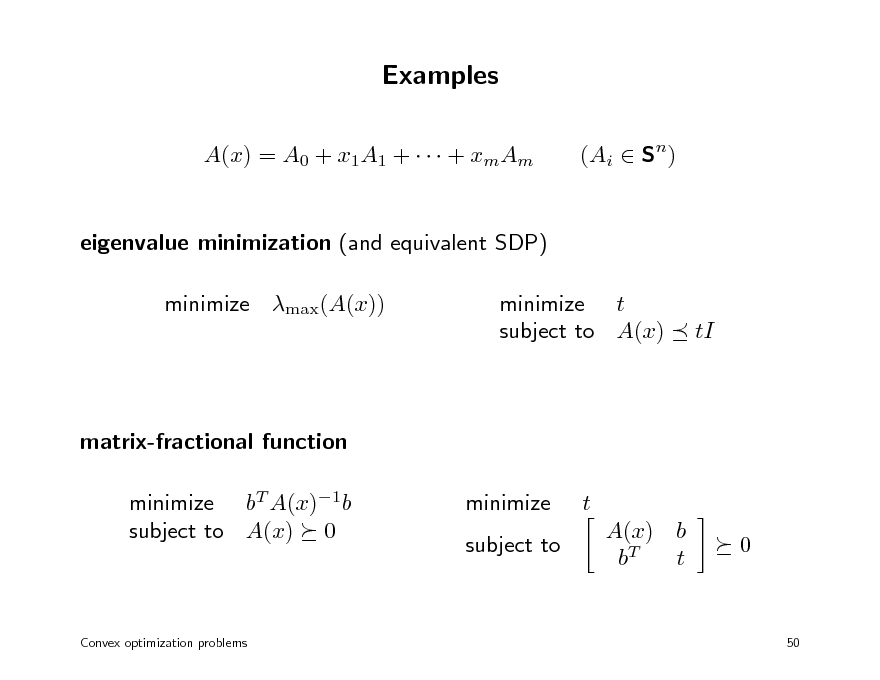
Examples
A(x) = A0 + x1A1 + + xmAm eigenvalue minimization (and equivalent SDP) minimize max(A(x)) minimize t subject to A(x) (Ai Sn)
tI
matrix-fractional function minimize bT A(x)1b subject to A(x) 0 minimize subject to t A(x) b bT t 0
Convex optimization problems
50
54
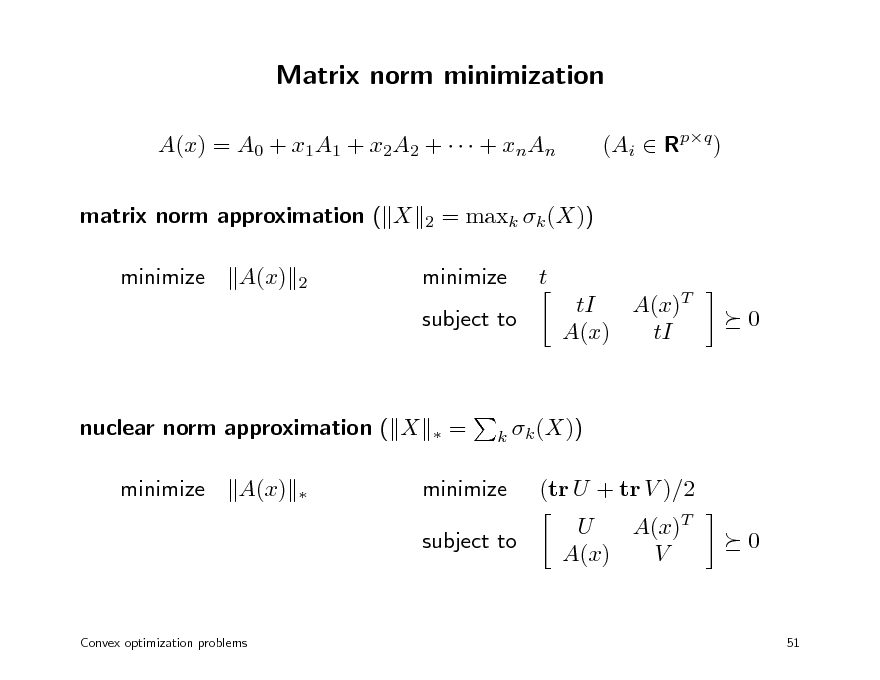
Matrix norm minimization
A(x) = A0 + x1A1 + x2A2 + + xnAn matrix norm approximation ( X minimize A(x)
2 2
(Ai Rpq )
= maxk k (X)) t tI A(x)T A(x) tI 0
minimize subject to
nuclear norm approximation ( X minimize A(x)
=
k k (X))
minimize subject to
(tr U + tr V )/2 U A(x)T A(x) V 0
Convex optimization problems
51
55
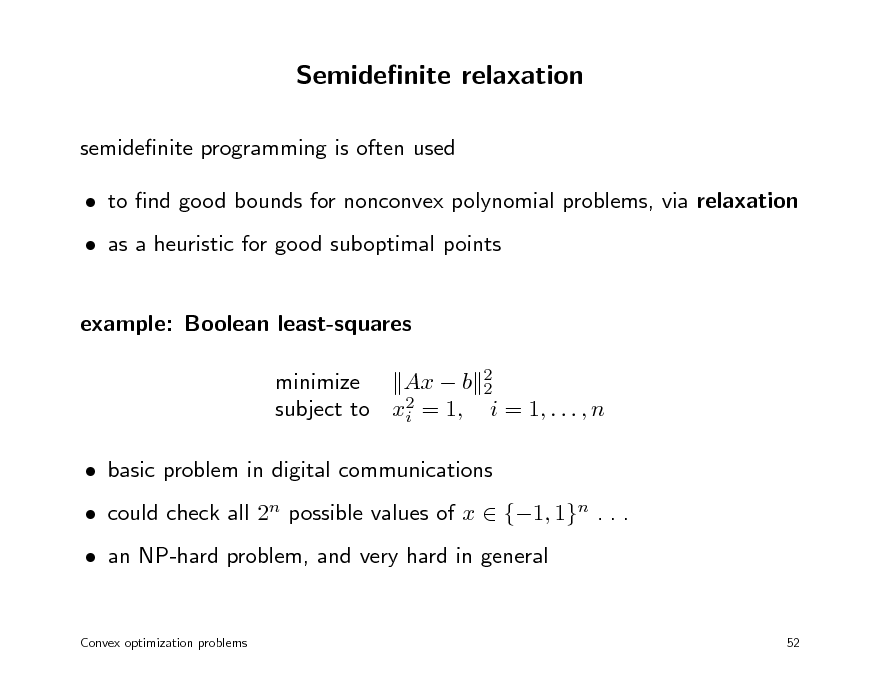
Semidenite relaxation
semidenite programming is often used to nd good bounds for nonconvex polynomial problems, via relaxation as a heuristic for good suboptimal points example: Boolean least-squares minimize Ax b 2 2 2 subject to xi = 1, i = 1, . . . , n basic problem in digital communications could check all 2n possible values of x {1, 1}n . . . an NP-hard problem, and very hard in general
Convex optimization problems 52
56
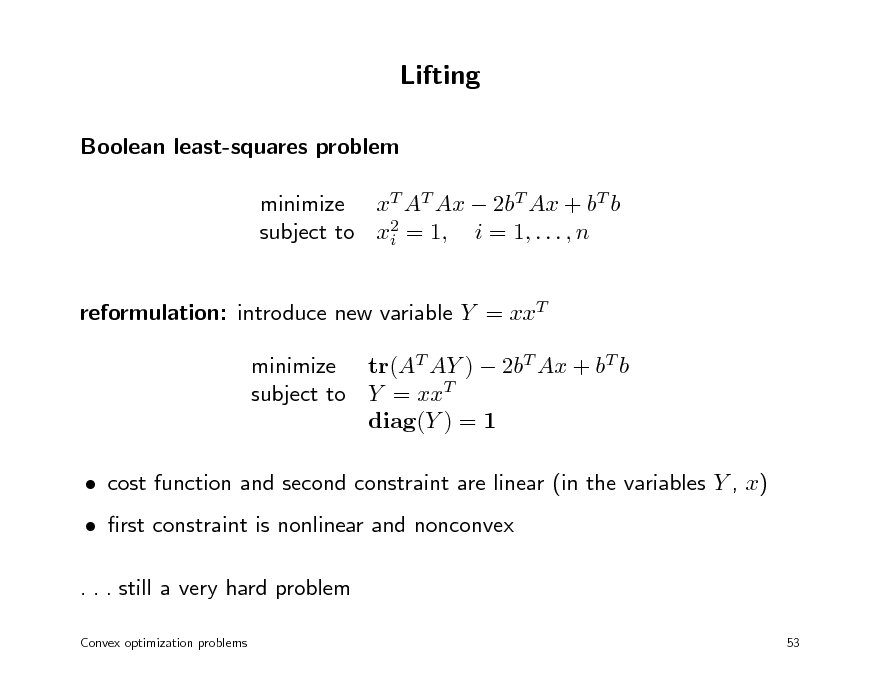
Lifting
Boolean least-squares problem minimize xT AT Ax 2bT Ax + bT b subject to x2 = 1, i = 1, . . . , n i reformulation: introduce new variable Y = xxT minimize tr(AT AY ) 2bT Ax + bT b subject to Y = xxT diag(Y ) = 1 cost function and second constraint are linear (in the variables Y , x) rst constraint is nonlinear and nonconvex . . . still a very hard problem
Convex optimization problems 53
57
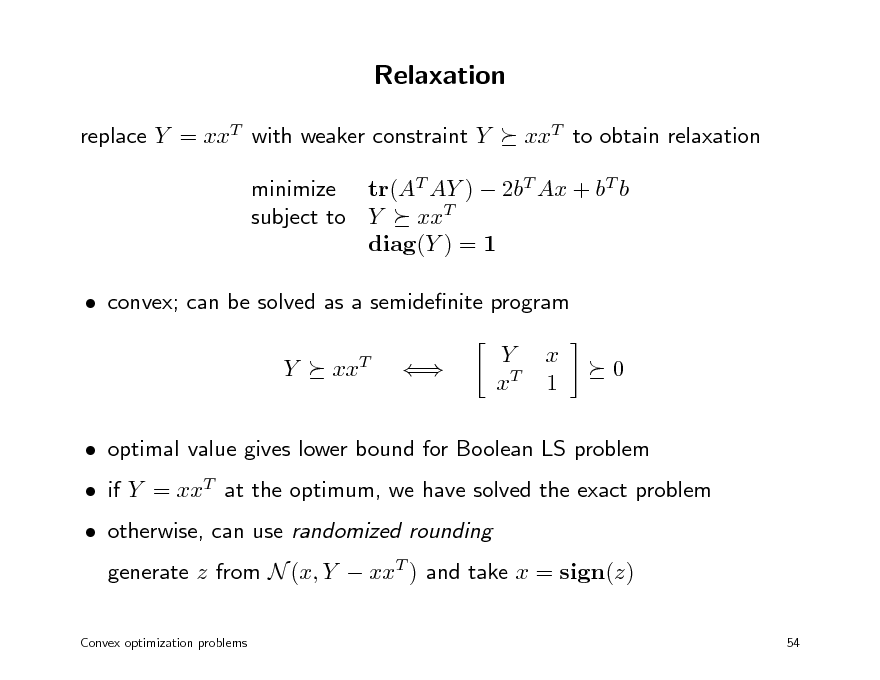
Relaxation
replace Y = xxT with weaker constraint Y xxT to obtain relaxation
minimize tr(AT AY ) 2bT Ax + bT b subject to Y xxT diag(Y ) = 1 convex; can be solved as a semidenite program Y xxT Y xT x 1 0
if Y = xxT at the optimum, we have solved the exact problem otherwise, can use randomized rounding generate z from N (x, Y xxT ) and take x = sign(z)
54
optimal value gives lower bound for Boolean LS problem
Convex optimization problems
58
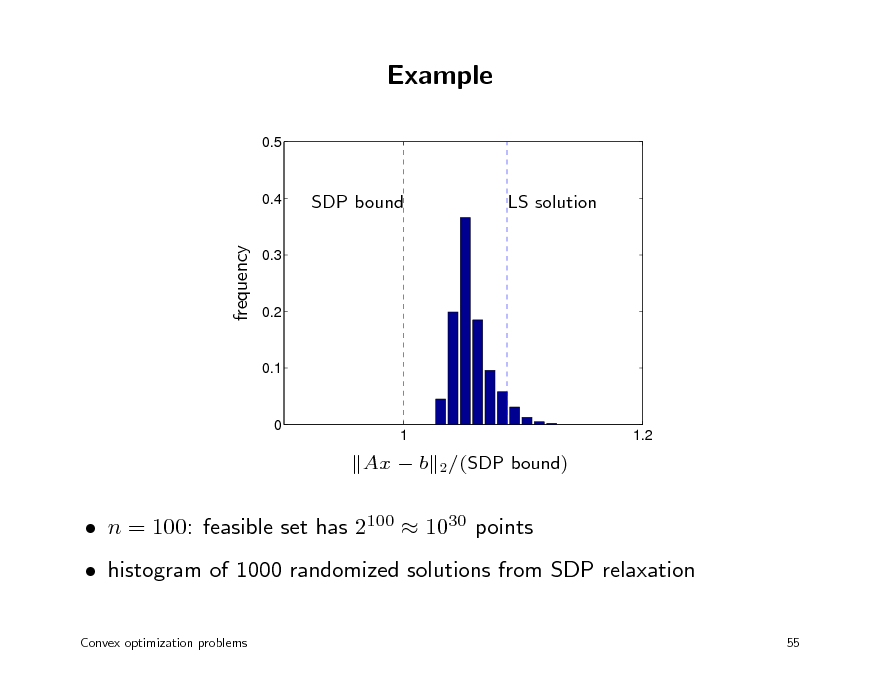
Example
0.5
0.4
SDP bound
LS solution
frequency
0.3
0.2
0.1
0
1
1.2
2 /(SDP
Ax b
bound)
n = 100: feasible set has 2100 1030 points histogram of 1000 randomized solutions from SDP relaxation
Convex optimization problems 55
59
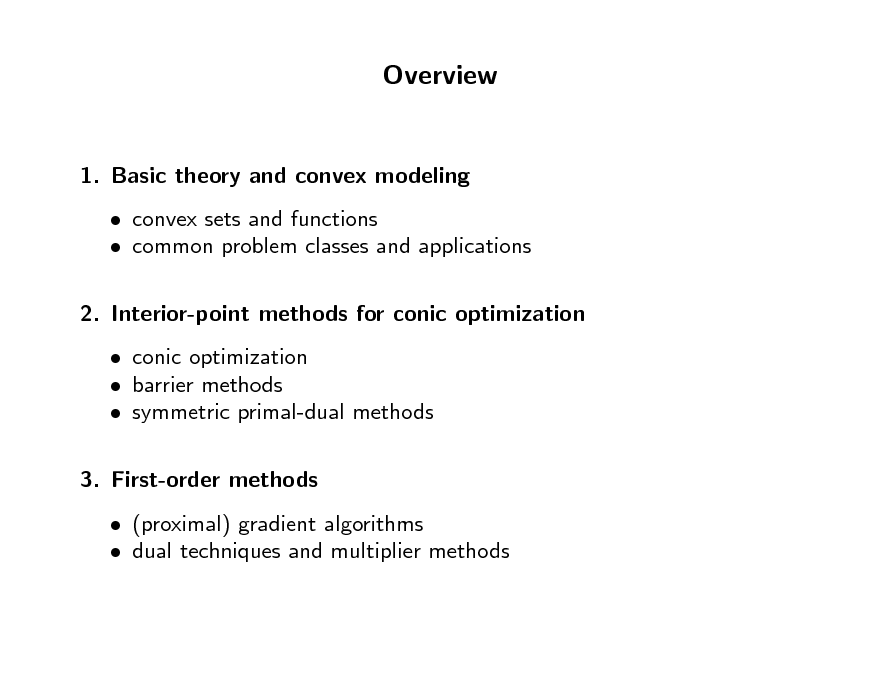
Overview
1. Basic theory and convex modeling convex sets and functions common problem classes and applications 2. Interior-point methods for conic optimization conic optimization barrier methods symmetric primal-dual methods 3. First-order methods (proximal) gradient algorithms dual techniques and multiplier methods
60
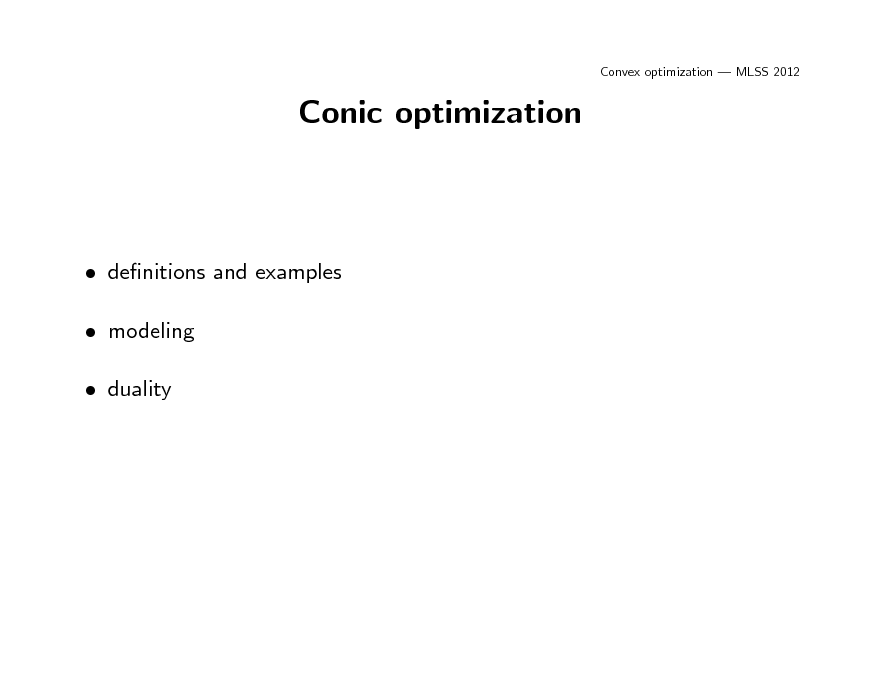
Convex optimization MLSS 2012
Conic optimization
denitions and examples modeling duality
61
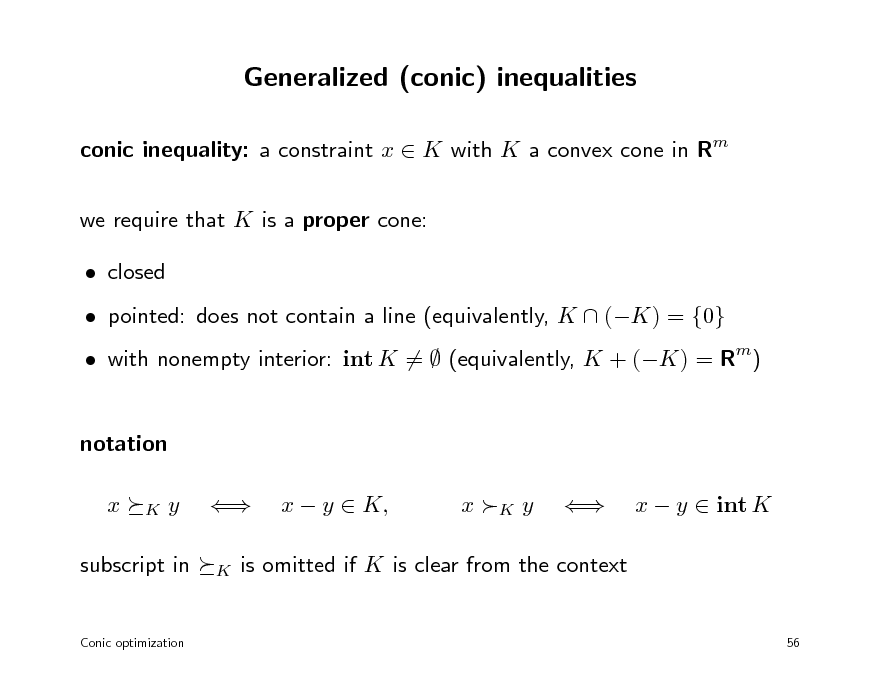
Generalized (conic) inequalities
conic inequality: a constraint x K with K a convex cone in Rm we require that K is a proper cone: closed pointed: does not contain a line (equivalently, K (K) = {0} with nonempty interior: int K = (equivalently, K + (K) = Rm)
notation x
K
y
K
x y K,
x K y
x y int K
subscript in
is omitted if K is clear from the context
Conic optimization
56
62
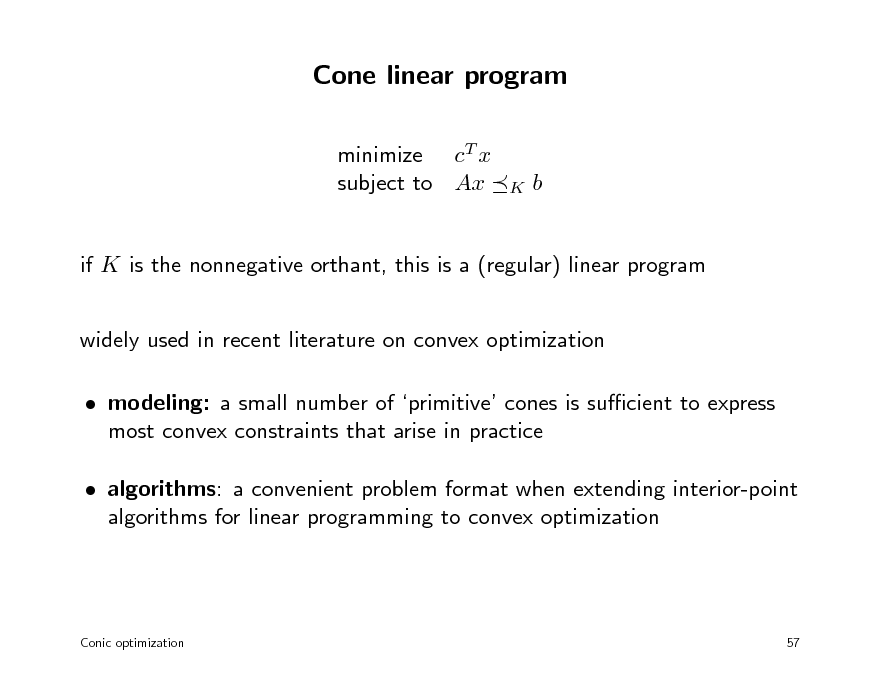
Cone linear program
minimize cT x subject to Ax
K
b
if K is the nonnegative orthant, this is a (regular) linear program widely used in recent literature on convex optimization modeling: a small number of primitive cones is sucient to express most convex constraints that arise in practice algorithms: a convenient problem format when extending interior-point algorithms for linear programming to convex optimization
Conic optimization
57
63
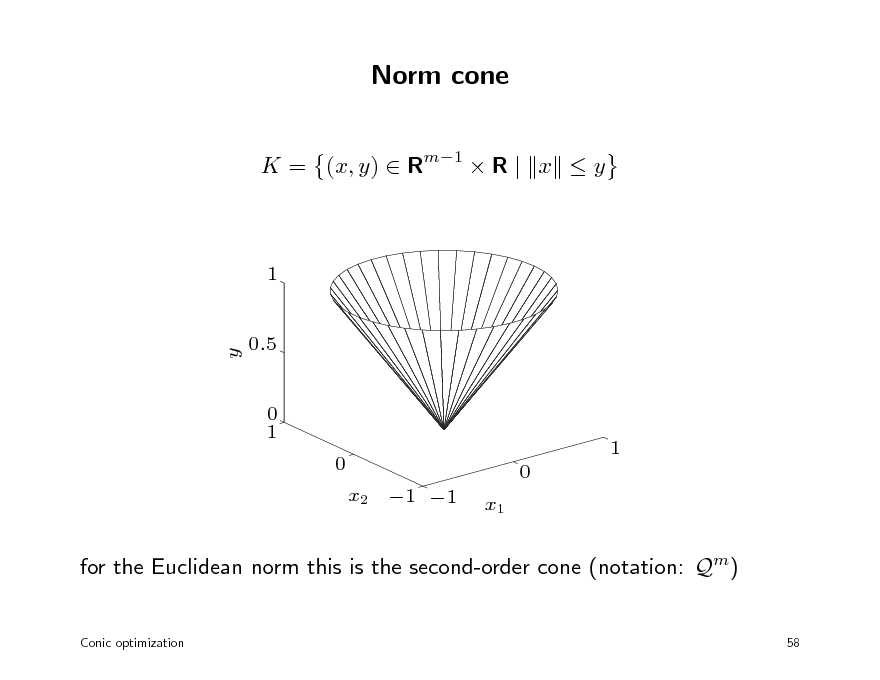
Norm cone
K = (x, y) Rm1 R | x y
1
y
0.5
0 1 0 x2 1 1 x1 0
1
for the Euclidean norm this is the second-order cone (notation: Qm)
Conic optimization 58
64
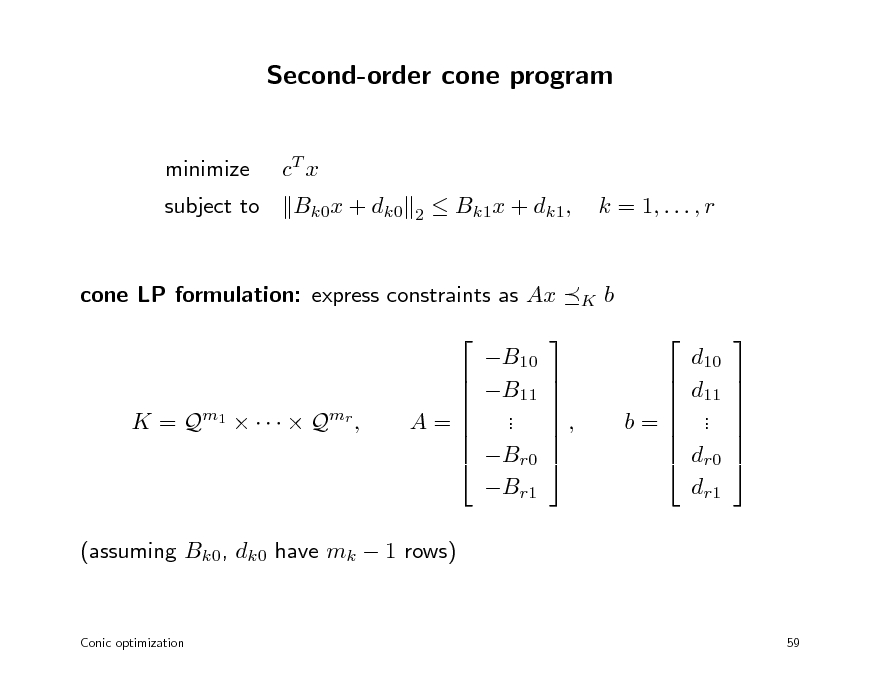
Second-order cone program
minimize subject to cT x Bk0x + dk0
2
Bk1x + dk1,
k = 1, . . . , r
cone LP formulation: express constraints as Ax B10 B11 . . Br0 Br1
K
b d10 d11 . . dr0 dr1
K = Q m1 Q mr ,
A=
,
b=
(assuming Bk0, dk0 have mk 1 rows)
Conic optimization
59
65
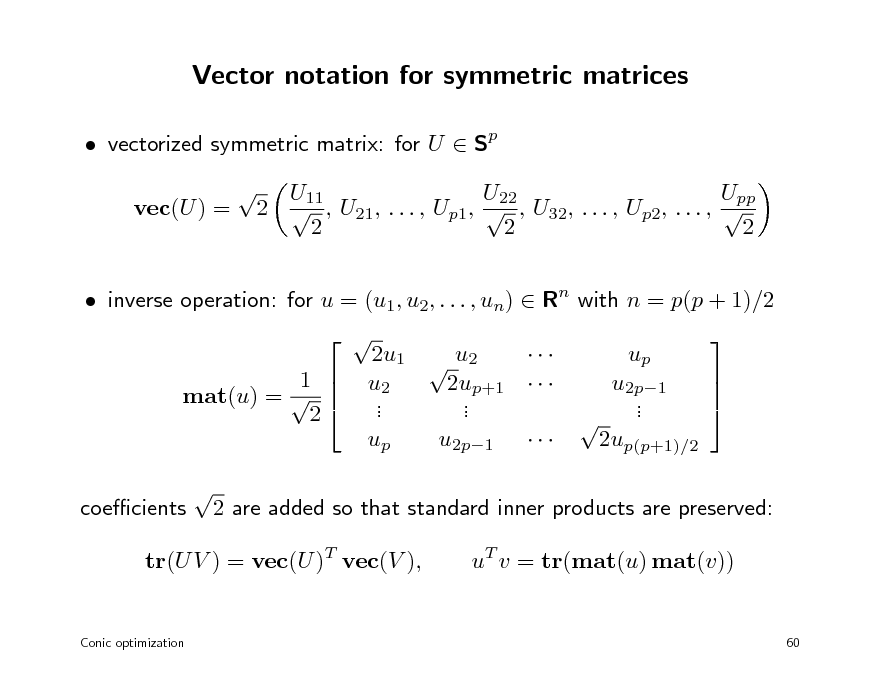
Vector notation for symmetric matrices
vectorized symmetric matrix: for U Sp vec(U ) = U11 U22 Upp 2 , U21, . . . , Up1, , U32, . . . , Up2, . . . , 2 2 2
inverse operation: for u = (u1, u2, . . . , un) Rn with n = p(p + 1)/2 1 mat(u) = 2 coecients 2u1 u2 u2 2up+1 . . . . up u2p1 up u2p1 . . 2up(p+1)/2
2 are added so that standard inner products are preserved: uT v = tr(mat(u) mat(v))
tr(U V ) = vec(U )T vec(V ),
Conic optimization
60
66
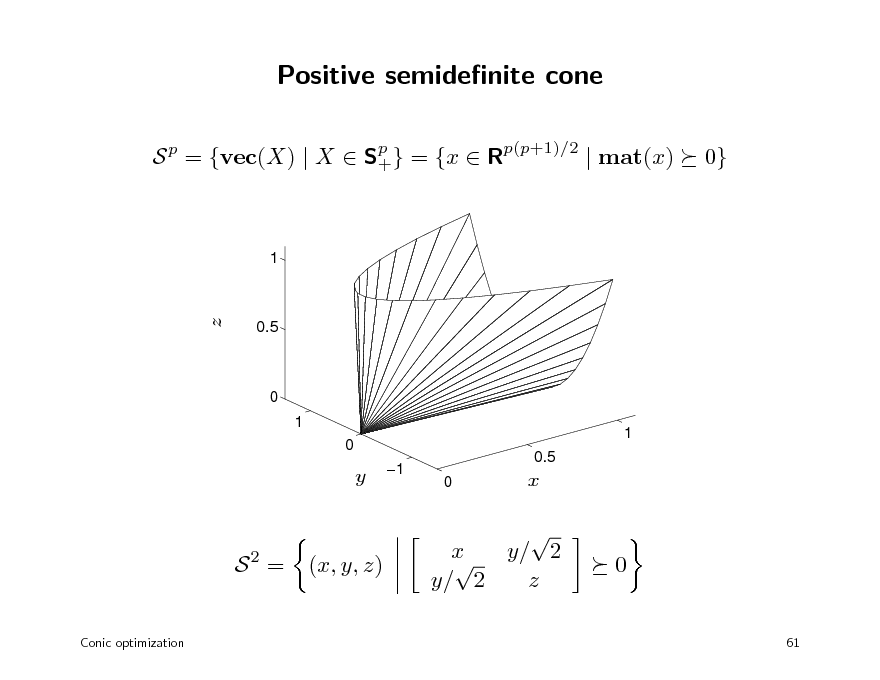
Positive semidenite cone
S p = {vec(X) | X Sp } = {x Rp(p+1)/2 | mat(x) + 0}
1
z
0.5
0 1 0 1
y
1
0.5 0
x
S2 =
Conic optimization
(x, y, z)
x y/ 2 y/ 2 z
0
61
67
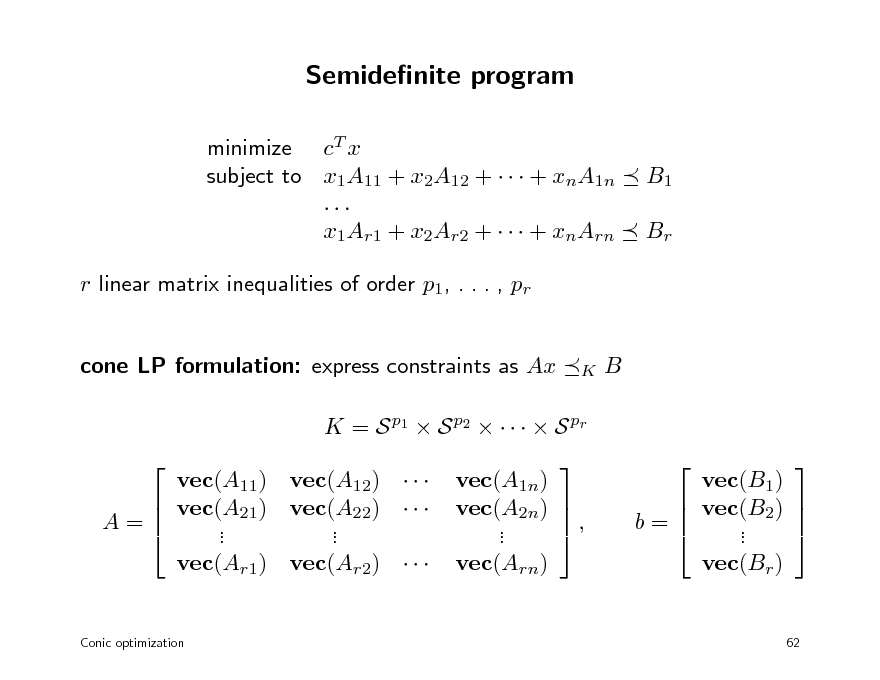
Semidenite program
minimize cT x subject to x1A11 + x2A12 + + xnA1n ... x1Ar1 + x2Ar2 + + xnArn r linear matrix inequalities of order p1, . . . , pr cone LP formulation: express constraints as Ax B
B1 Br
K
K = S p1 S p2 S pr vec(A11) vec(A12) vec(A21) vec(A22) A= . . . . vec(Ar1) vec(Ar2)
Conic optimization
vec(A1n) vec(A2n) , . . vec(Arn)
vec(B1) vec(B2) b= . . vec(Br )
62
68
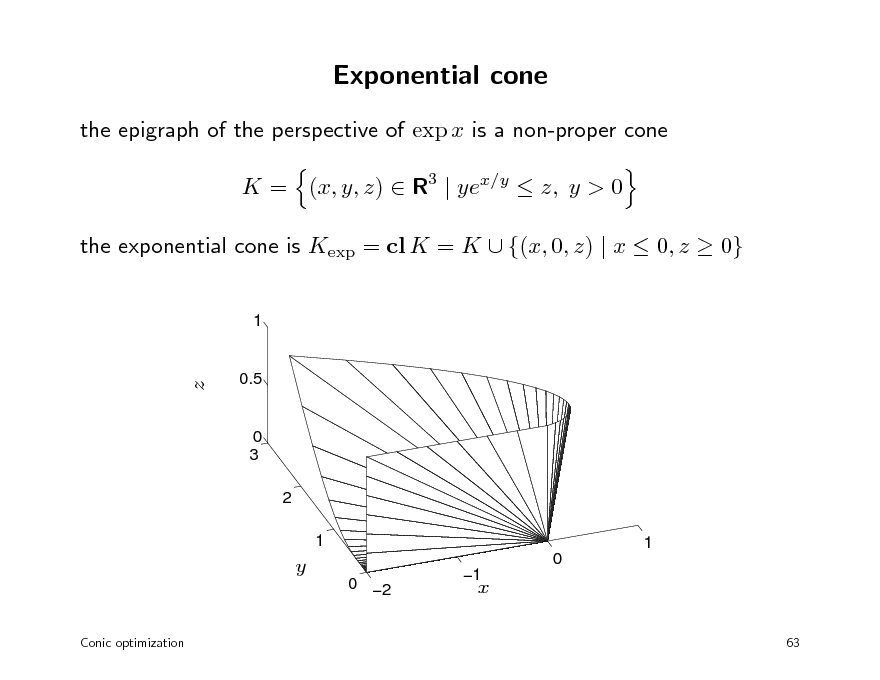
Exponential cone
the epigraph of the perspective of exp x is a non-proper cone K = (x, y, z) R3 | yex/y z, y > 0 the exponential cone is Kexp = cl K = K {(x, 0, z) | x 0, z 0}
1
z
0.5
0 3 2 1 1 0 0 2
Conic optimization
y
1
x
63
69
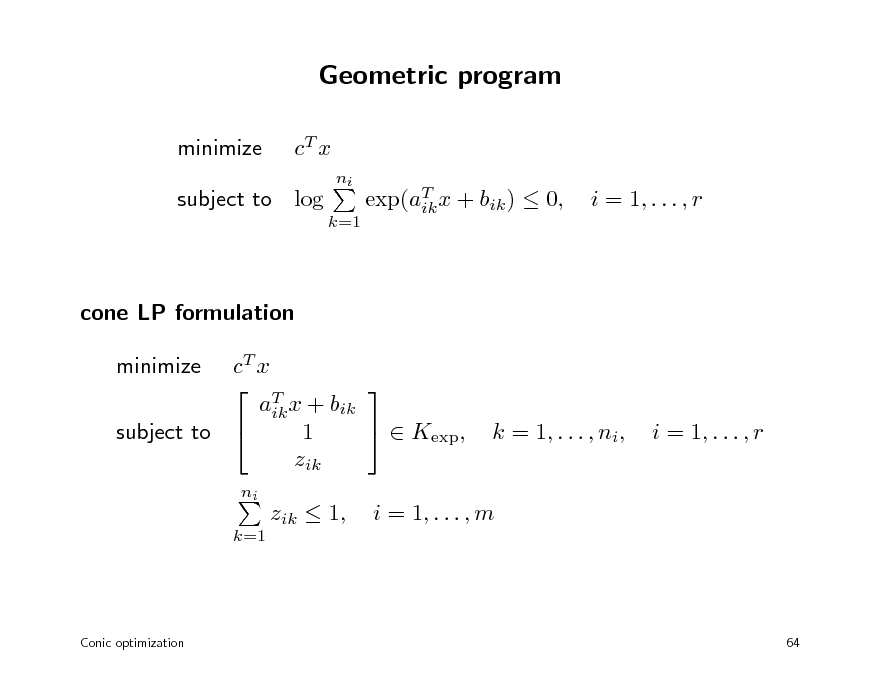
Geometric program
minimize cT x
ni k=1
subject to log
exp(aT x + bik ) 0, ik
i = 1, . . . , r
cone LP formulation cT x T aik x + bik Kexp, 1 subject to zik minimize
ni k=1
k = 1, . . . , ni,
i = 1, . . . , r
zik 1,
i = 1, . . . , m
Conic optimization
64
70
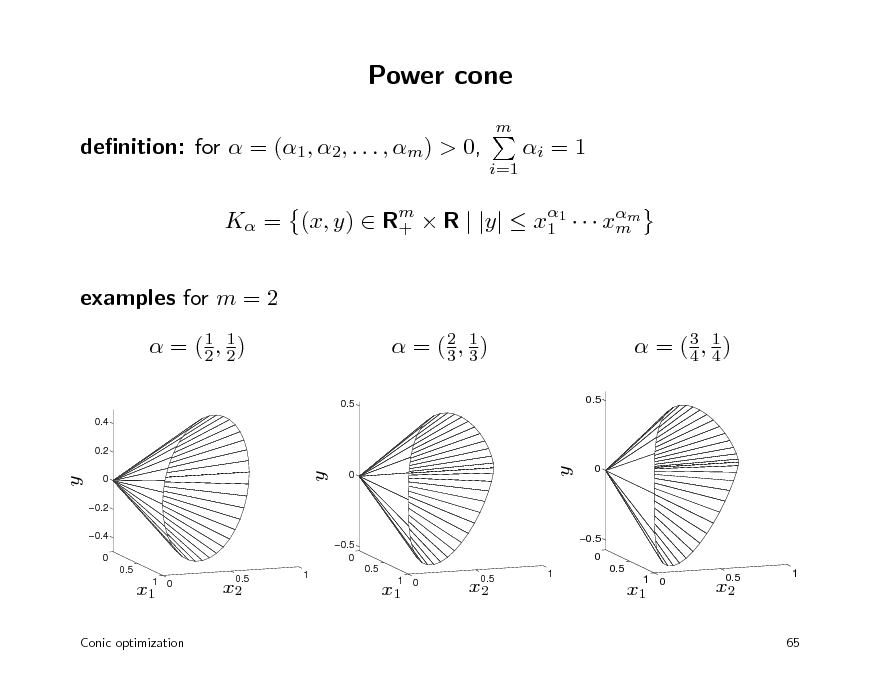
Power cone
m
denition: for = (1, 2, . . . , m) > 0,
i=1
i = 1
K = (x, y) Rm R | |y| x1 xmm + 1
examples for m = 2
1 = (1, 2) 2
0.5
0.4 0.2
1 = (2, 3) 3
0.5
3 1 = (4, 4)
y
0 0.2 0.4 0 0.5
y
0
y
0.5
0
0.5 0
0.5 0
1
x1
1 0
x2
0.5
1
0.5
x1
1 0
x2
0.5
x1
1 0
x2
0.5
1
Conic optimization
65
71
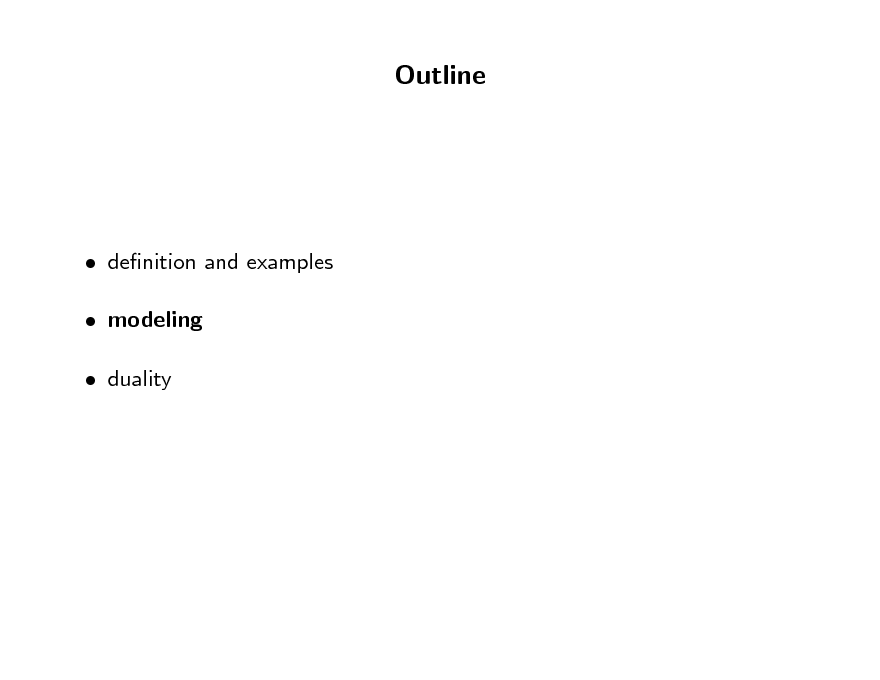
Outline
denition and examples modeling duality
72
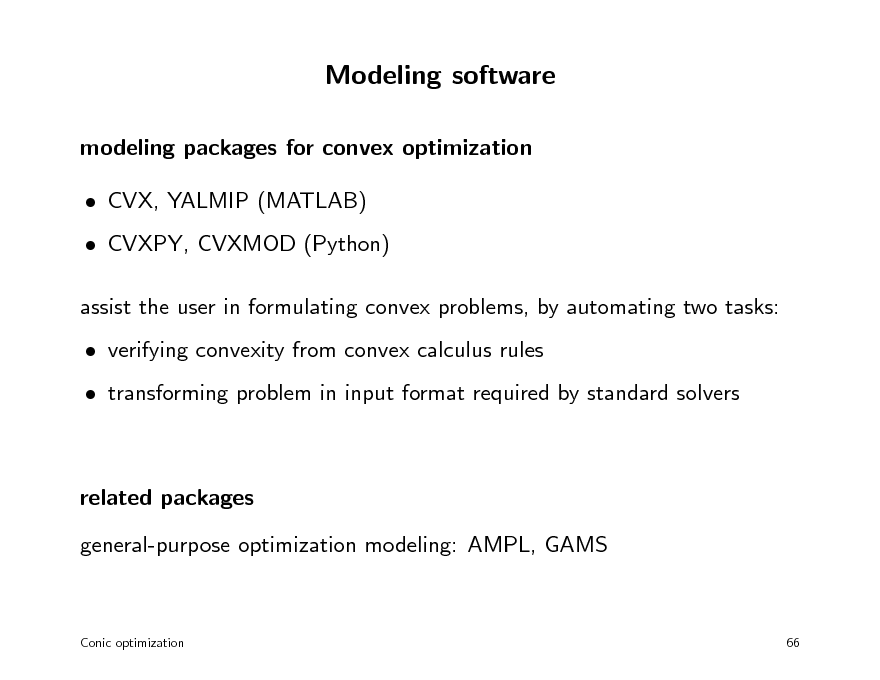
Modeling software
modeling packages for convex optimization CVX, YALMIP (MATLAB) CVXPY, CVXMOD (Python) assist the user in formulating convex problems, by automating two tasks: verifying convexity from convex calculus rules transforming problem in input format required by standard solvers
related packages general-purpose optimization modeling: AMPL, GAMS
Conic optimization
66
73
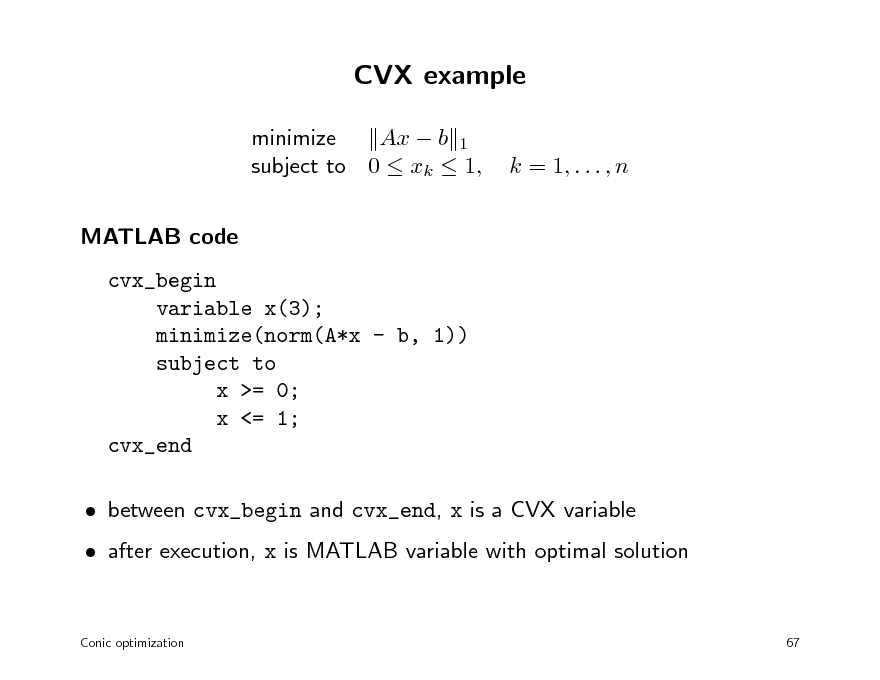
CVX example
minimize Ax b 1 subject to 0 xk 1, MATLAB code cvx_begin variable x(3); minimize(norm(A*x - b, 1)) subject to x >= 0; x <= 1; cvx_end between cvx_begin and cvx_end, x is a CVX variable after execution, x is MATLAB variable with optimal solution
Conic optimization 67
k = 1, . . . , n
74
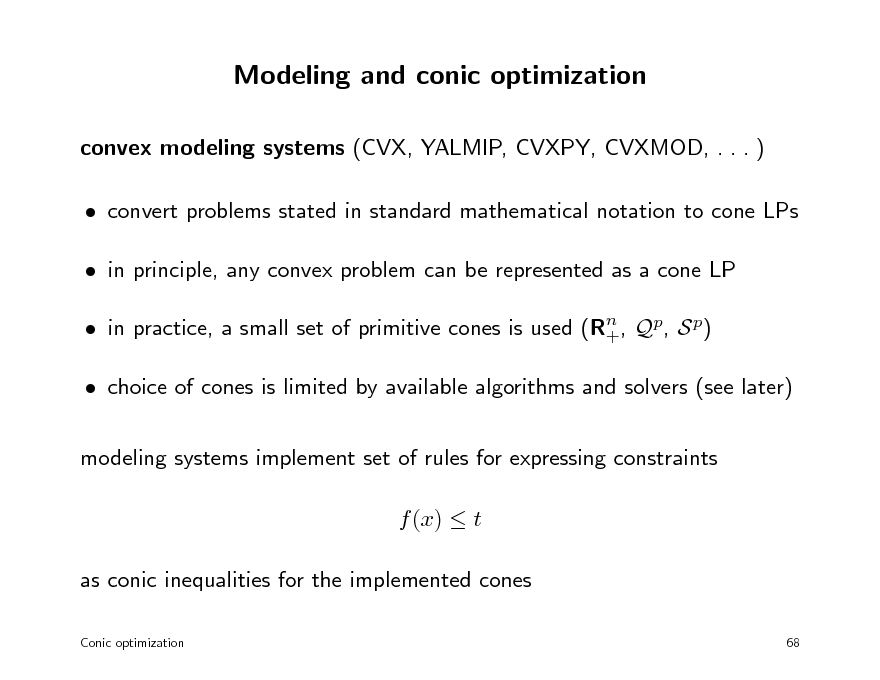
Modeling and conic optimization
convex modeling systems (CVX, YALMIP, CVXPY, CVXMOD, . . . ) convert problems stated in standard mathematical notation to cone LPs in principle, any convex problem can be represented as a cone LP in practice, a small set of primitive cones is used (Rn , Qp, S p) + choice of cones is limited by available algorithms and solvers (see later) modeling systems implement set of rules for expressing constraints f (x) t as conic inequalities for the implemented cones
Conic optimization 68
75
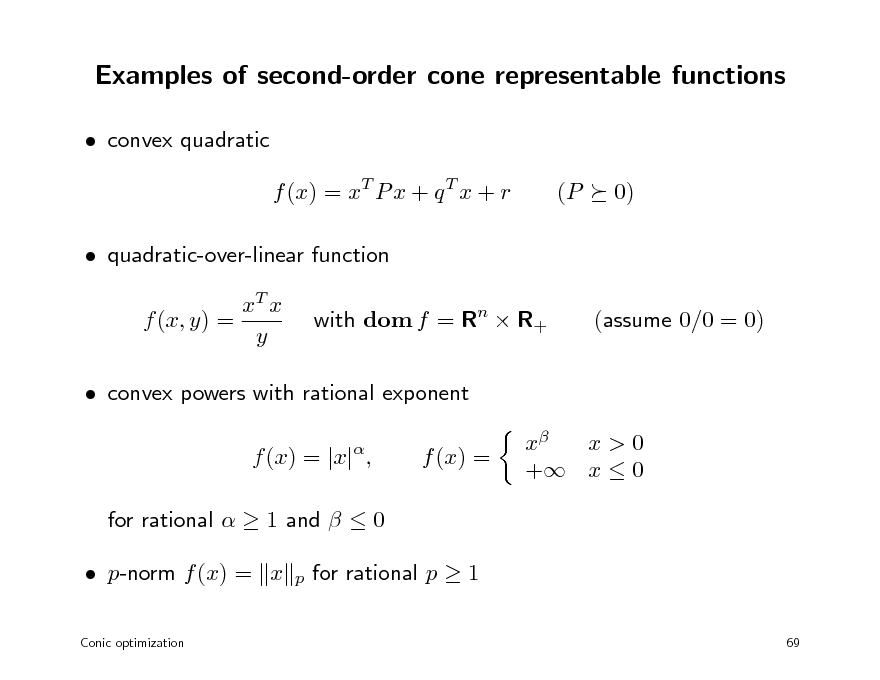
Examples of second-order cone representable functions
convex quadratic f (x) = xT P x + q T x + r quadratic-over-linear function xT x f (x, y) = y with dom f = Rn R+ (assume 0/0 = 0) (P 0)
convex powers with rational exponent f (x) = |x| , for rational 1 and 0 p-norm f (x) = x
Conic optimization
f (x) =
x x>0 + x 0
p
for rational p 1
69
76
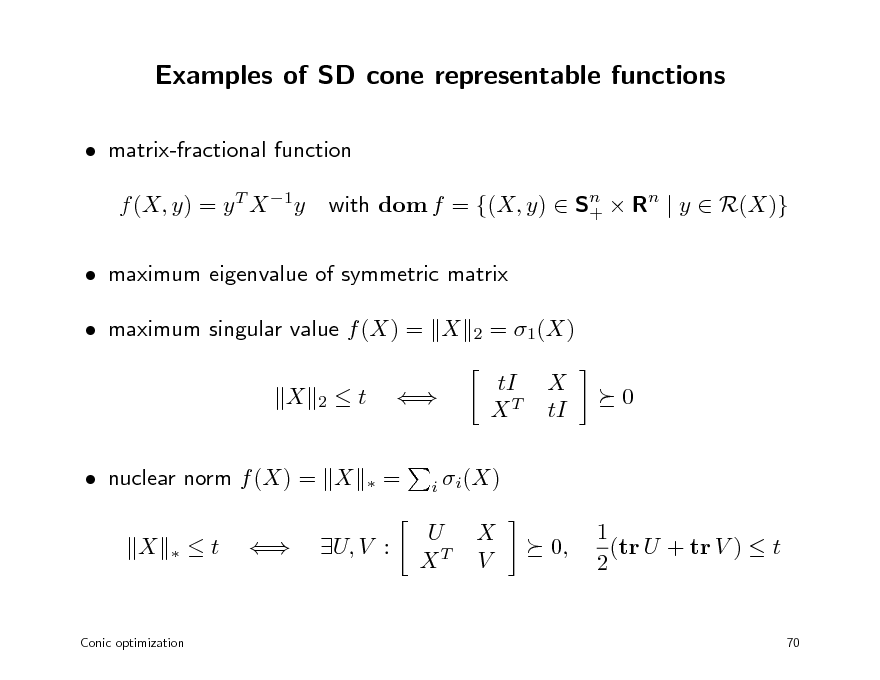
Examples of SD cone representable functions
matrix-fractional function f (X, y) = y T X 1y with dom f = {(X, y) Sn Rn | y R(X)} +
maximum eigenvalue of symmetric matrix maximum singular value f (X) = X X
2 2
= 1(X) tI XT X tI 0
t
=
nuclear norm f (X) = X X
i i (X)
t
U, V :
U XT
X V
0,
1 (tr U + tr V ) t 2
Conic optimization
70
77
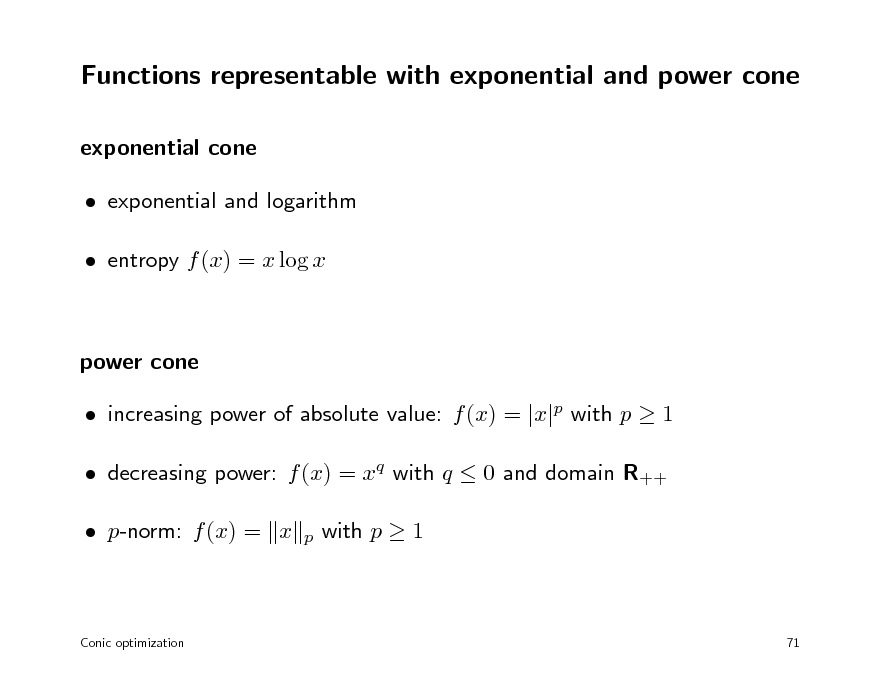
Functions representable with exponential and power cone
exponential cone exponential and logarithm entropy f (x) = x log x
power cone increasing power of absolute value: f (x) = |x|p with p 1 decreasing power: f (x) = xq with q 0 and domain R++ p-norm: f (x) = x
p
with p 1
Conic optimization
71
78
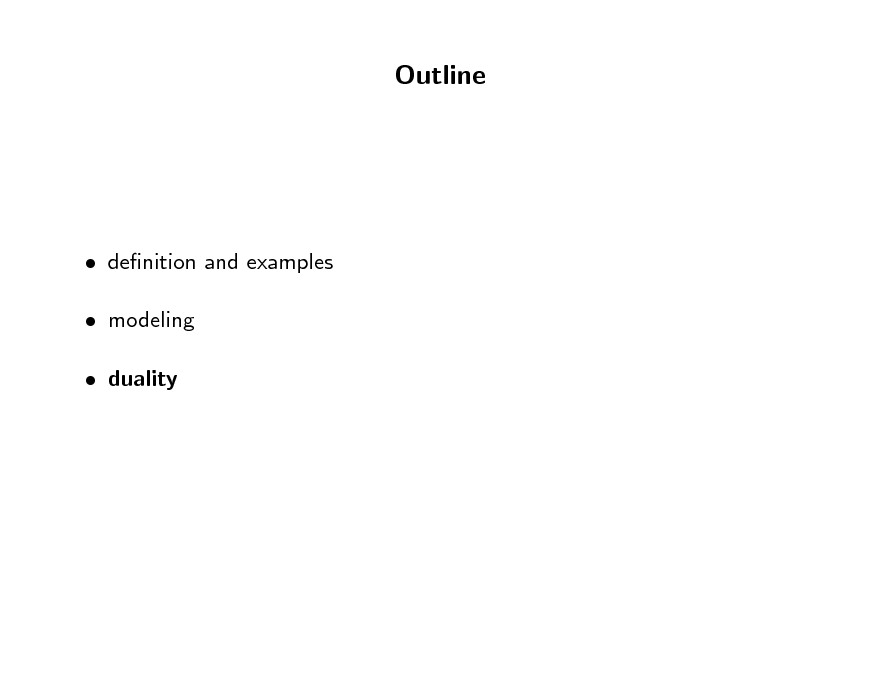
Outline
denition and examples modeling duality
79
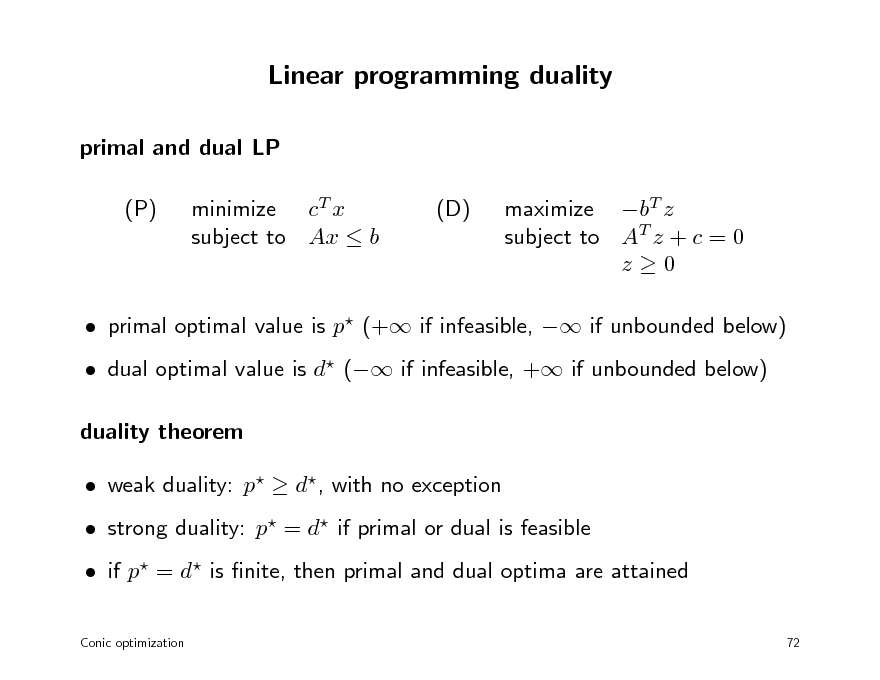
Linear programming duality
primal and dual LP (P) minimize cT x subject to Ax b (D) maximize bT z subject to AT z + c = 0 z0
primal optimal value is p (+ if infeasible, if unbounded below) dual optimal value is d ( if infeasible, + if unbounded below) duality theorem weak duality: p d, with no exception strong duality: p = d if primal or dual is feasible if p = d is nite, then primal and dual optima are attained
Conic optimization 72
80
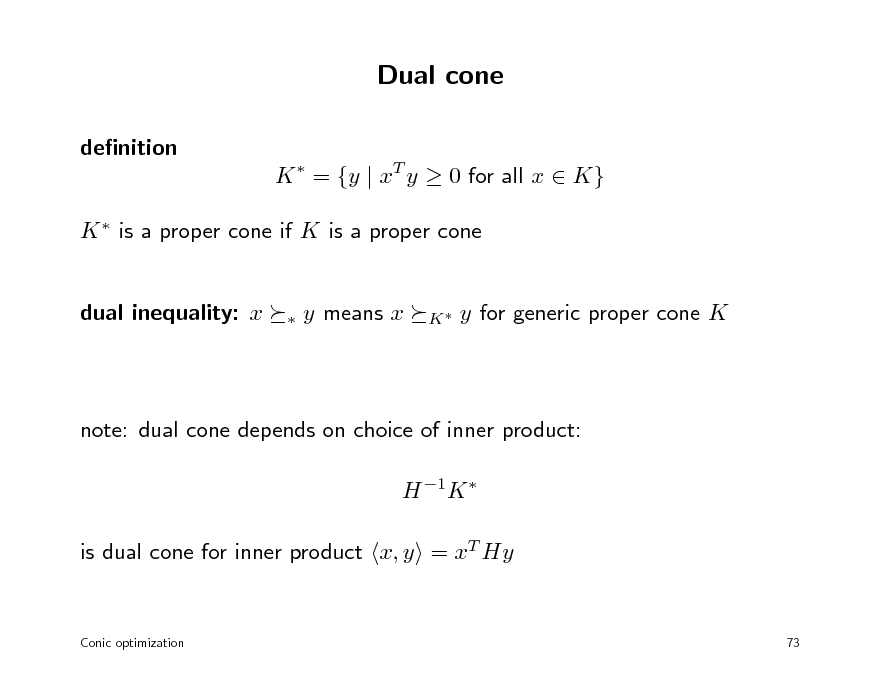
Dual cone
denition K = {y | xT y 0 for all x K} K is a proper cone if K is a proper cone
dual inequality: x
y means x
K
y for generic proper cone K
note: dual cone depends on choice of inner product: H 1K is dual cone for inner product x, y = xT Hy
Conic optimization
73
81
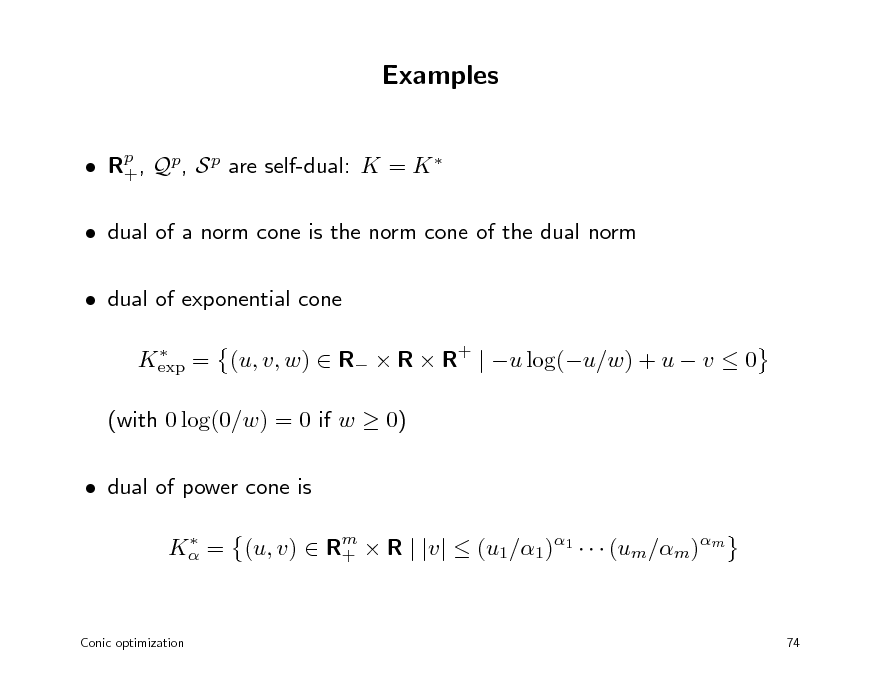
Examples
Rp , Qp, S p are self-dual: K = K + dual of a norm cone is the norm cone of the dual norm dual of exponential cone
Kexp = (u, v, w) R R R+ | u log(u/w) + u v 0
(with 0 log(0/w) = 0 if w 0) dual of power cone is
K = (u, v) Rm R | |v| (u1/1)1 (um/m)m +
Conic optimization
74
82
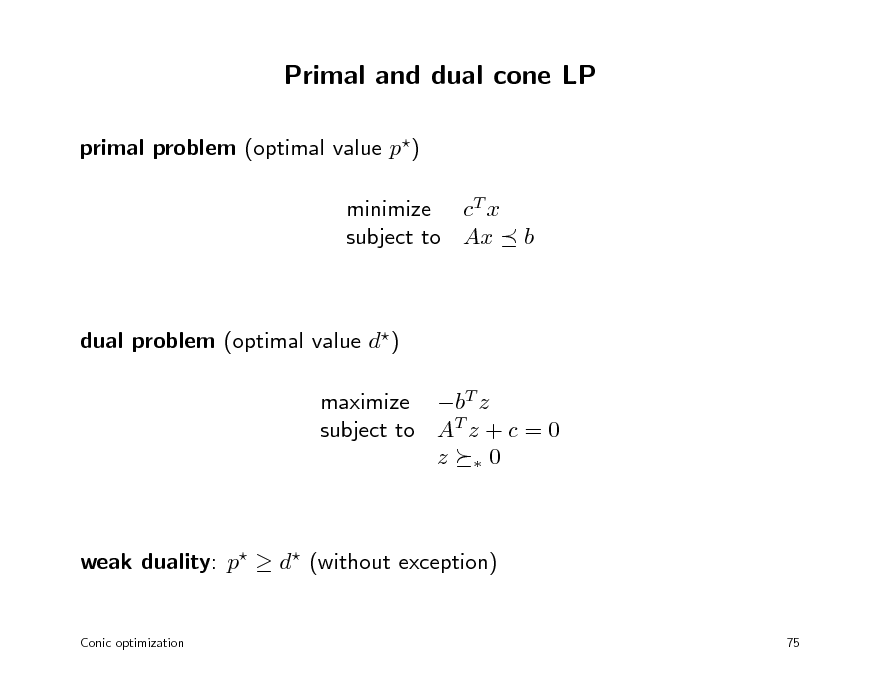
Primal and dual cone LP
primal problem (optimal value p) minimize cT x subject to Ax
b
dual problem (optimal value d) maximize bT z subject to AT z + c = 0 z 0
weak duality: p d (without exception)
Conic optimization 75
83
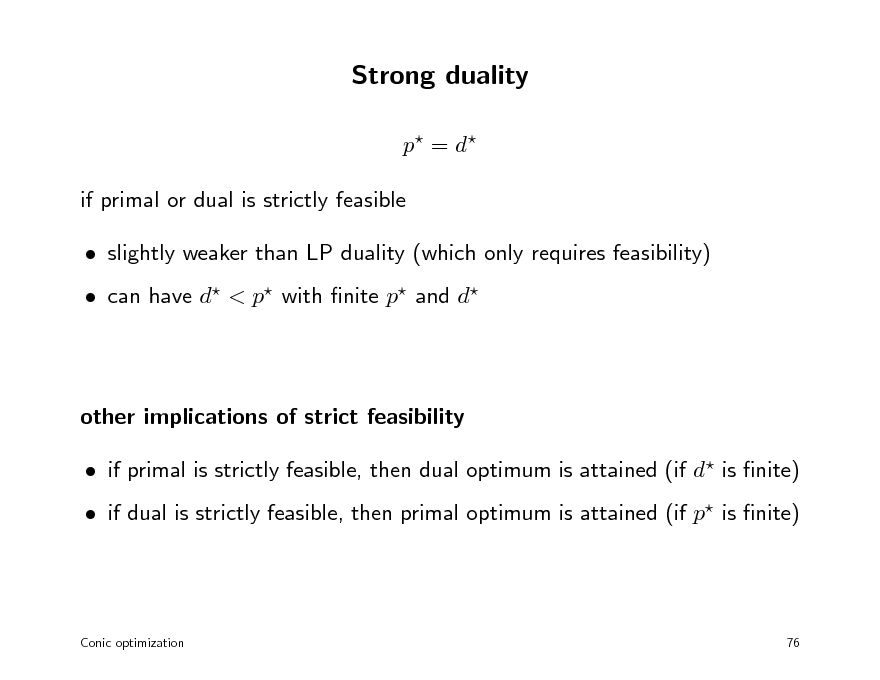
Strong duality
p = d if primal or dual is strictly feasible slightly weaker than LP duality (which only requires feasibility) can have d < p with nite p and d
other implications of strict feasibility if primal is strictly feasible, then dual optimum is attained (if d is nite) if dual is strictly feasible, then primal optimum is attained (if p is nite)
Conic optimization
76
84
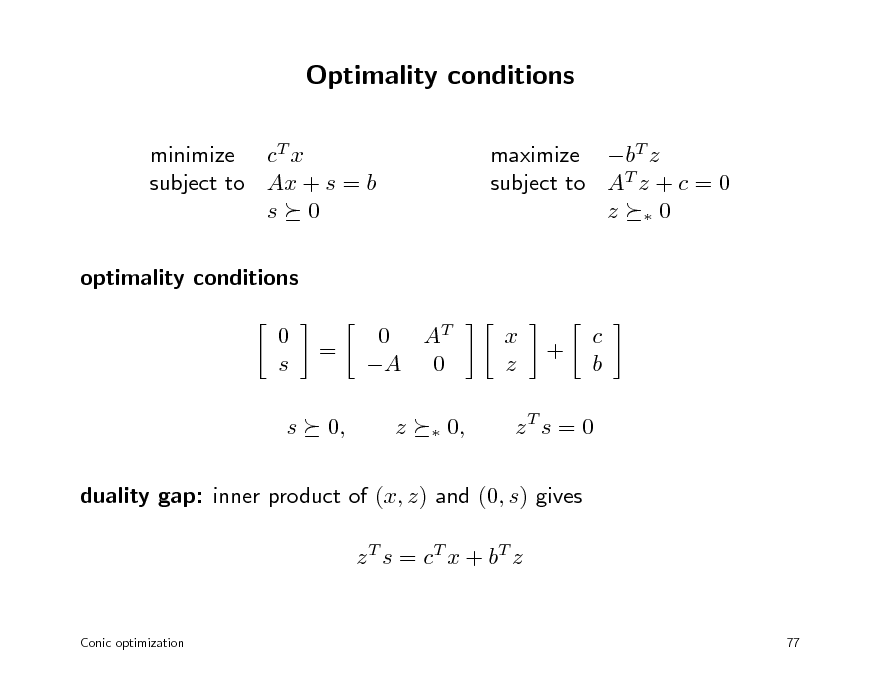
Optimality conditions
minimize cT x subject to Ax + s = b s 0 optimality conditions 0 s s = 0, 0 AT A 0 z
maximize bT z subject to AT z + c = 0 z 0
x z
+
c b
0,
zT s = 0
duality gap: inner product of (x, z) and (0, s) gives z T s = c T x + bT z
Conic optimization
77
85
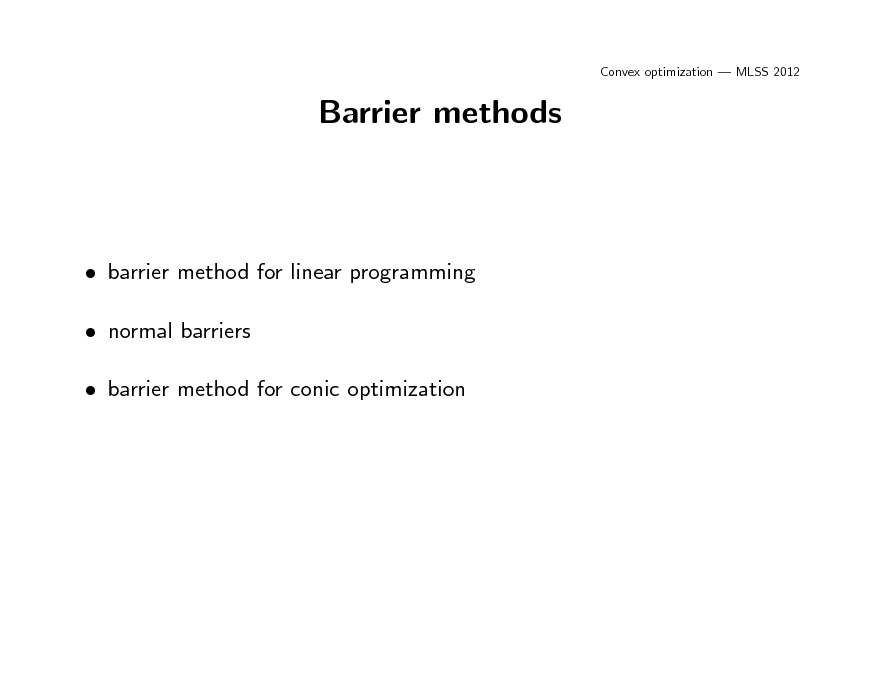
Convex optimization MLSS 2012
Barrier methods
barrier method for linear programming normal barriers barrier method for conic optimization
86
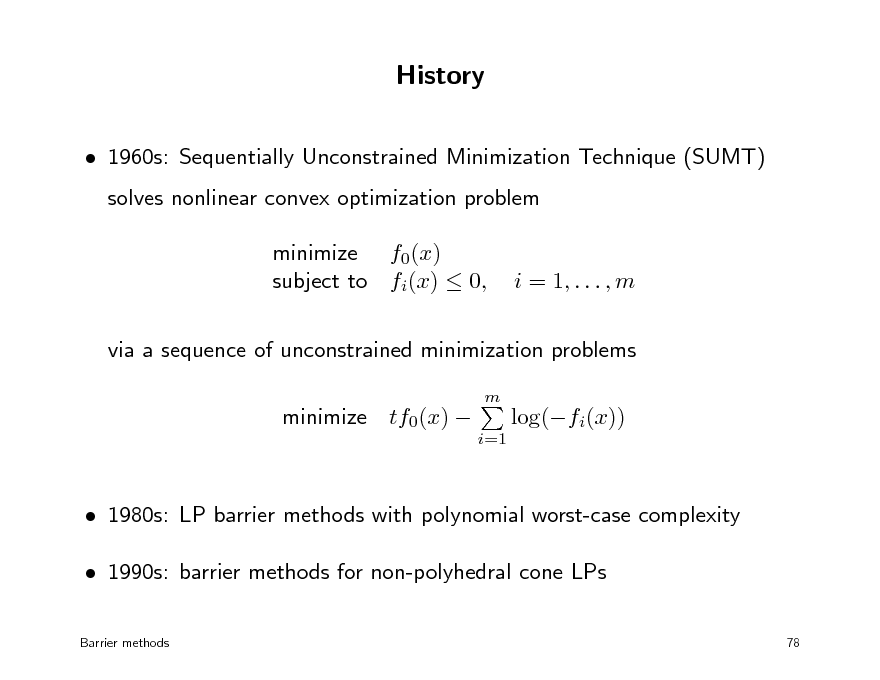
History
1960s: Sequentially Unconstrained Minimization Technique (SUMT) solves nonlinear convex optimization problem minimize f0(x) subject to fi(x) 0,
i = 1, . . . , m
via a sequence of unconstrained minimization problems
m
minimize tf0(x)
log(fi(x))
i=1
1980s: LP barrier methods with polynomial worst-case complexity 1990s: barrier methods for non-polyhedral cone LPs
Barrier methods 78
87
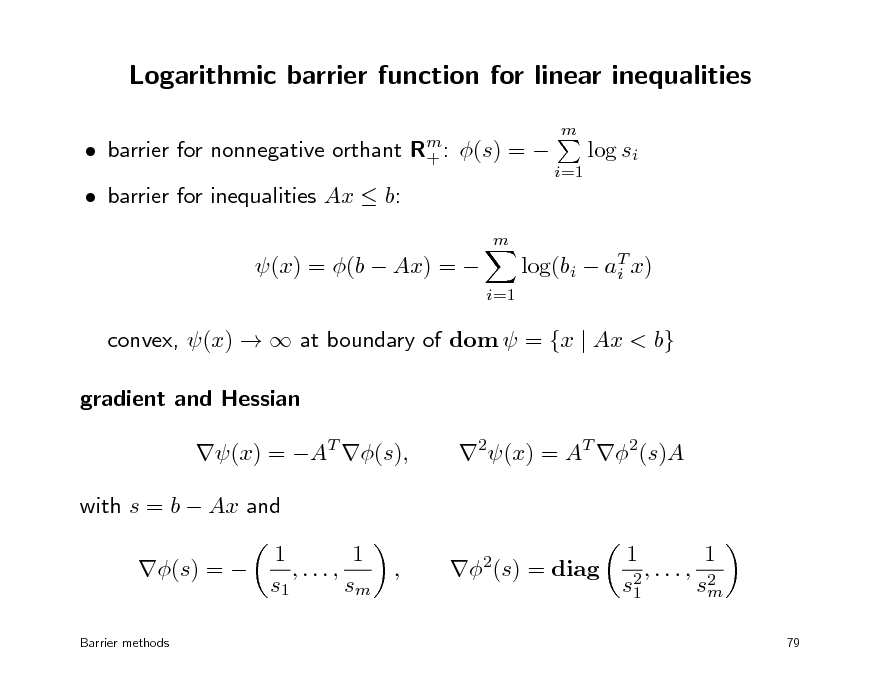
Logarithmic barrier function for linear inequalities
barrier for nonnegative orthant barrier for inequalities Ax b:
m
Rm : +
m
(s) =
log si
i=1
(x) = (b Ax) =
i=1
log(bi aT x) i
convex, (x) at boundary of dom = {x | Ax < b} gradient and Hessian (x) = AT (s), with s = b Ax and (s) =
Barrier methods
2(x) = AT 2(s)A
1 1 ,..., , s1 sm
2(s) = diag
1 1 ,..., 2 s2 sm 1
79
88
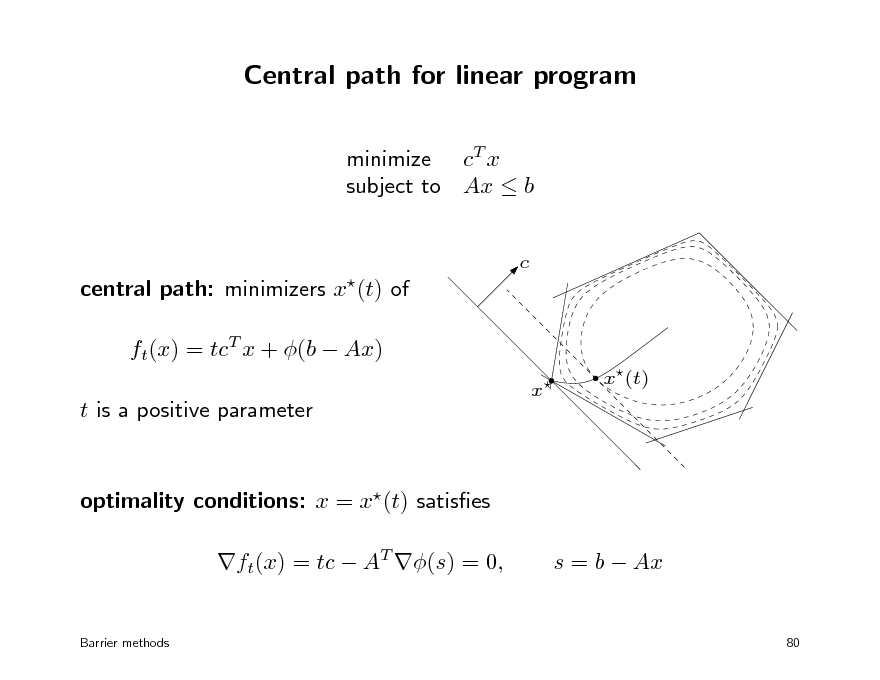
Central path for linear program
minimize cT x subject to Ax b
c
central path: minimizers x(t) of ft(x) = tcT x + (b Ax) t is a positive parameter
x
x(t)
optimality conditions: x = x(t) satises ft(x) = tc AT (s) = 0,
Barrier methods
s = b Ax
80
89
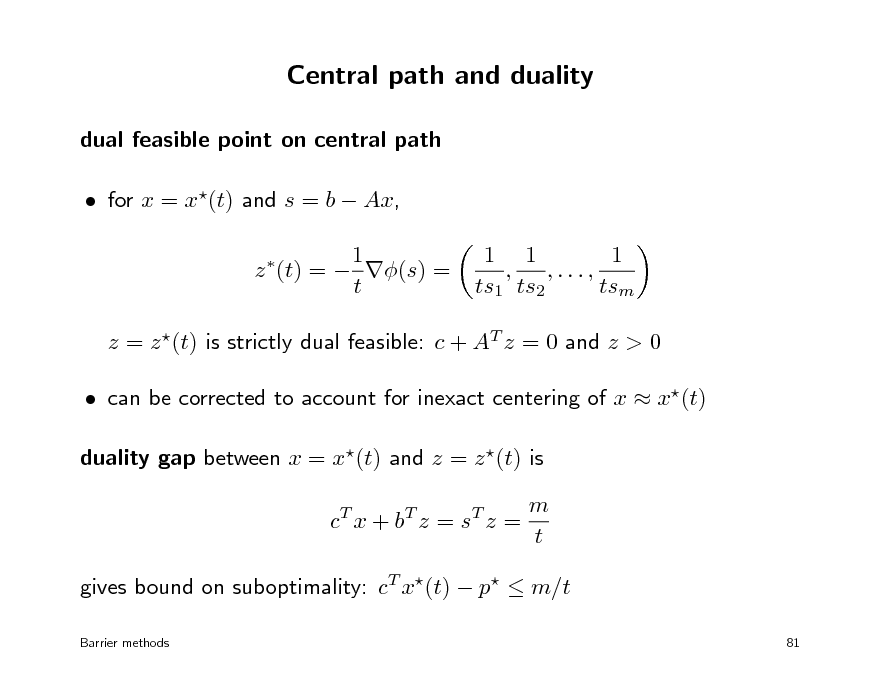
Central path and duality
dual feasible point on central path for x = x(t) and s = b Ax, 1 z (t) = (s) = t
1 1 1 , ,..., ts1 ts2 tsm
z = z (t) is strictly dual feasible: c + AT z = 0 and z > 0 can be corrected to account for inexact centering of x x(t) duality gap between x = x(t) and z = z (t) is c T x + bT z = s T z = m t
gives bound on suboptimality: cT x(t) p m/t
Barrier methods 81
90
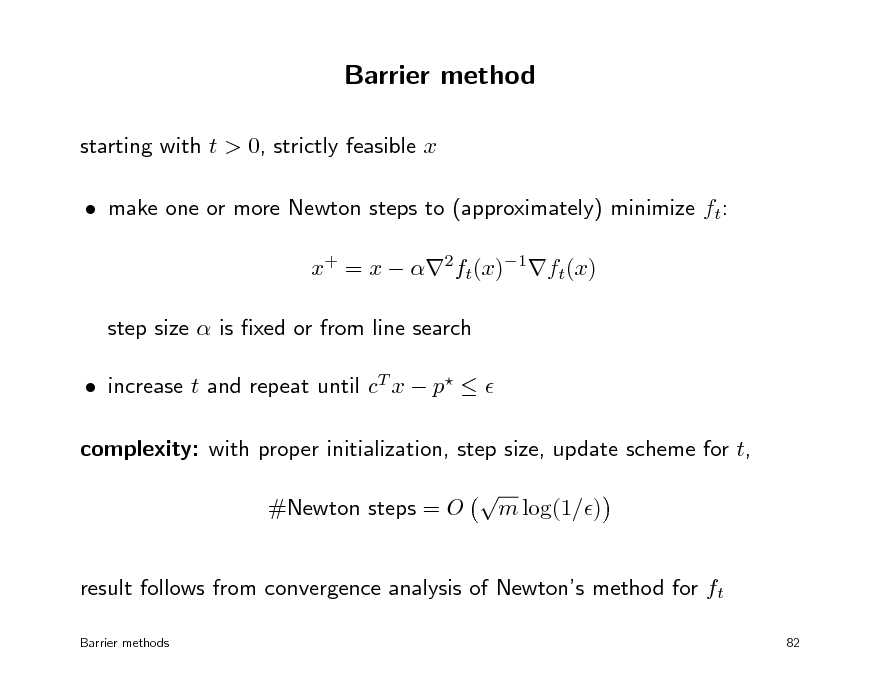
Barrier method
starting with t > 0, strictly feasible x make one or more Newton steps to (approximately) minimize ft: x+ = x 2ft(x)1ft(x) step size is xed or from line search increase t and repeat until cT x p complexity: with proper initialization, step size, update scheme for t, #Newton steps = O m log(1/)
result follows from convergence analysis of Newtons method for ft
Barrier methods 82
91
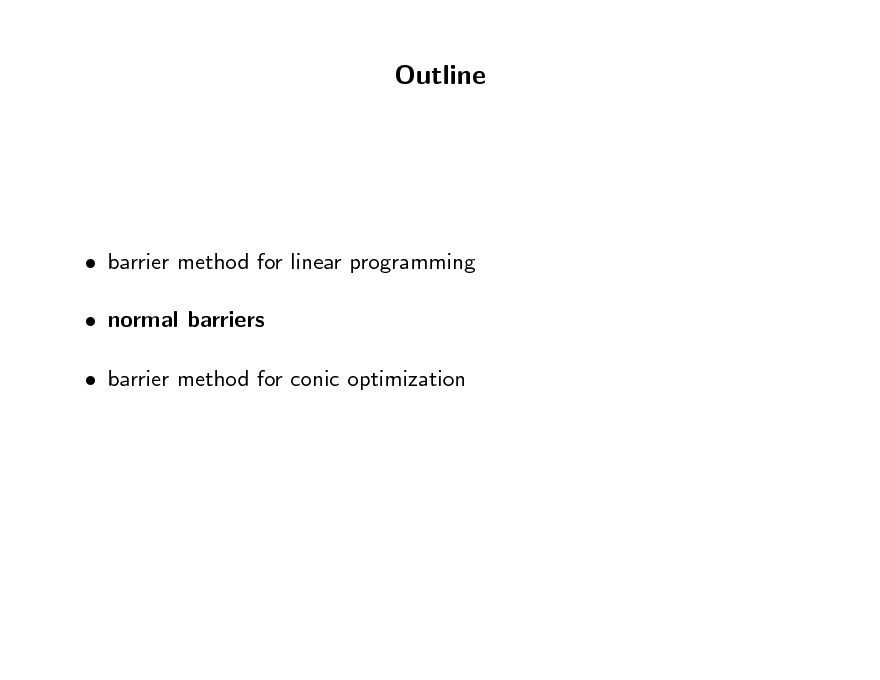
Outline
barrier method for linear programming normal barriers barrier method for conic optimization
92
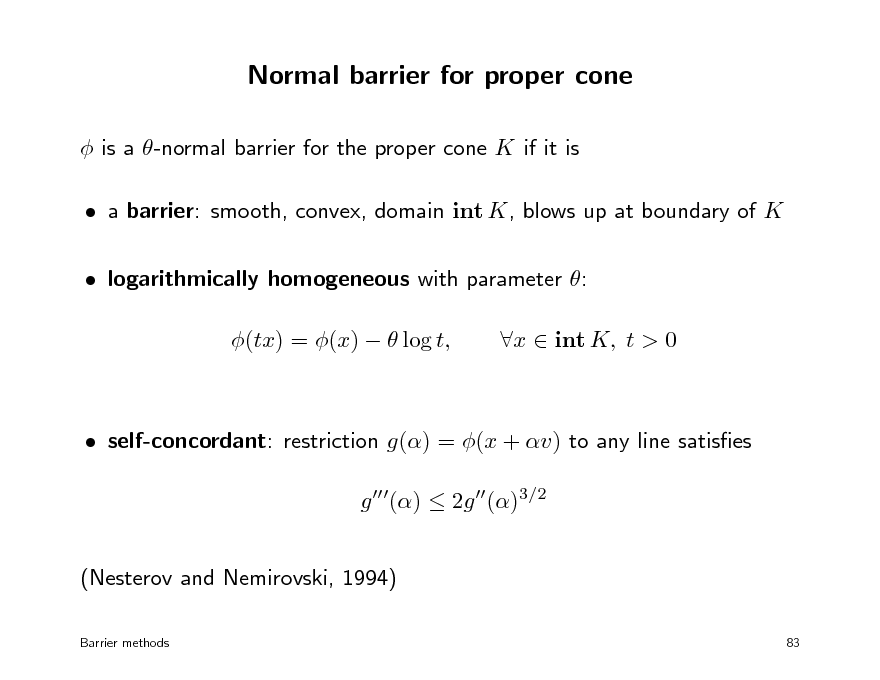
Normal barrier for proper cone
is a -normal barrier for the proper cone K if it is a barrier: smooth, convex, domain int K, blows up at boundary of K logarithmically homogeneous with parameter : (tx) = (x) log t, x int K, t > 0
self-concordant: restriction g() = (x + v) to any line satises g () 2g ()3/2 (Nesterov and Nemirovski, 1994)
Barrier methods 83
93
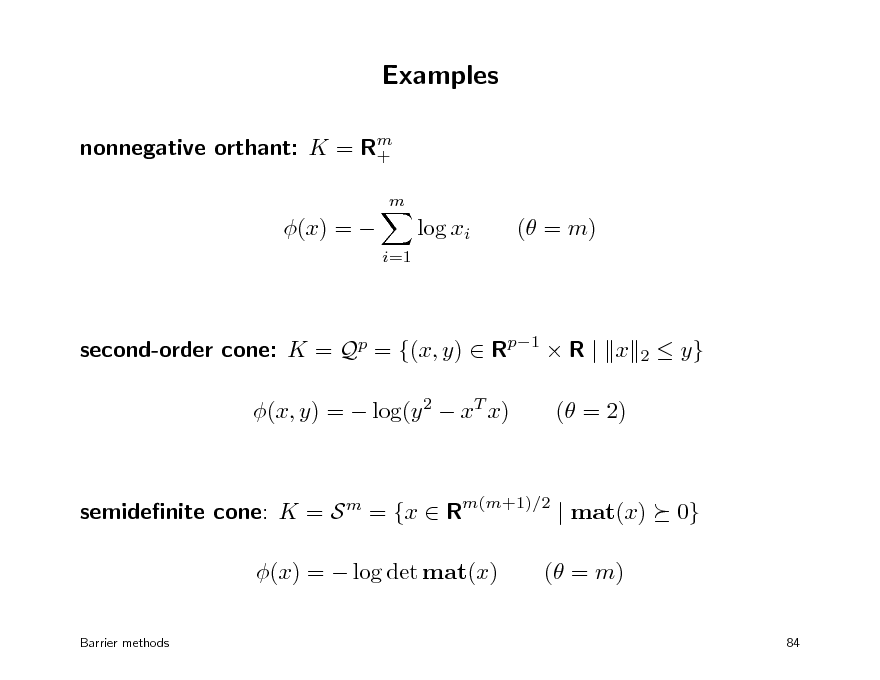
Examples
nonnegative orthant: K = Rm +
m
(x) =
log xi
i=1
( = m)
second-order cone: K = Qp = {(x, y) Rp1 R | x (x, y) = log(y 2 xT x) ( = 2)
2
y}
semidenite cone: K = S m = {x Rm(m+1)/2 | mat(x) (x) = log det mat(x)
Barrier methods
0}
( = m)
84
94
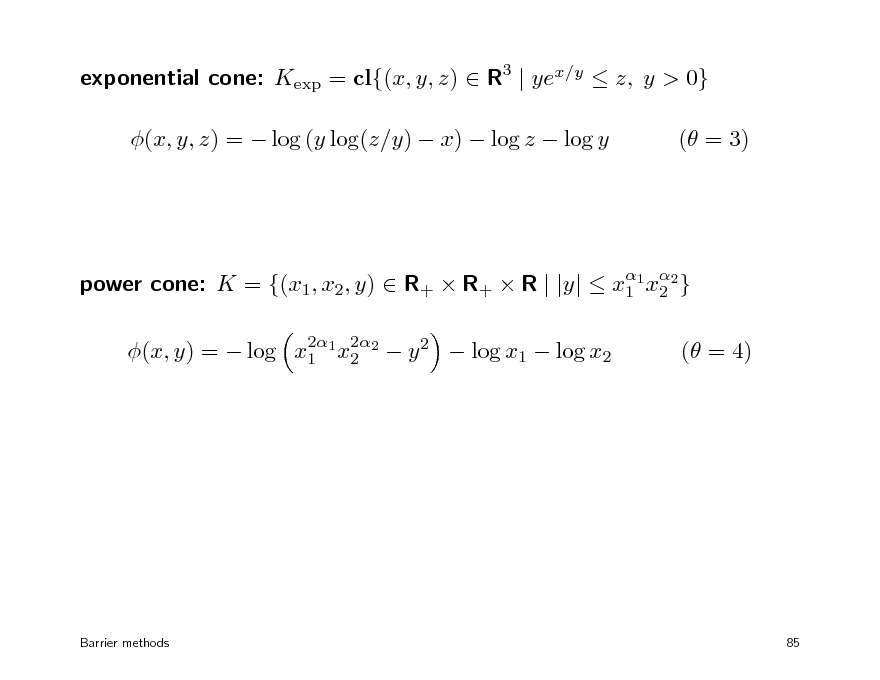
exponential cone: Kexp = cl{(x, y, z) R3 | yex/y z, y > 0} (x, y, z) = log (y log(z/y) x) log z log y ( = 3)
power cone: K = {(x1, x2, y) R+ R+ R | |y| x1 1 x2 } 2 2 2 (x, y) = log x1 1 x2 2 y 2 log x1 log x2
( = 4)
Barrier methods
85
95
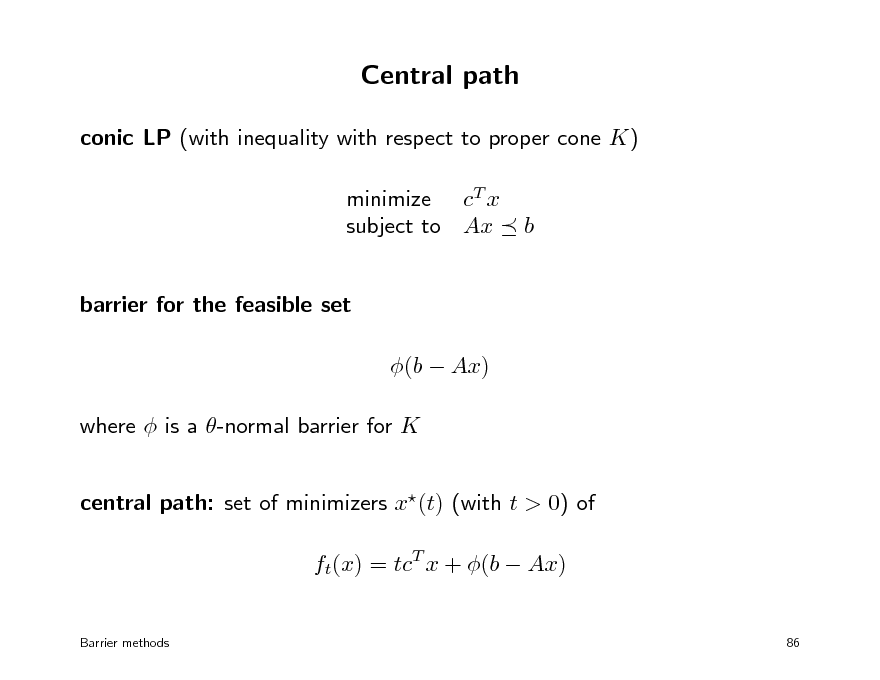
Central path
conic LP (with inequality with respect to proper cone K) minimize cT x subject to Ax barrier for the feasible set (b Ax) where is a -normal barrier for K central path: set of minimizers x(t) (with t > 0) of ft(x) = tcT x + (b Ax)
Barrier methods 86
b
96
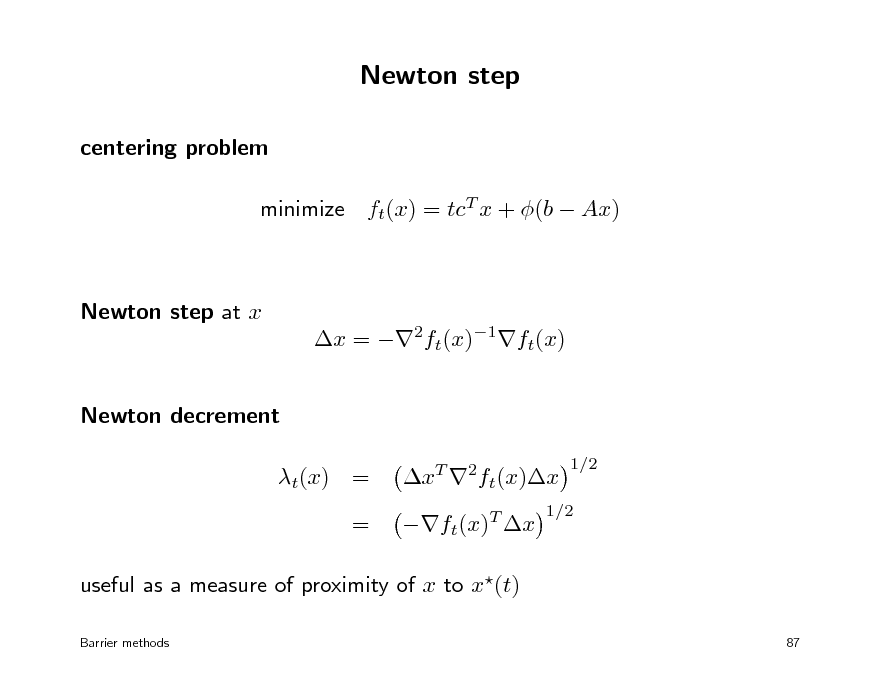
Newton step
centering problem minimize ft(x) = tcT x + (b Ax)
Newton step at x x = 2ft(x)1ft(x) Newton decrement t(x) = = xT 2ft(x)x ft(x)T x
1/2
1/2
useful as a measure of proximity of x to x(t)
Barrier methods 87
97
![Slide: Damped Newton method
minimize ft(x) = tcT x + (b Ax) algorithm (with parameters (0, 1/2), (0, 1/4]) select a starting point x dom ft repeat: 1. compute Newton step x and Newton decrement t(x) 2. if t(x)2 , return x 3. otherwise, set x := x + x with 1 = 1 + t(x) if t(x) , =1 if t(x) <
stopping criterion t(x)2 implies ft(x) inf ft(x) alternatively, can use backtracking line search
Barrier methods 88](https://yosinski.com/mlss12/media/slides/MLSS-2012-Vandenberghe-Convex-Optimization_098.png)
Damped Newton method
minimize ft(x) = tcT x + (b Ax) algorithm (with parameters (0, 1/2), (0, 1/4]) select a starting point x dom ft repeat: 1. compute Newton step x and Newton decrement t(x) 2. if t(x)2 , return x 3. otherwise, set x := x + x with 1 = 1 + t(x) if t(x) , =1 if t(x) <
stopping criterion t(x)2 implies ft(x) inf ft(x) alternatively, can use backtracking line search
Barrier methods 88
98
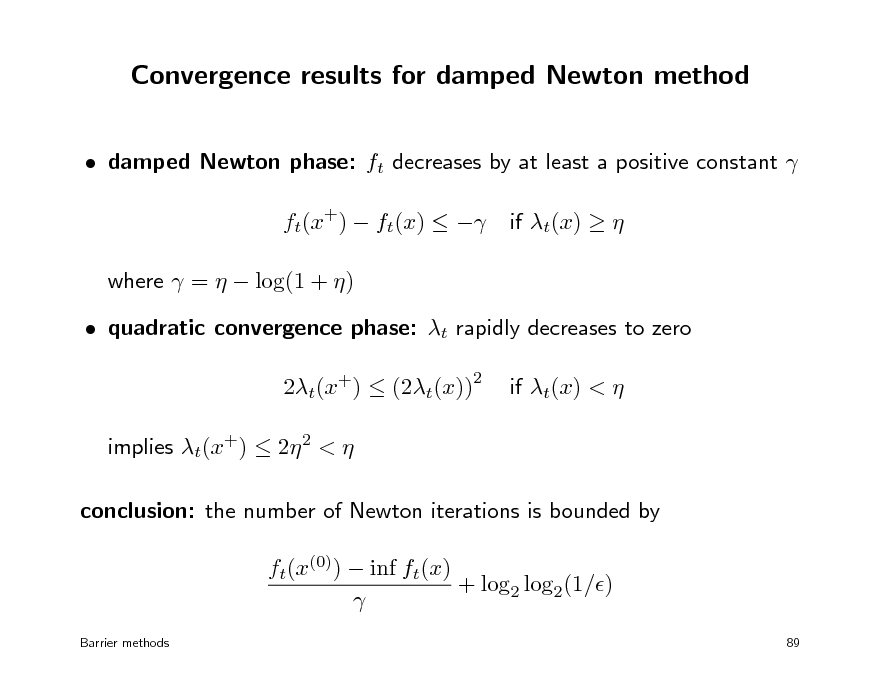
Convergence results for damped Newton method
damped Newton phase: ft decreases by at least a positive constant ft(x+) ft(x) where = log(1 + ) quadratic convergence phase: t rapidly decreases to zero 2t(x+) (2t(x)) implies t(x+) 2 2 < conclusion: the number of Newton iterations is bounded by ft(x(0)) inf ft(x) + log2 log2(1/)
Barrier methods 89
if t(x)
2
if t(x) <
99
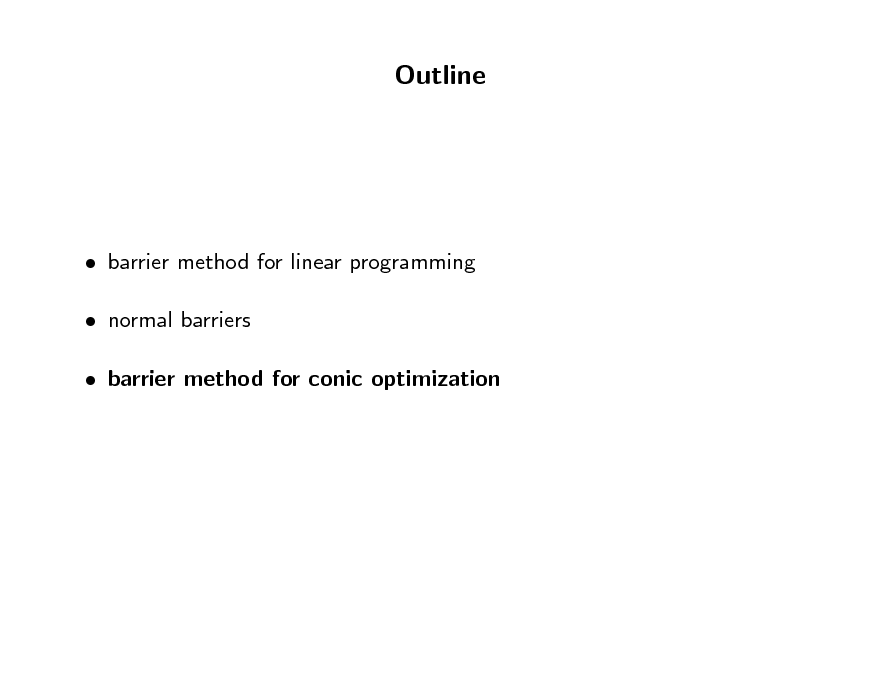
Outline
barrier method for linear programming normal barriers barrier method for conic optimization
100

Central path and duality
x(t) = argmin tcT x + (b Ax) duality point on central path: x(t) denes a strictly dual feasible z (t) 1 z (t) = (s), t
s = b Ax(t)
duality gap: gap between x = x(t) and z = z (t) is c T x + bT z = s T z = , t
T
c T x p
t t(x) 1+ t
extension near central path (for t(x) < 1): c x p (results follow from properties of normal barriers)
Barrier methods
90
101
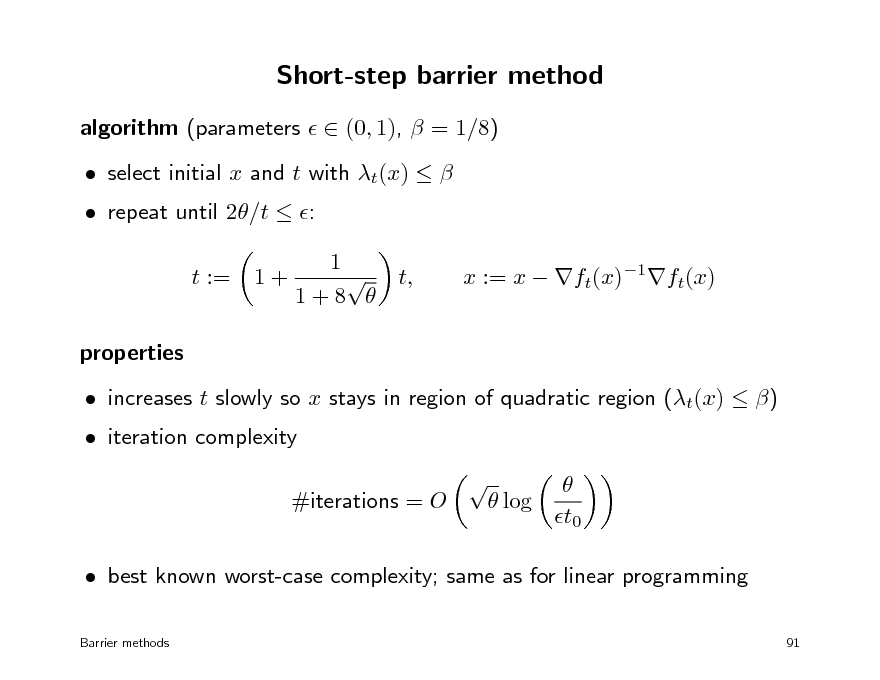
Short-step barrier method
algorithm (parameters (0, 1), = 1/8) repeat until 2/t : t := properties increases t slowly so x stays in region of quadratic region (t(x) ) log t0 1+ select initial x and t with t(x) 1 t, 1+8
x := x ft(x)1ft(x)
iteration complexity
#iterations = O
best known worst-case complexity; same as for linear programming
Barrier methods 91
102
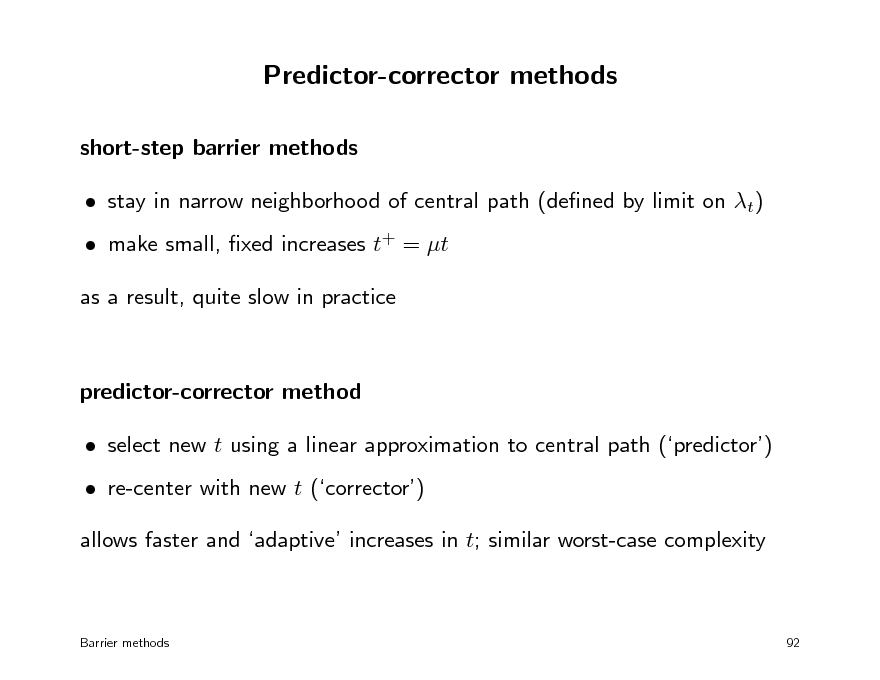
Predictor-corrector methods
short-step barrier methods stay in narrow neighborhood of central path (dened by limit on t) make small, xed increases t+ = t as a result, quite slow in practice
predictor-corrector method select new t using a linear approximation to central path (predictor) re-center with new t (corrector) allows faster and adaptive increases in t; similar worst-case complexity
Barrier methods
92
103
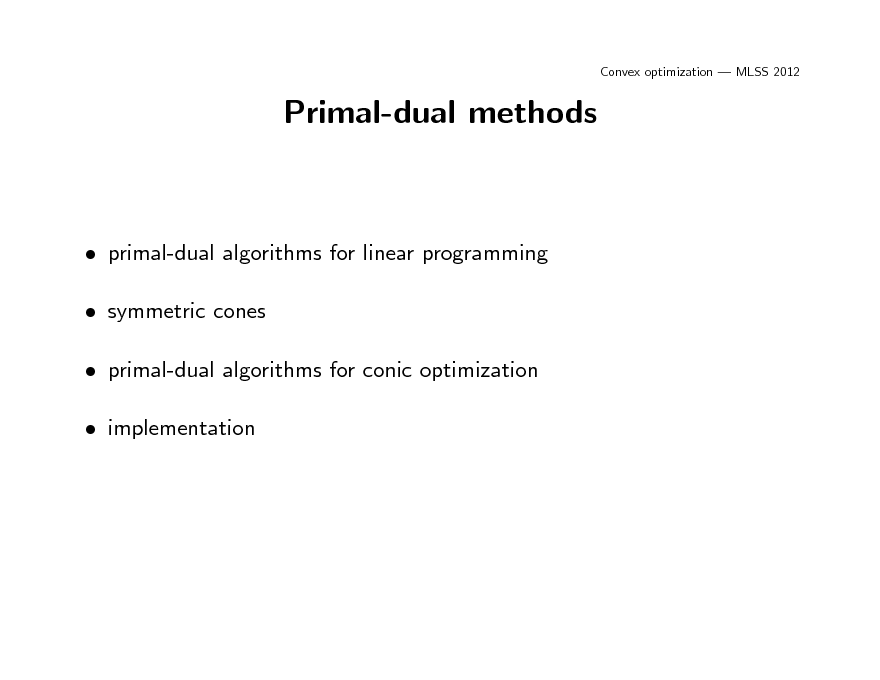
Convex optimization MLSS 2012
Primal-dual methods
primal-dual algorithms for linear programming symmetric cones primal-dual algorithms for conic optimization implementation
104
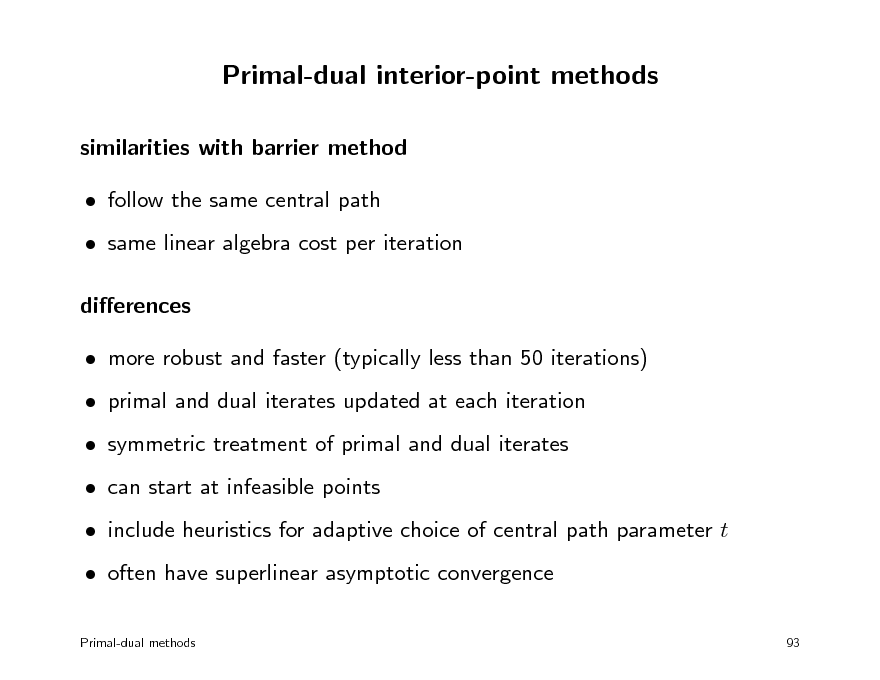
Primal-dual interior-point methods
similarities with barrier method follow the same central path same linear algebra cost per iteration dierences more robust and faster (typically less than 50 iterations) primal and dual iterates updated at each iteration symmetric treatment of primal and dual iterates can start at infeasible points include heuristics for adaptive choice of central path parameter t often have superlinear asymptotic convergence
Primal-dual methods 93
105
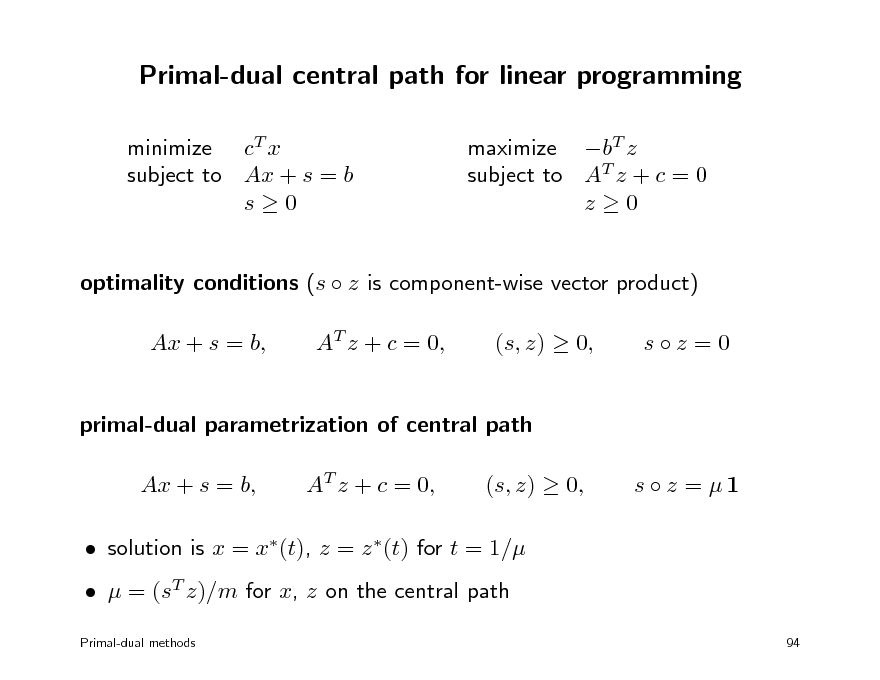
Primal-dual central path for linear programming
minimize cT x subject to Ax + s = b s0 maximize bT z subject to AT z + c = 0 z0
optimality conditions (s z is component-wise vector product) Ax + s = b, AT z + c = 0, (s, z) 0, sz =0
primal-dual parametrization of central path Ax + s = b, AT z + c = 0, (s, z) 0, s z = 1
solution is x = x(t), z = z (t) for t = 1/ = (sT z)/m for x, z on the central path
Primal-dual methods 94
106
![Slide: Primal-dual search direction
current iterates x, s > 0, z > 0 updated as x := x + x, s := s + s, z := z + z
primal and dual steps x, s, z are dened by A( + x) + s + s = b, x AT ( + z) + c = 0 z
z s + s z = 1 s z where = (T z )/m and [0, 1] s last equation is linearization of ( + s) ( + z) = 1 s z dierent methods use dierent strategies for selecting (0, 1] selected so that s > 0, z > 0
Primal-dual methods 95
targets point on central path with = i.e., with gap (T z ) s](https://yosinski.com/mlss12/media/slides/MLSS-2012-Vandenberghe-Convex-Optimization_107.png)
Primal-dual search direction
current iterates x, s > 0, z > 0 updated as x := x + x, s := s + s, z := z + z
primal and dual steps x, s, z are dened by A( + x) + s + s = b, x AT ( + z) + c = 0 z
z s + s z = 1 s z where = (T z )/m and [0, 1] s last equation is linearization of ( + s) ( + z) = 1 s z dierent methods use dierent strategies for selecting (0, 1] selected so that s > 0, z > 0
Primal-dual methods 95
targets point on central path with = i.e., with gap (T z ) s
107
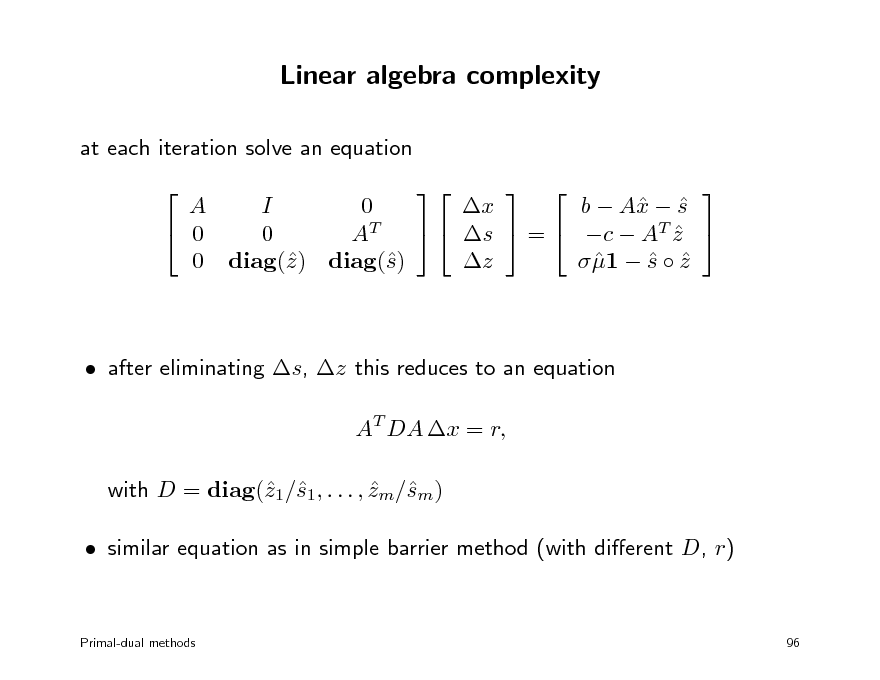
Linear algebra complexity
at each iteration solve an equation A I 0 b A s x x 0 s = c AT z 0 AT z 1 s z 0 diag() diag() z s after eliminating s, z this reduces to an equation AT DA x = r, with D = diag(1/1, . . . , zm/m) z s s similar equation as in simple barrier method (with dierent D, r)
Primal-dual methods
96
108
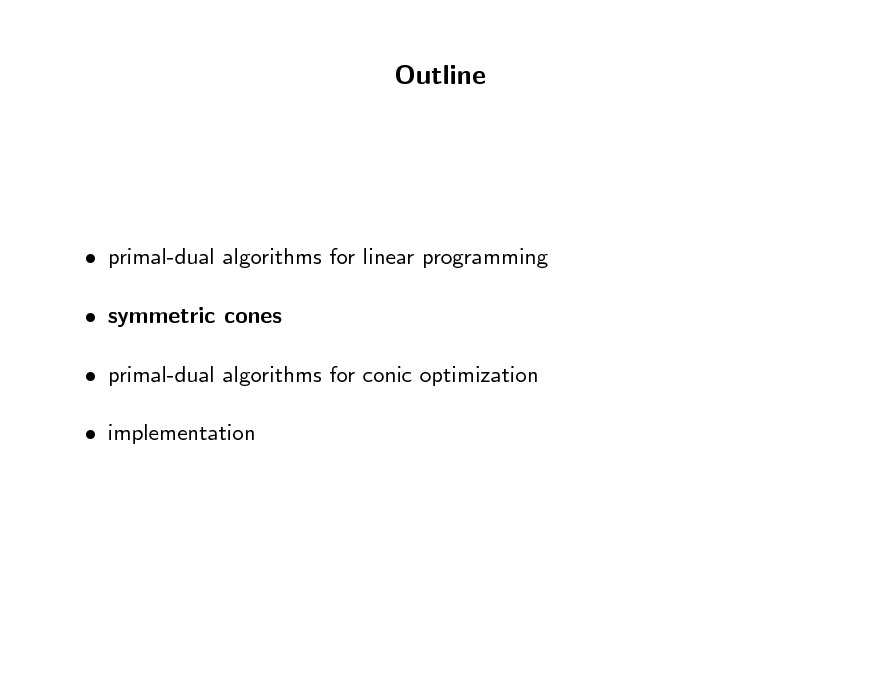
Outline
primal-dual algorithms for linear programming symmetric cones primal-dual algorithms for conic optimization implementation
109
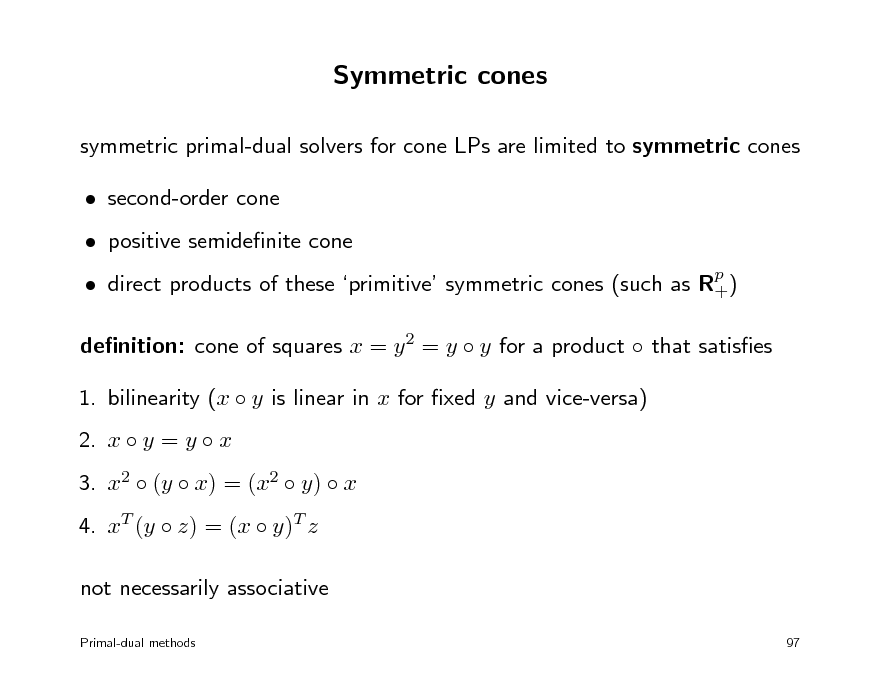
Symmetric cones
symmetric primal-dual solvers for cone LPs are limited to symmetric cones second-order cone positive semidenite cone direct products of these primitive symmetric cones (such as Rp ) + denition: cone of squares x = y 2 = y y for a product that satises 1. bilinearity (x y is linear in x for xed y and vice-versa) 2. x y = y x 3. x2 (y x) = (x2 y) x 4. xT (y z) = (x y)T z not necessarily associative
Primal-dual methods 97
110
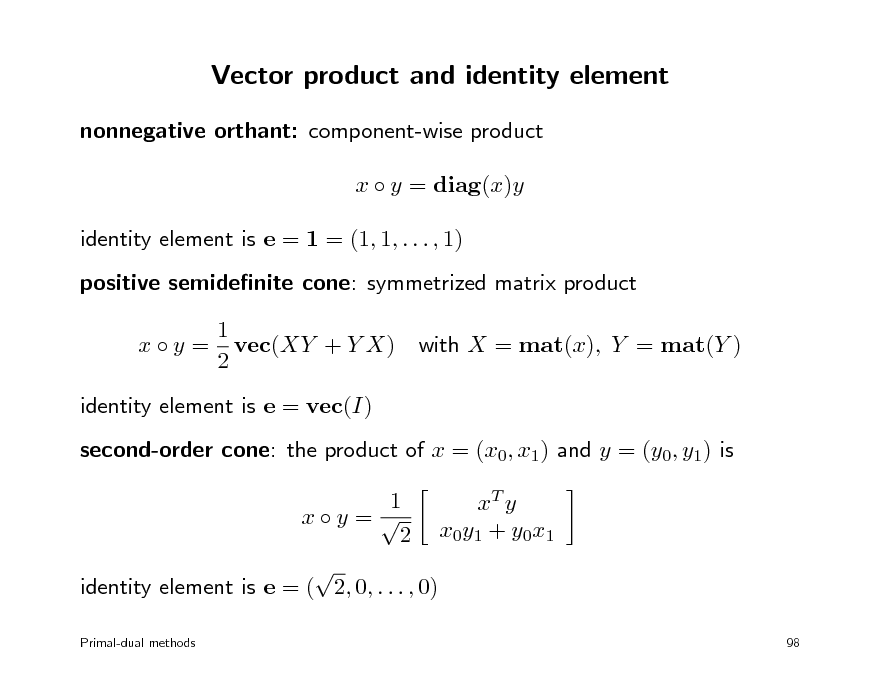
Vector product and identity element
nonnegative orthant: component-wise product x y = diag(x)y identity element is e = 1 = (1, 1, . . . , 1) positive semidenite cone: symmetrized matrix product 1 x y = vec(XY + Y X) 2 identity element is e = vec(I) second-order cone: the product of x = (x0, x1) and y = (y0, y1) is 1 xT y xy = 2 x0 y1 + y0 x1 identity element is e = ( 2, 0, . . . , 0)
Primal-dual methods 98
with X = mat(x), Y = mat(Y )
111
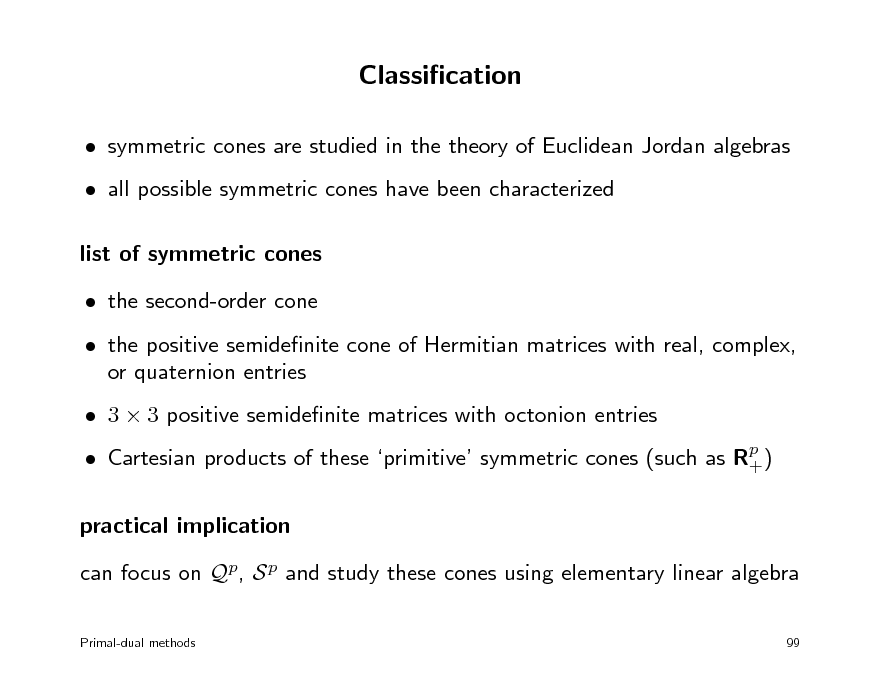
Classication
symmetric cones are studied in the theory of Euclidean Jordan algebras all possible symmetric cones have been characterized list of symmetric cones the second-order cone the positive semidenite cone of Hermitian matrices with real, complex, or quaternion entries 3 3 positive semidenite matrices with octonion entries Cartesian products of these primitive symmetric cones (such as Rp ) +
practical implication can focus on Qp, S p and study these cones using elementary linear algebra
Primal-dual methods 99
112
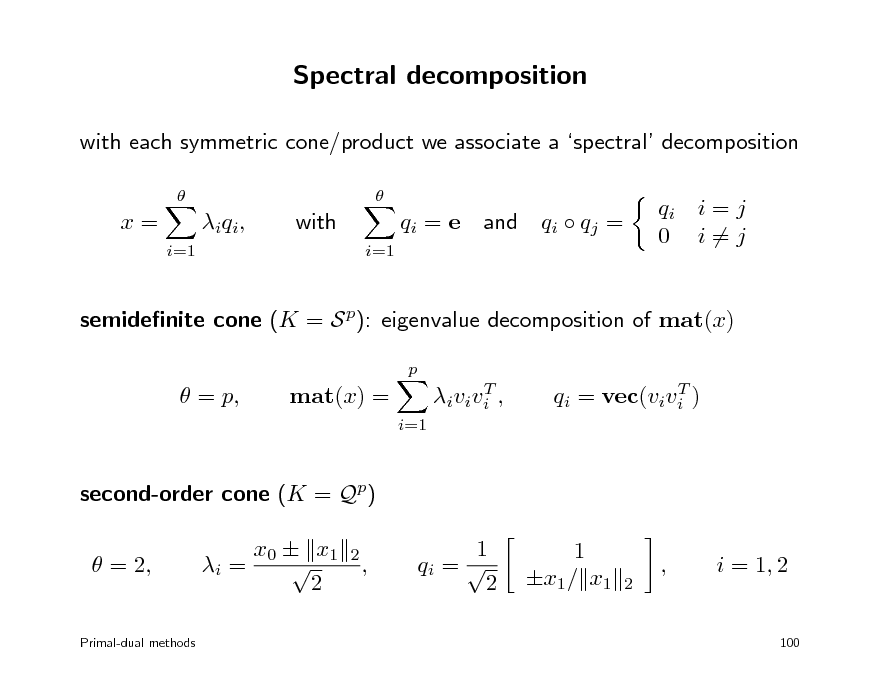
Spectral decomposition
with each symmetric cone/product we associate a spectral decomposition
x=
i=1
i q i ,
with
i=1
qi = e
and
qi qj =
qi i = j 0 i=j
semidenite cone (K = S p): eigenvalue decomposition of mat(x)
p
= p,
mat(x) =
i=1
T i v i v i ,
T qi = vec(vivi )
second-order cone (K = Qp) = 2, i = x0 x1 2
2
,
1 qi = 2
1 x1/ x1
2
,
i = 1, 2
Primal-dual methods
100
113
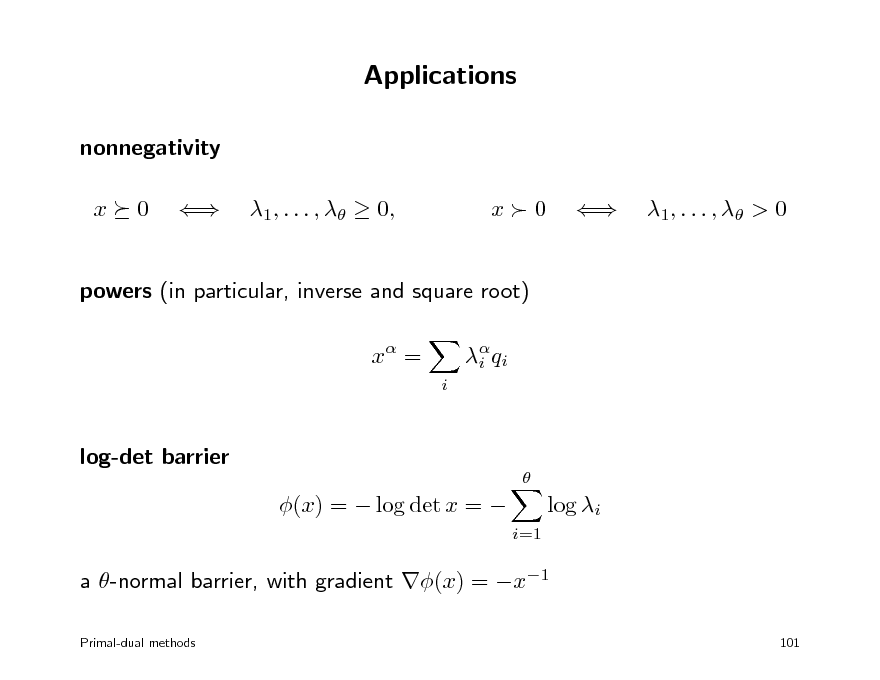
Applications
nonnegativity x 0 1, . . . , 0, x0 1 , . . . , > 0
powers (in particular, inverse and square root) x =
i i q i
log-det barrier
(x) = log det x =
log i
i=1
a -normal barrier, with gradient (x) = x1
Primal-dual methods 101
114
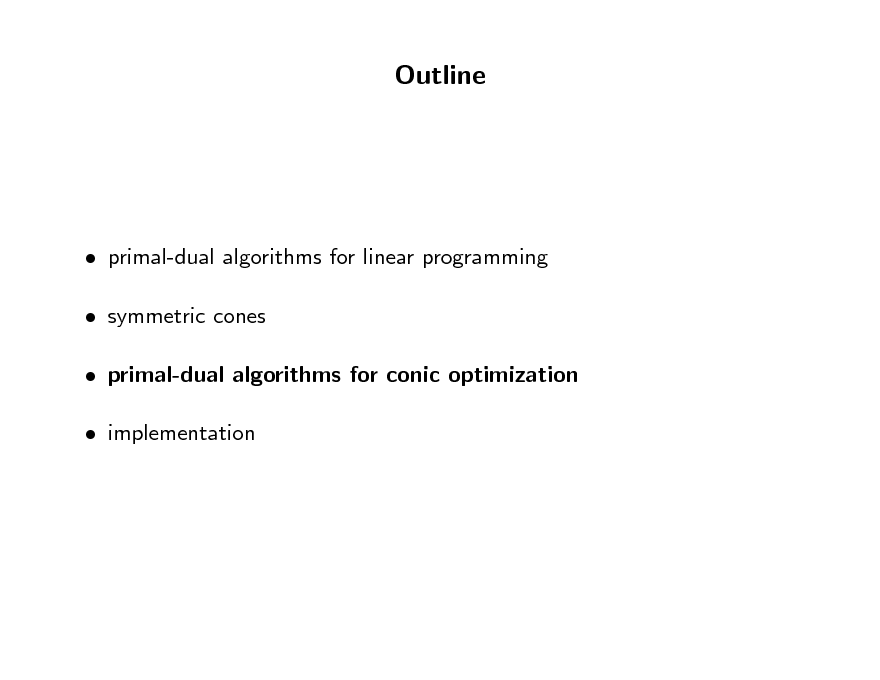
Outline
primal-dual algorithms for linear programming symmetric cones primal-dual algorithms for conic optimization implementation
115
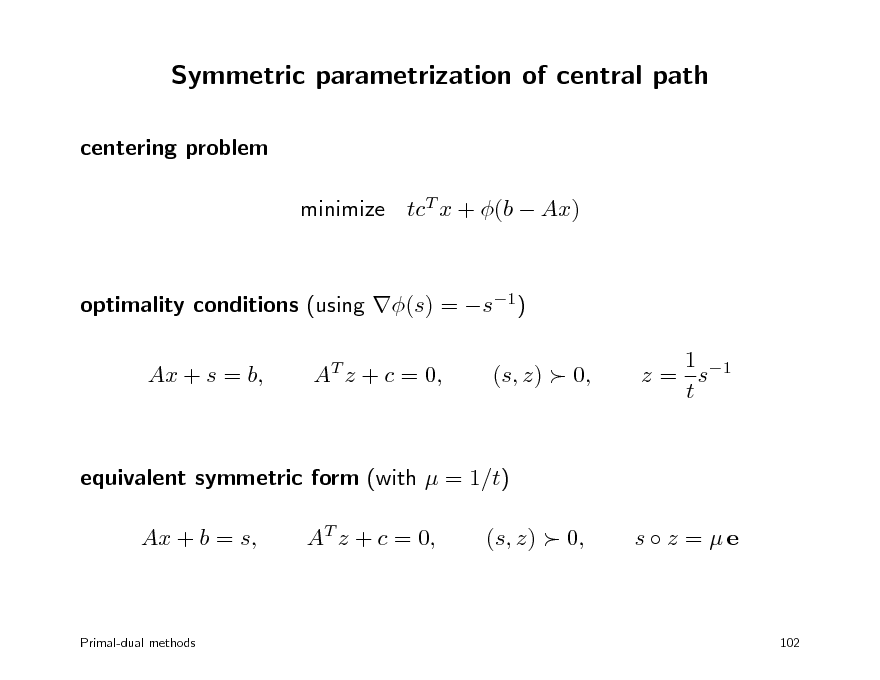
Symmetric parametrization of central path
centering problem minimize tcT x + (b Ax) optimality conditions (using (s) = s1) Ax + s = b, AT z + c = 0, (s, z) 0, 1 z = s1 t
equivalent symmetric form (with = 1/t) Ax + b = s, AT z + c = 0, (s, z) 0, s z = e
Primal-dual methods
102
116
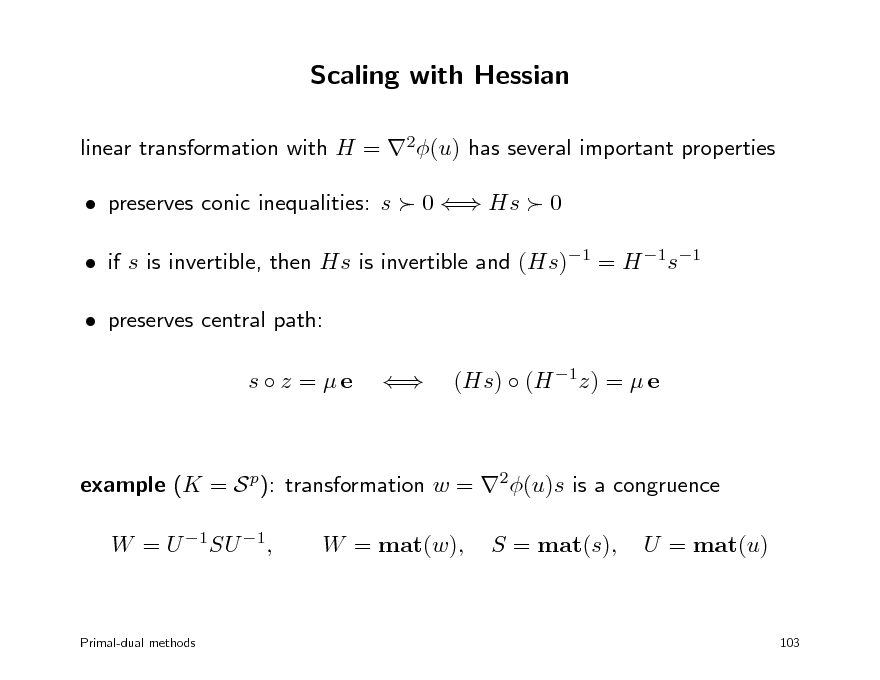
Scaling with Hessian
linear transformation with H = 2(u) has several important properties preserves conic inequalities: s 0 Hs 0 if s is invertible, then Hs is invertible and (Hs)1 = H 1s1 preserves central path: s z = e (Hs) (H 1z) = e
example (K = S p): transformation w = 2(u)s is a congruence W = U 1SU 1, W = mat(w), S = mat(s), U = mat(u)
Primal-dual methods
103
117
![Slide: Primal-dual search direction
steps x, s, z at current iterates x, s, z are dened by A( + x) + s + s = b, x AT ( + z) + c = 0 z
(H s) (H 1z) + (H 1z ) (Hs) = e (H s) (H 1z ) where = (T z )/, [0, 1], and H = 2(u) s last equation is linearization of (H( + s)) H 1( + z) = e s z dierent algorithms use dierent choices of , H Nesterov-Todd scaling: choose H = 2(u) such that H s = H 1z
Primal-dual methods 104](https://yosinski.com/mlss12/media/slides/MLSS-2012-Vandenberghe-Convex-Optimization_118.png)
Primal-dual search direction
steps x, s, z at current iterates x, s, z are dened by A( + x) + s + s = b, x AT ( + z) + c = 0 z
(H s) (H 1z) + (H 1z ) (Hs) = e (H s) (H 1z ) where = (T z )/, [0, 1], and H = 2(u) s last equation is linearization of (H( + s)) H 1( + z) = e s z dierent algorithms use dierent choices of , H Nesterov-Todd scaling: choose H = 2(u) such that H s = H 1z
Primal-dual methods 104
118
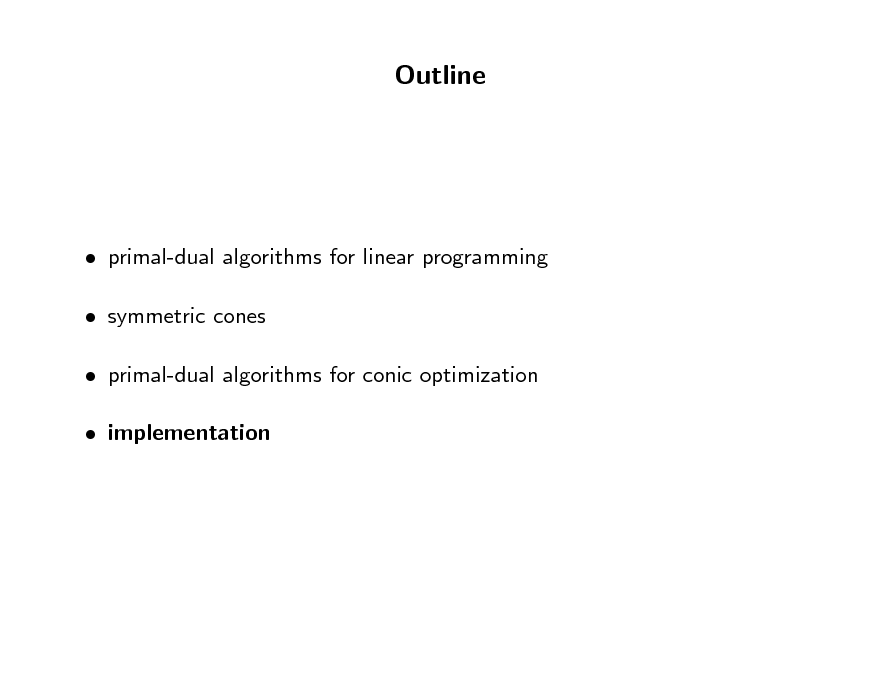
Outline
primal-dual algorithms for linear programming symmetric cones primal-dual algorithms for conic optimization implementation
119
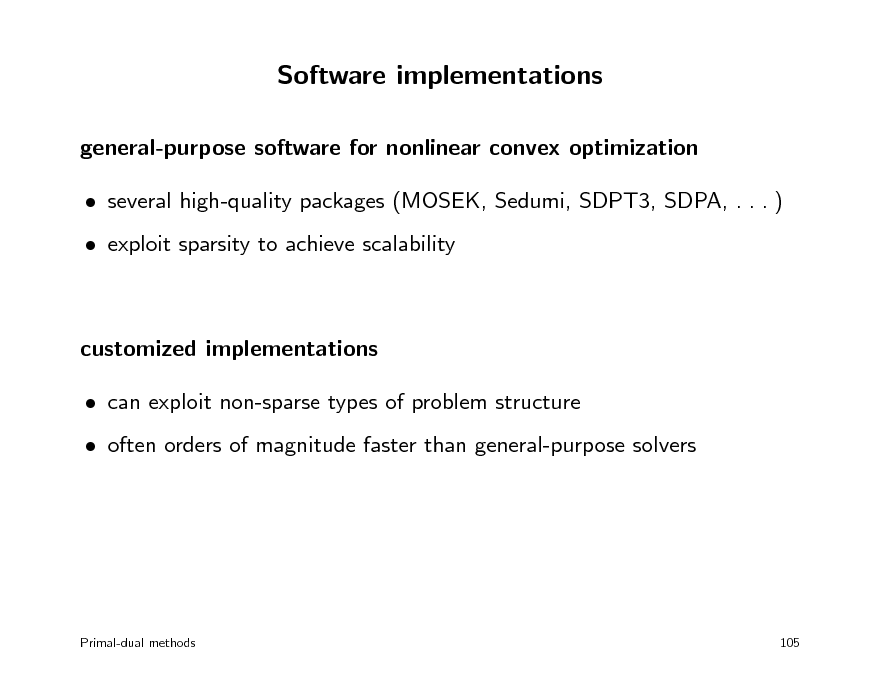
Software implementations
general-purpose software for nonlinear convex optimization several high-quality packages (MOSEK, Sedumi, SDPT3, SDPA, . . . ) exploit sparsity to achieve scalability
customized implementations can exploit non-sparse types of problem structure often orders of magnitude faster than general-purpose solvers
Primal-dual methods
105
120
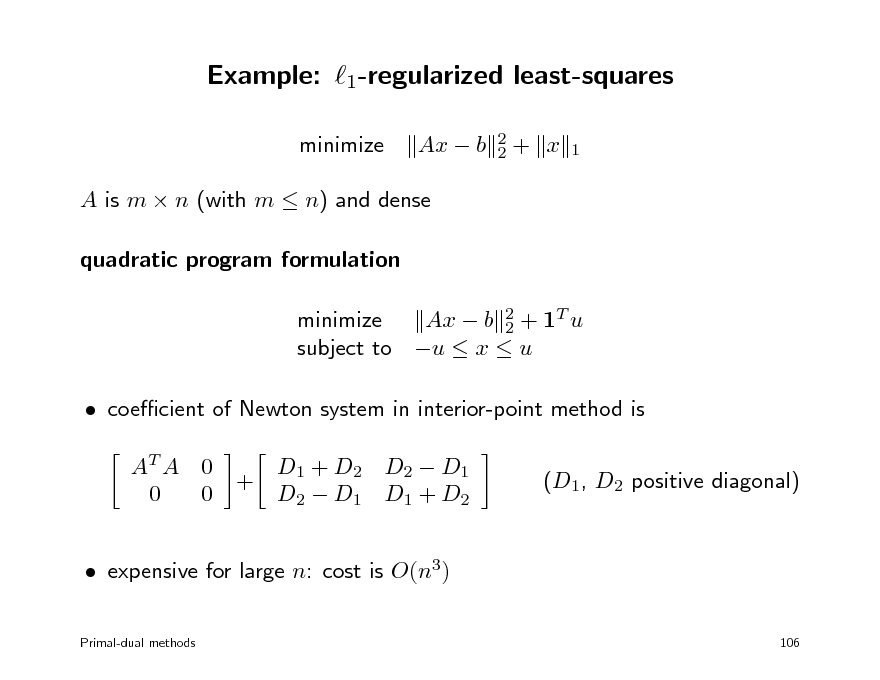
Example: 1-regularized least-squares
minimize Ax b
2 2
+ x
1
A is m n (with m n) and dense quadratic program formulation minimize Ax b 2 + 1T u 2 subject to u x u coecient of Newton system in interior-point method is AT A 0 0 0 + D1 + D2 D2 D1 D2 D1 D1 + D2 (D1, D2 positive diagonal)
expensive for large n: cost is O(n3)
Primal-dual methods 106
121
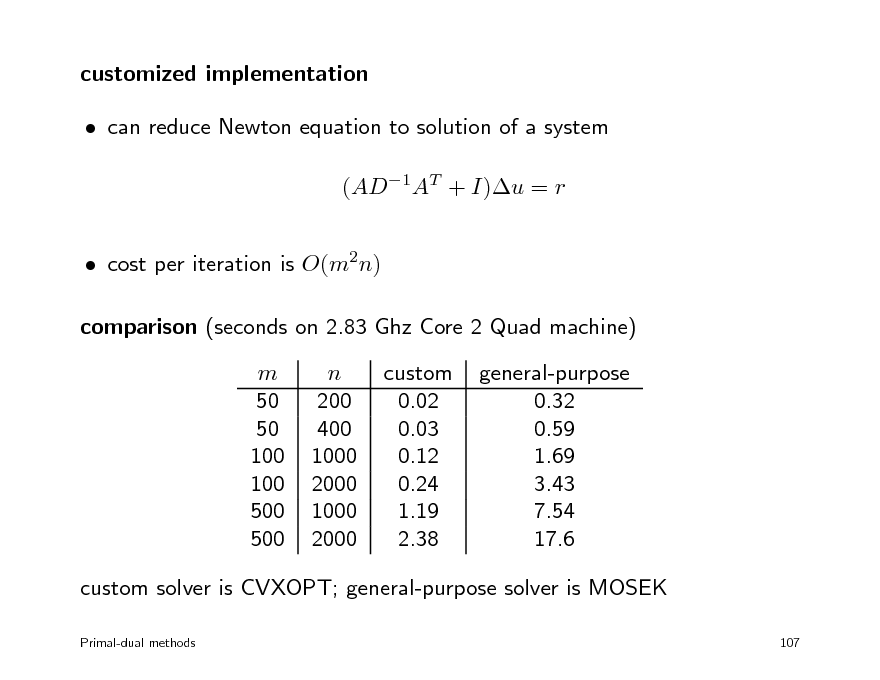
customized implementation can reduce Newton equation to solution of a system (AD1AT + I)u = r cost per iteration is O(m2n) comparison (seconds on 2.83 Ghz Core 2 Quad machine) m 50 50 100 100 500 500 n 200 400 1000 2000 1000 2000 custom 0.02 0.03 0.12 0.24 1.19 2.38 general-purpose 0.32 0.59 1.69 3.43 7.54 17.6
custom solver is CVXOPT; general-purpose solver is MOSEK
Primal-dual methods 107
122
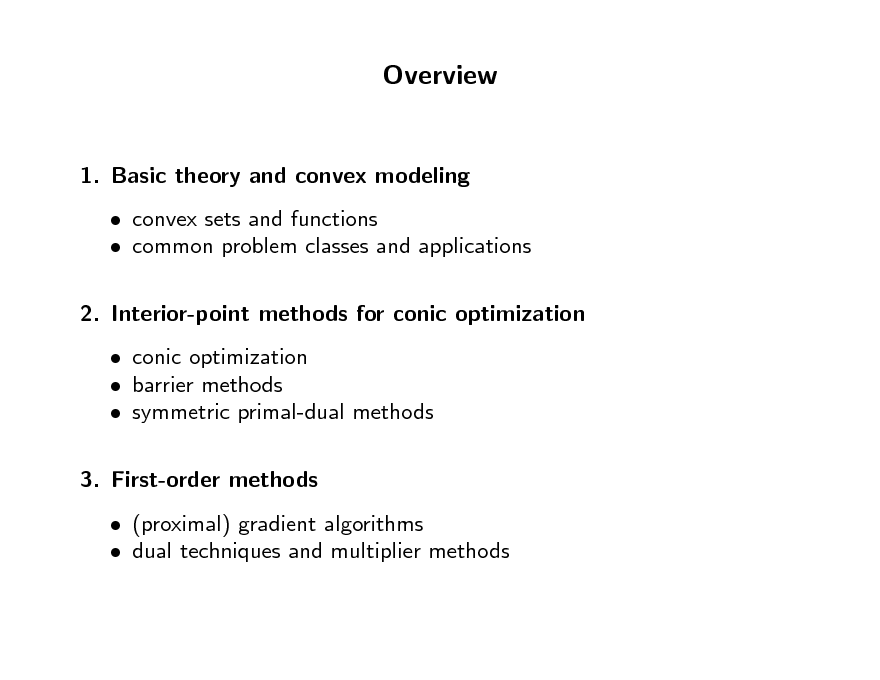
Overview
1. Basic theory and convex modeling convex sets and functions common problem classes and applications 2. Interior-point methods for conic optimization conic optimization barrier methods symmetric primal-dual methods 3. First-order methods (proximal) gradient algorithms dual techniques and multiplier methods
123
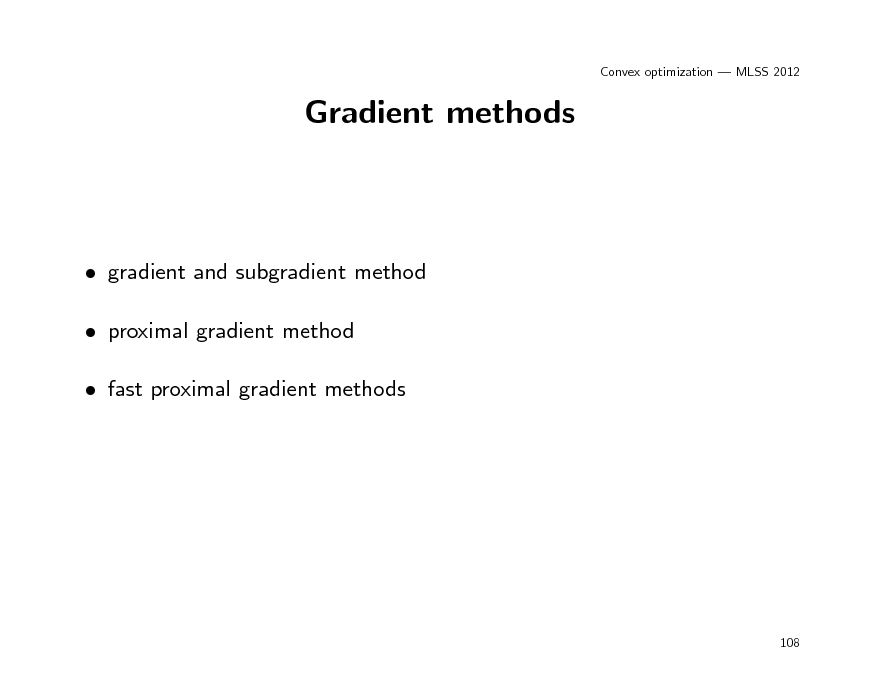
Convex optimization MLSS 2012
Gradient methods
gradient and subgradient method proximal gradient method fast proximal gradient methods
108
124
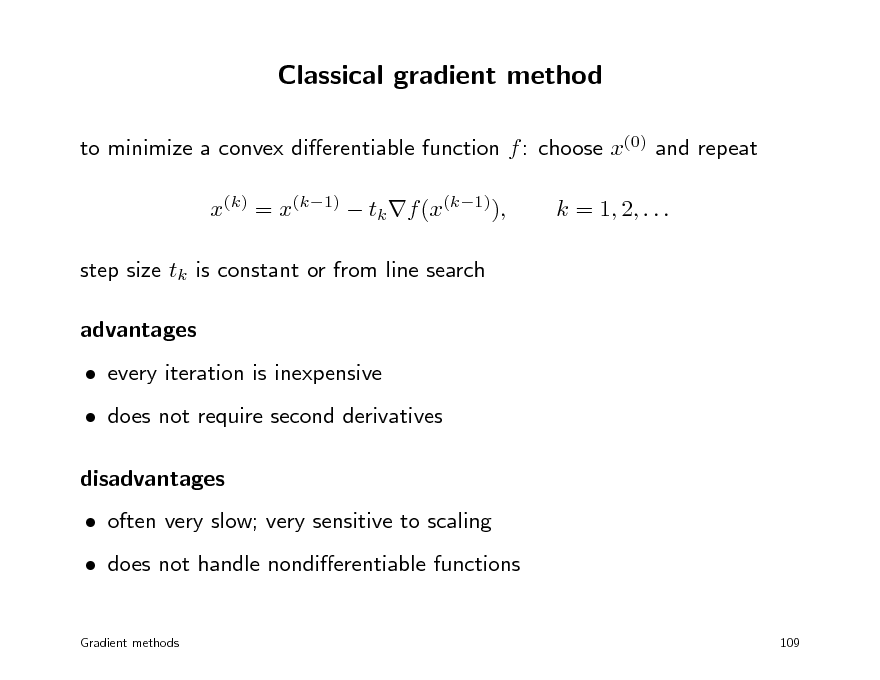
Classical gradient method
to minimize a convex dierentiable function f : choose x(0) and repeat x(k) = x(k1) tk f (x(k1)), step size tk is constant or from line search advantages every iteration is inexpensive does not require second derivatives disadvantages often very slow; very sensitive to scaling does not handle nondierentiable functions
Gradient methods 109
k = 1, 2, . . .
125
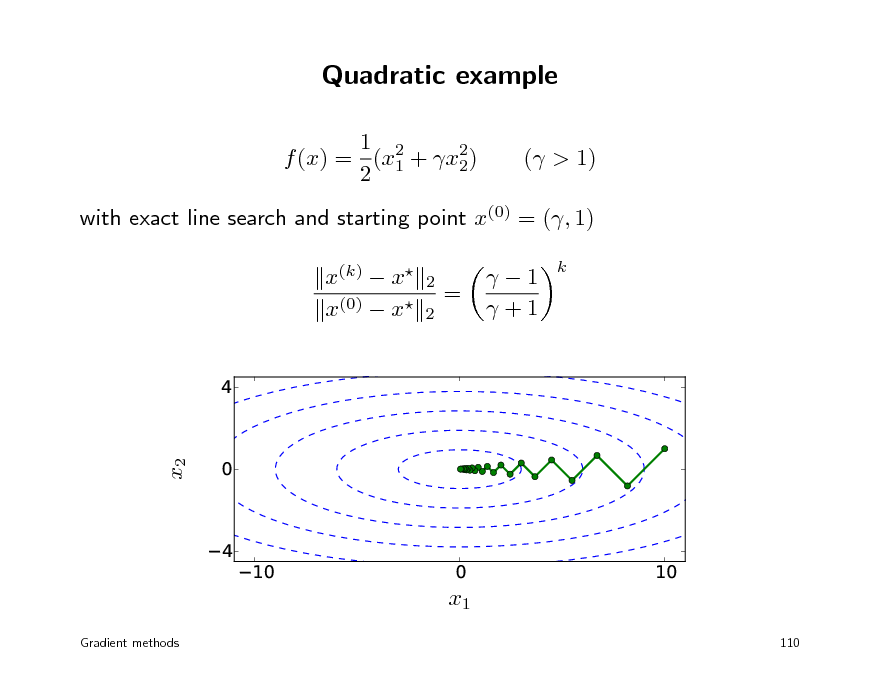
Quadratic example
1 2 f (x) = (x1 + x2) 2 2 ( > 1)
with exact line search and starting point x(0) = (, 1) x(k) x x(0) x
4 0 4
2 2
=
1 +1
k
x2
10
0 x1
10
110
Gradient methods
126
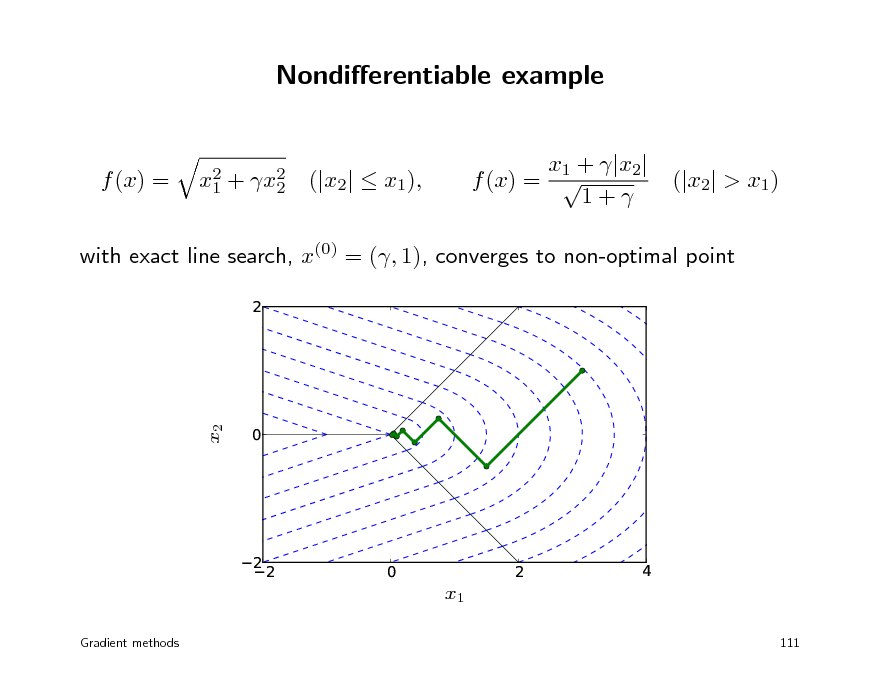
Nondierentiable example
x1 + |x2| f (x) = 1+
f (x) =
x2 + x2 1 2
(|x2| x1),
(|x2| > x1)
with exact line search, x(0) = (, 1), converges to non-optimal point
2
0
x2
22
0
2
4
x1
Gradient methods 111
127
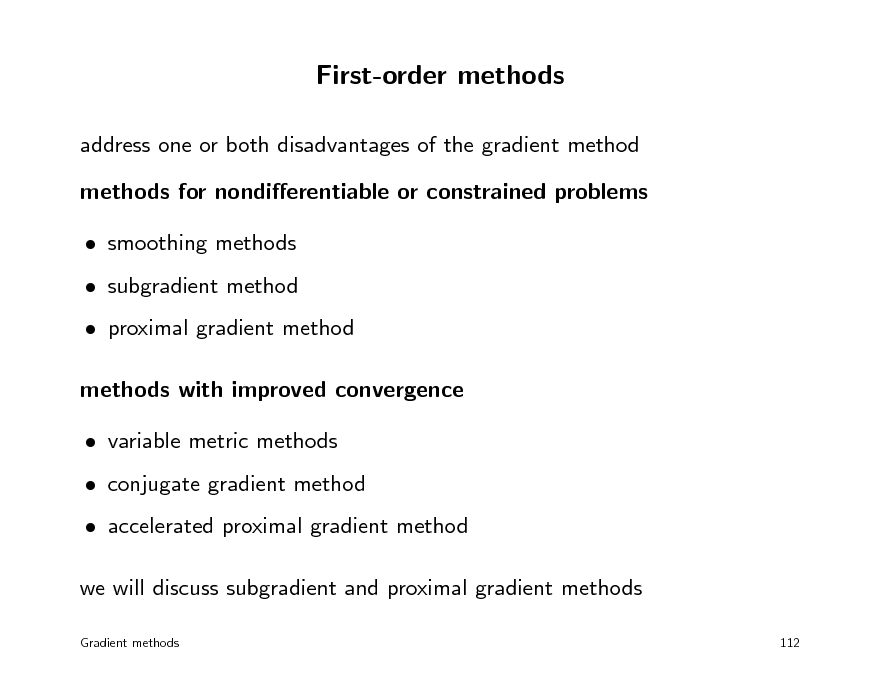
First-order methods
address one or both disadvantages of the gradient method methods for nondierentiable or constrained problems smoothing methods subgradient method proximal gradient method methods with improved convergence variable metric methods conjugate gradient method accelerated proximal gradient method we will discuss subgradient and proximal gradient methods
Gradient methods 112
128
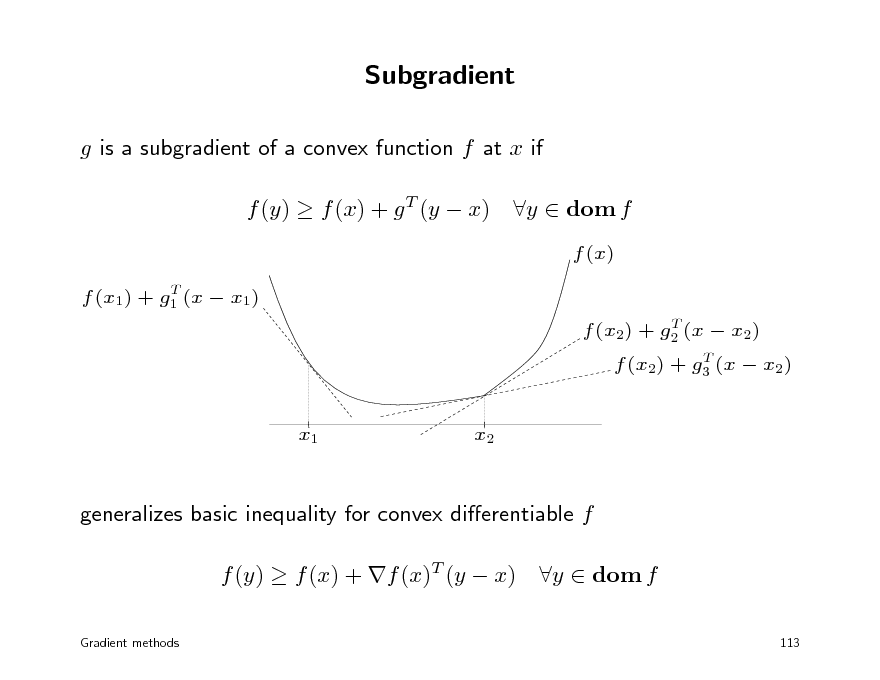
Subgradient
g is a subgradient of a convex function f at x if f (y) f (x) + g T (y x)
T f (x1) + g1 (x x1) T f (x2) + g2 (x x2) T f (x2) + g3 (x x2)
y dom f
f (x)
x1
x2
generalizes basic inequality for convex dierentiable f f (y) f (x) + f (x)T (y x)
Gradient methods
y dom f
113
129
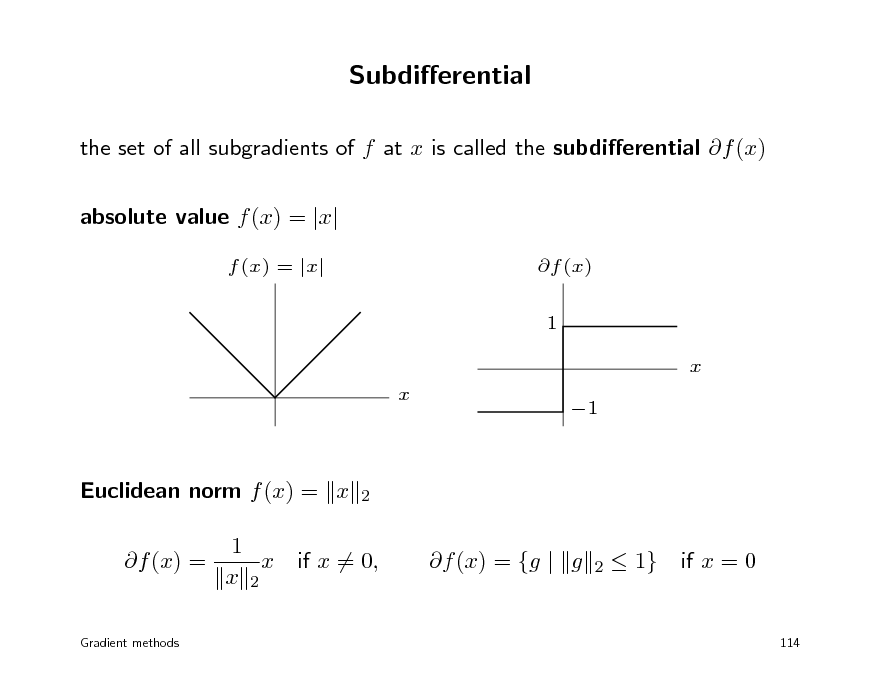
Subdierential
the set of all subgradients of f at x is called the subdierential f (x) absolute value f (x) = |x|
f (x) = |x| f (x) 1 x x 1
Euclidean norm f (x) = x f (x) = 1 x x 2
2
if x = 0,
f (x) = {g | g
2
1}
if x = 0
Gradient methods
114
130
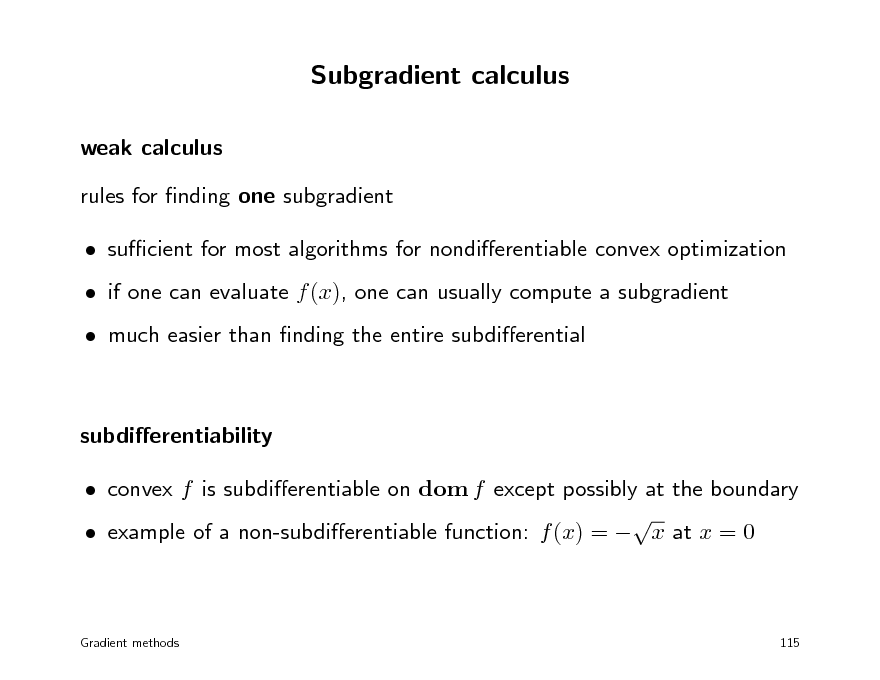
Subgradient calculus
weak calculus rules for nding one subgradient sucient for most algorithms for nondierentiable convex optimization if one can evaluate f (x), one can usually compute a subgradient much easier than nding the entire subdierential
subdierentiability convex f is subdierentiable on dom f except possibly at the boundary example of a non-subdierentiable function: f (x) = x at x = 0
Gradient methods
115
131
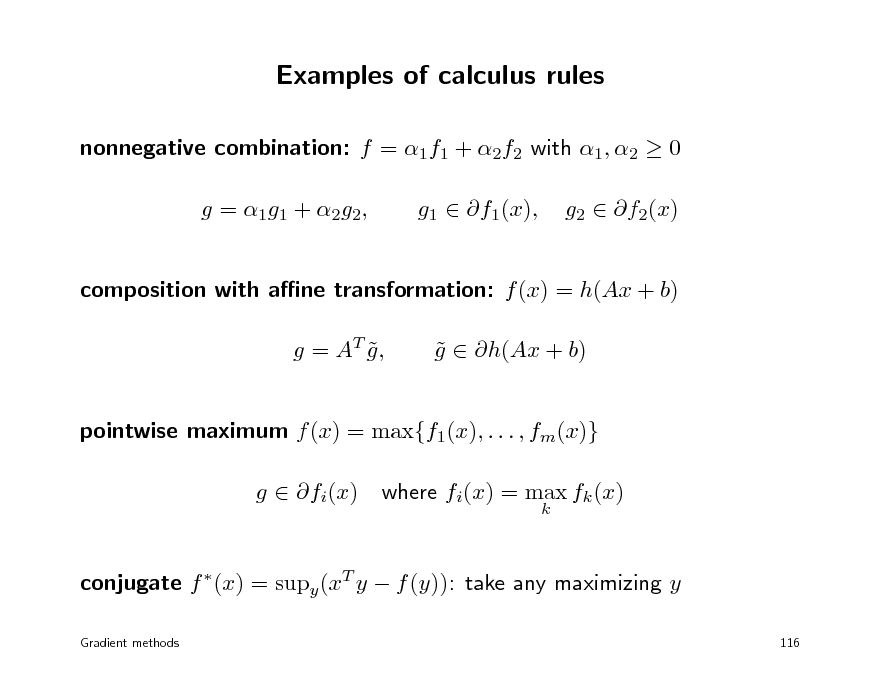
Examples of calculus rules
nonnegative combination: f = 1f1 + 2f2 with 1, 2 0 g = 1 g1 + 2 g2 , g1 f1(x), g2 f2(x)
composition with ane transformation: f (x) = h(Ax + b) g = AT g , g h(Ax + b)
pointwise maximum f (x) = max{f1(x), . . . , fm(x)} g fi(x) where fi(x) = max fk (x)
k
conjugate f (x) = supy (xT y f (y)): take any maximizing y
Gradient methods 116
132
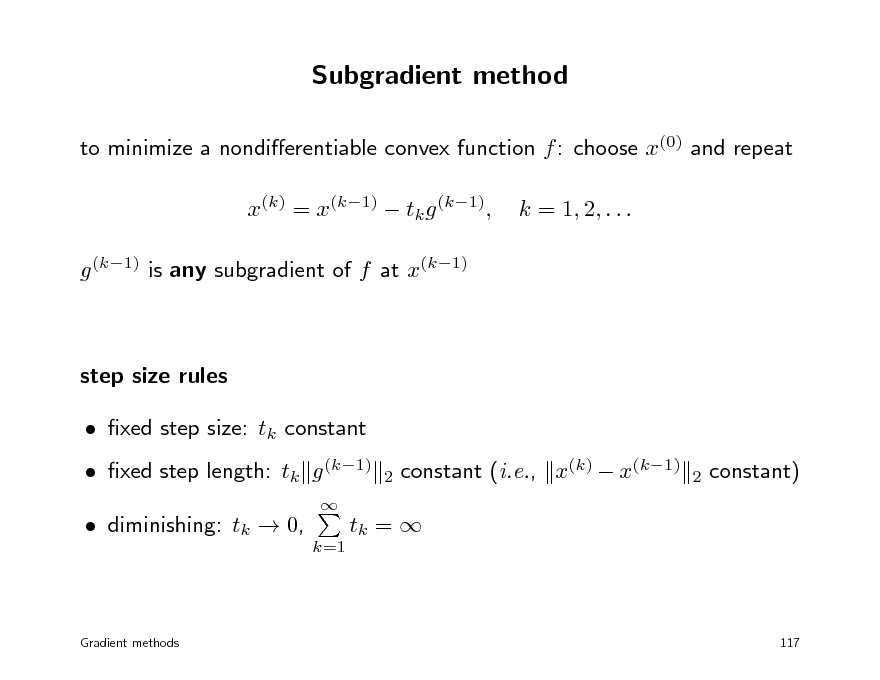
Subgradient method
to minimize a nondierentiable convex function f : choose x(0) and repeat x(k) = x(k1) tk g (k1), g (k1) is any subgradient of f at x(k1) k = 1, 2, . . .
step size rules xed step size: tk constant xed step length: tk g (k1)
2
constant (i.e., x(k) x(k1)
2
constant)
diminishing: tk 0,
k=1
tk =
Gradient methods
117
133
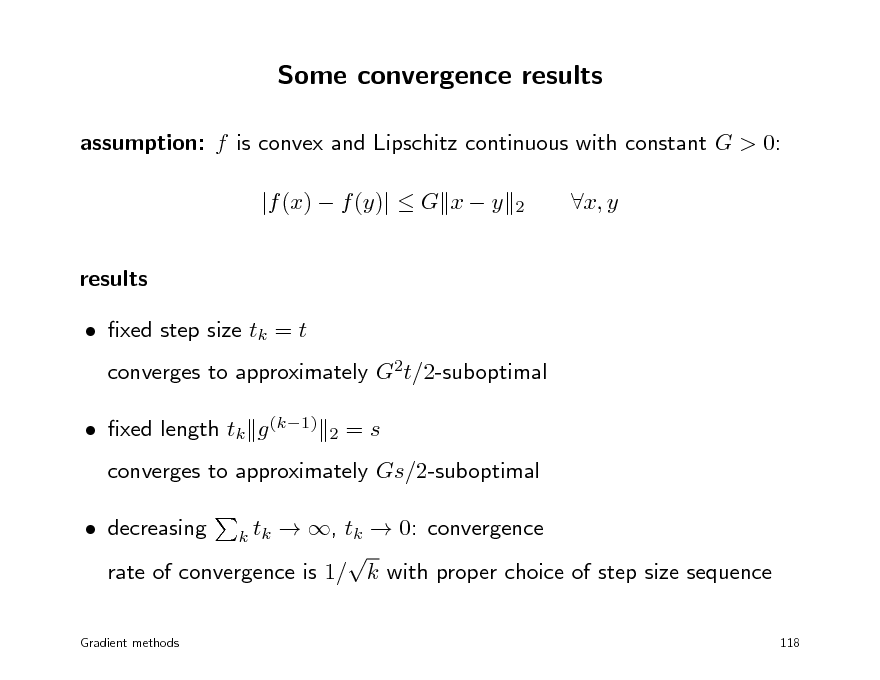
Some convergence results
assumption: f is convex and Lipschitz continuous with constant G > 0: |f (x) f (y)| G x y results xed step size tk = t
2
x, y
converges to approximately G2t/2-suboptimal
2
xed length tk g (k1)
=s
converges to approximately Gs/2-suboptimal decreasing , tk 0: convergence rate of convergence is 1/ k with proper choice of step size sequence
k tk
118
Gradient methods
134
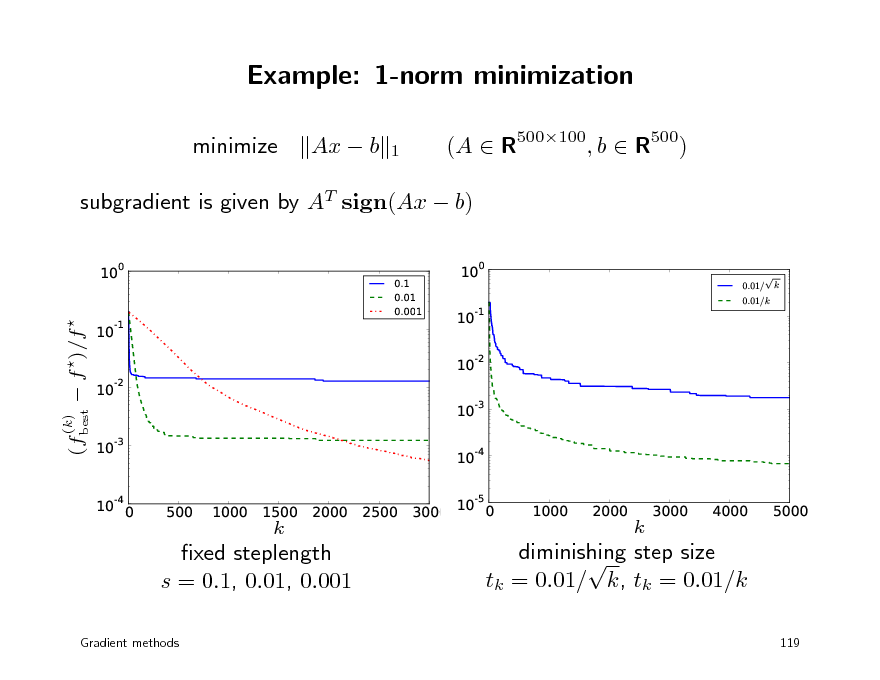
Example: 1-norm minimization
minimize Ax b
1
(A R500100, b R500)
subgradient is given by AT sign(Ax b)
10
0
0.1 0.01 0.001
10
0
0.01/ 0.01/k
k
(fbest f )/f
10
-1
10
-1
10 10
-2
-2
(k)
10 10
-3
-3
10
-4
10
-4
0
500
1000
1500
k
2000
2500
3000
10
-5
0
1000
2000
k
3000
4000
5000
xed steplength s = 0.1, 0.01, 0.001
Gradient methods
diminishing step size tk = 0.01/ k, tk = 0.01/k
119
135
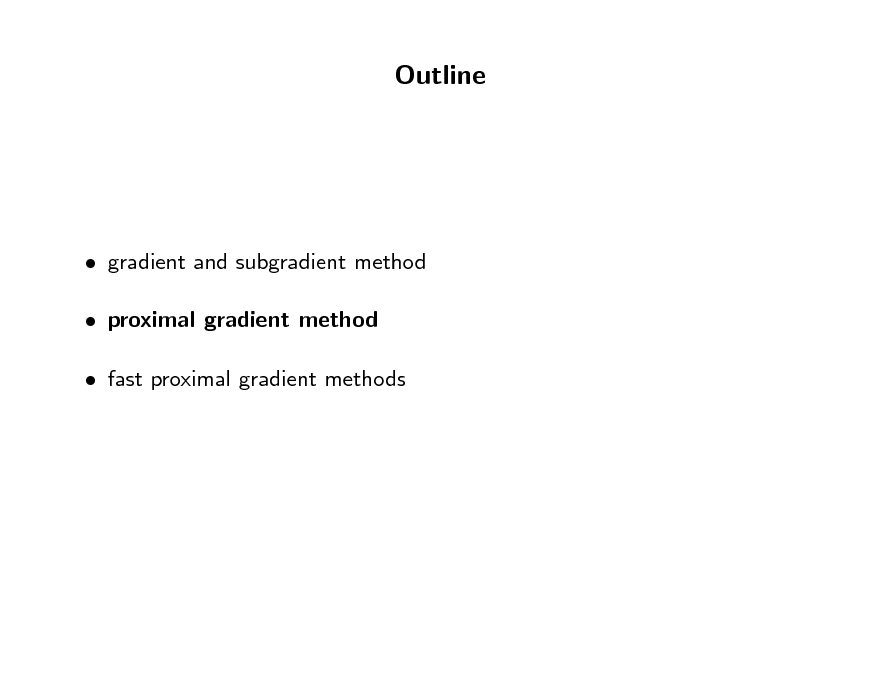
Outline
gradient and subgradient method proximal gradient method fast proximal gradient methods
136
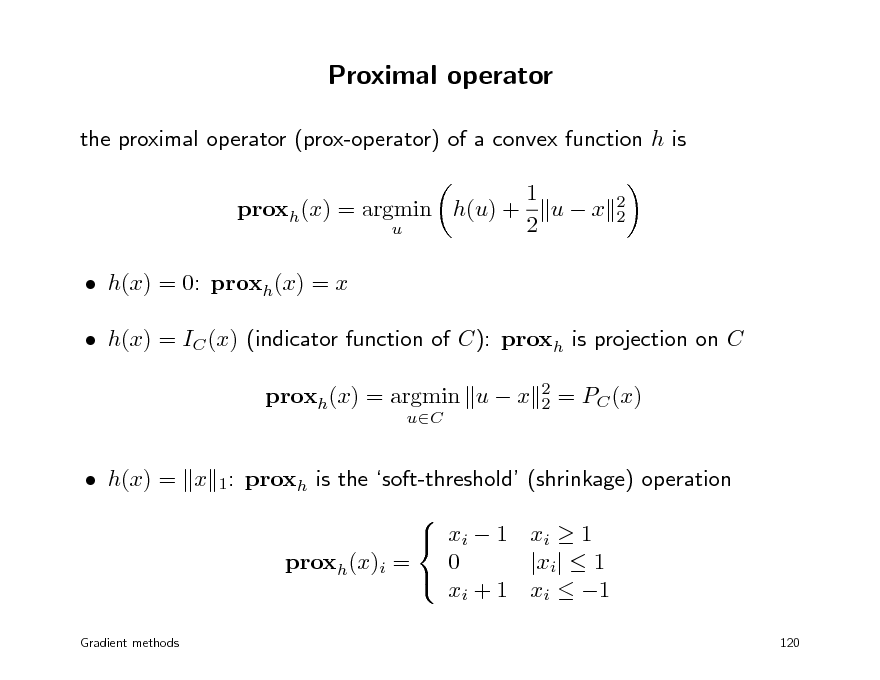
Proximal operator
the proximal operator (prox-operator) of a convex function h is proxh(x) = argmin h(u) +
u
1 ux 2
2 2
h(x) = 0: proxh(x) = x h(x) = IC (x) (indicator function of C): proxh is projection on C proxh(x) = argmin u x
uC 2 2
= PC (x)
h(x) = x 1: proxh is the soft-threshold (shrinkage) operation xi 1 xi 1 0 |xi| 1 proxh(x)i = xi + 1 xi 1
Gradient methods
120
137
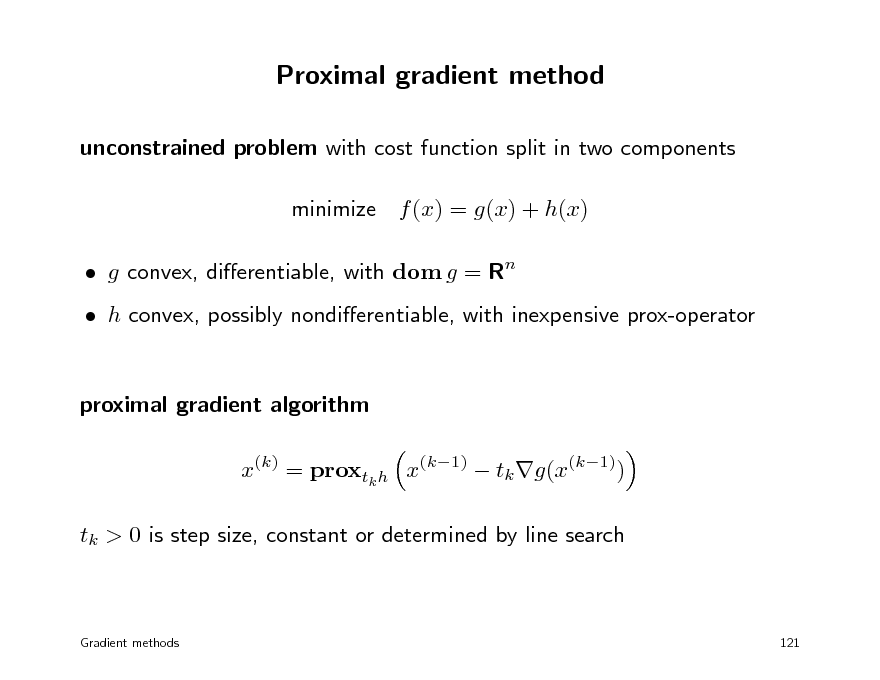
Proximal gradient method
unconstrained problem with cost function split in two components minimize f (x) = g(x) + h(x) g convex, dierentiable, with dom g = Rn h convex, possibly nondierentiable, with inexpensive prox-operator proximal gradient algorithm x(k) = proxtk h x(k1) tk g(x(k1)) tk > 0 is step size, constant or determined by line search
Gradient methods
121
138
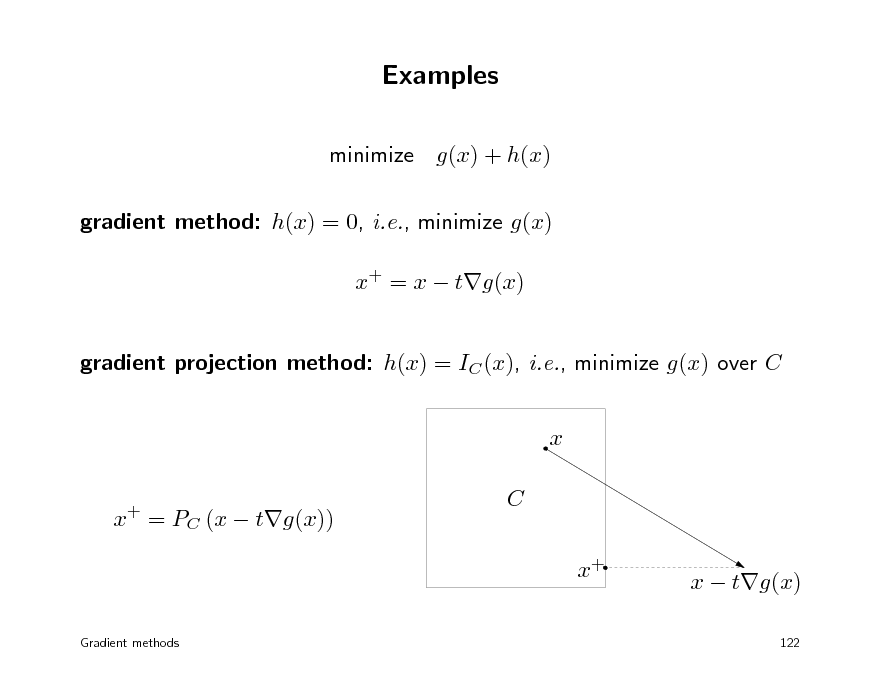
Examples
minimize g(x) + h(x) gradient method: h(x) = 0, i.e., minimize g(x) x+ = x tg(x) gradient projection method: h(x) = IC (x), i.e., minimize g(x) over C x x = PC (x tg(x))
+
C x+
x tg(x)
122
Gradient methods
139
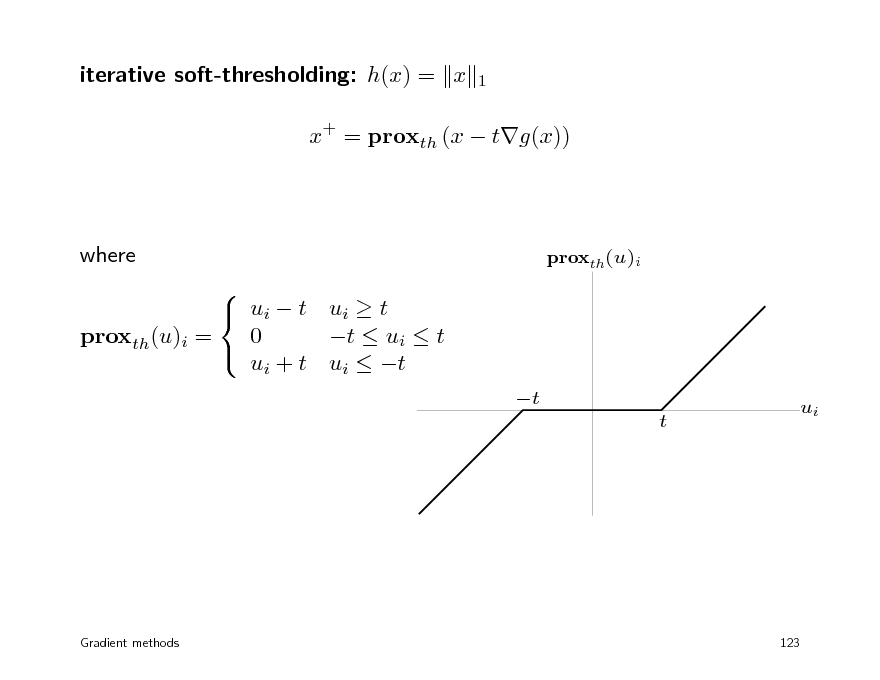
iterative soft-thresholding: h(x) = x
1
x+ = proxth (x tg(x))
where ui t ui t 0 t ui t proxth(u)i = ui + t ui t
proxth(u)i
t t
ui
Gradient methods
123
140
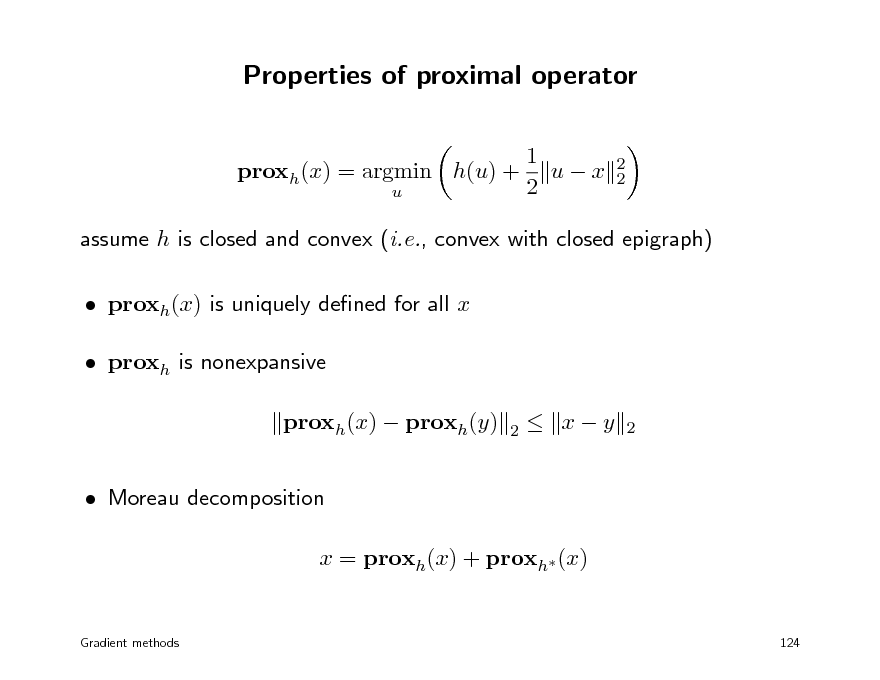
Properties of proximal operator
1 proxh(x) = argmin h(u) + u x 2 u
2 2
assume h is closed and convex (i.e., convex with closed epigraph) proxh(x) is uniquely dened for all x proxh is nonexpansive proxh(x) proxh(y) Moreau decomposition x = proxh(x) + proxh (x)
2
xy
2
Gradient methods
124
141
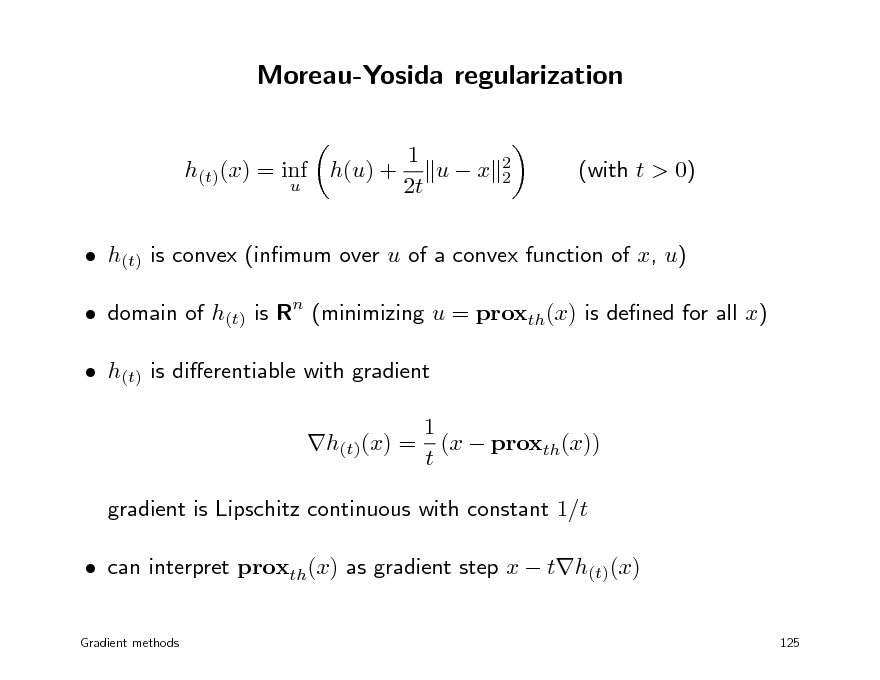
Moreau-Yosida regularization
1 ux 2t
2 2
h(t)(x) = inf h(u) +
u
(with t > 0)
h(t) is convex (inmum over u of a convex function of x, u) domain of h(t) is Rn (minimizing u = proxth(x) is dened for all x) h(t) is dierentiable with gradient 1 h(t)(x) = (x proxth(x)) t gradient is Lipschitz continuous with constant 1/t can interpret proxth(x) as gradient step x th(t)(x)
Gradient methods 125
142
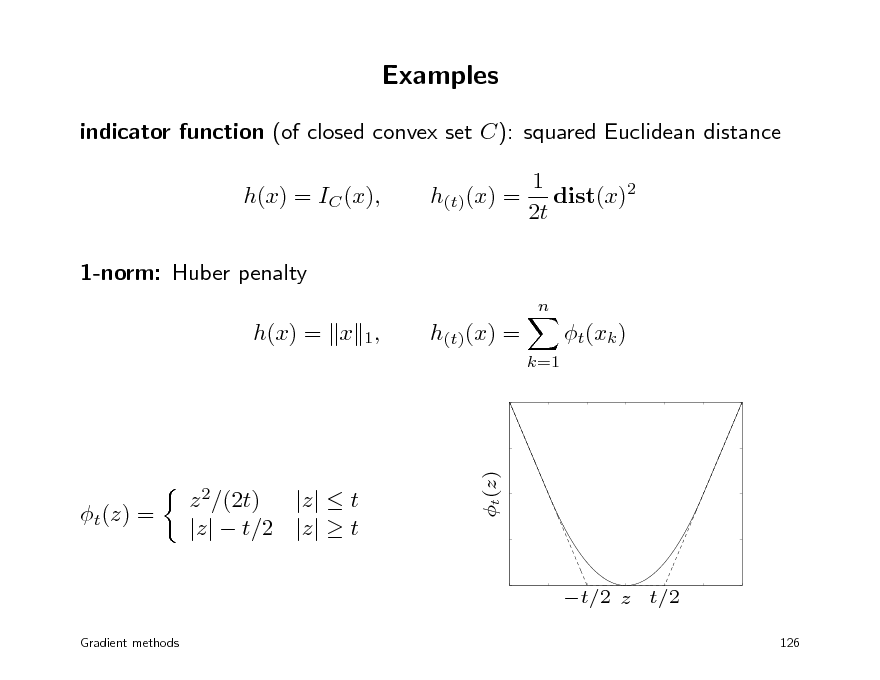
Examples
indicator function (of closed convex set C): squared Euclidean distance h(x) = IC (x), 1-norm: Huber penalty
n
h(t)(x) =
1 dist(x)2 2t
h(x) = x 1,
h(t)(x) =
k=1
t(xk )
t(z) =
z 2/(2t) |z| t |z| t/2 |z| t
t(z)
t/2 z t/2
Gradient methods 126
143
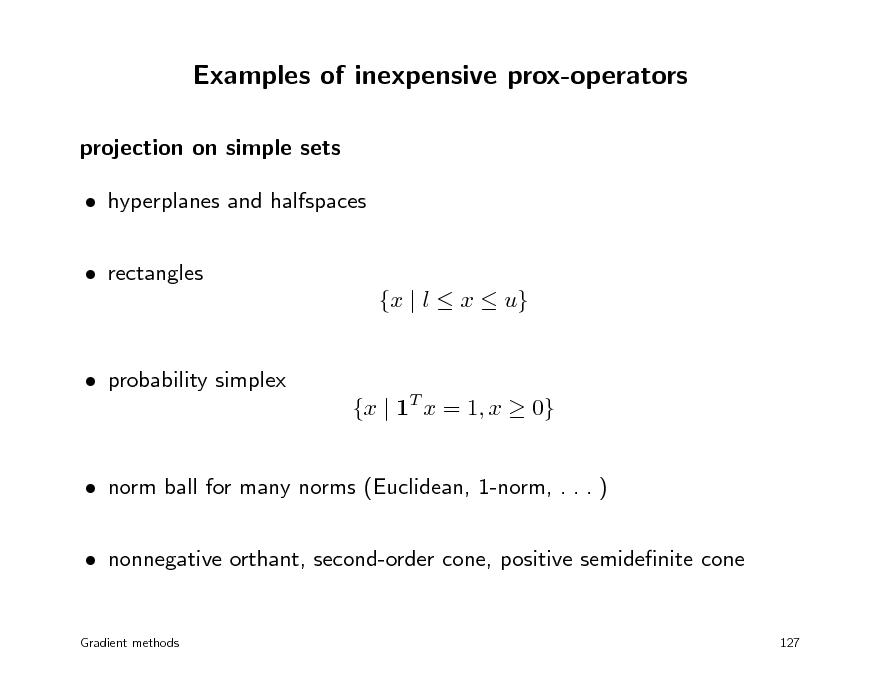
Examples of inexpensive prox-operators
projection on simple sets hyperplanes and halfspaces rectangles
{x | l x u}
probability simplex
{x | 1T x = 1, x 0}
norm ball for many norms (Euclidean, 1-norm, . . . ) nonnegative orthant, second-order cone, positive semidenite cone
Gradient methods 127
144
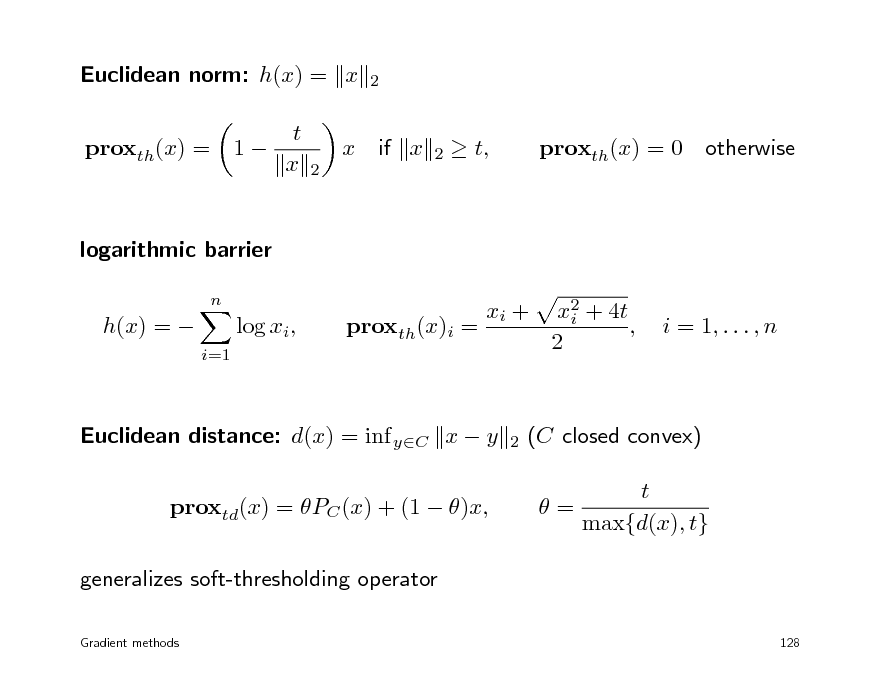
Euclidean norm: h(x) = x proxth(x) = 1 t x x
2
2
if x
2
t,
proxth(x) = 0
otherwise
logarithmic barrier
n
h(x) =
log xi,
i=1
proxth(x)i =
xi +
x2 + 4t i , 2
i = 1, . . . , n
Euclidean distance: d(x) = inf yC x y proxtd(x) = PC (x) + (1 )x, generalizes soft-thresholding operator
Gradient methods
2
(C closed convex) = t max{d(x), t}
128
145
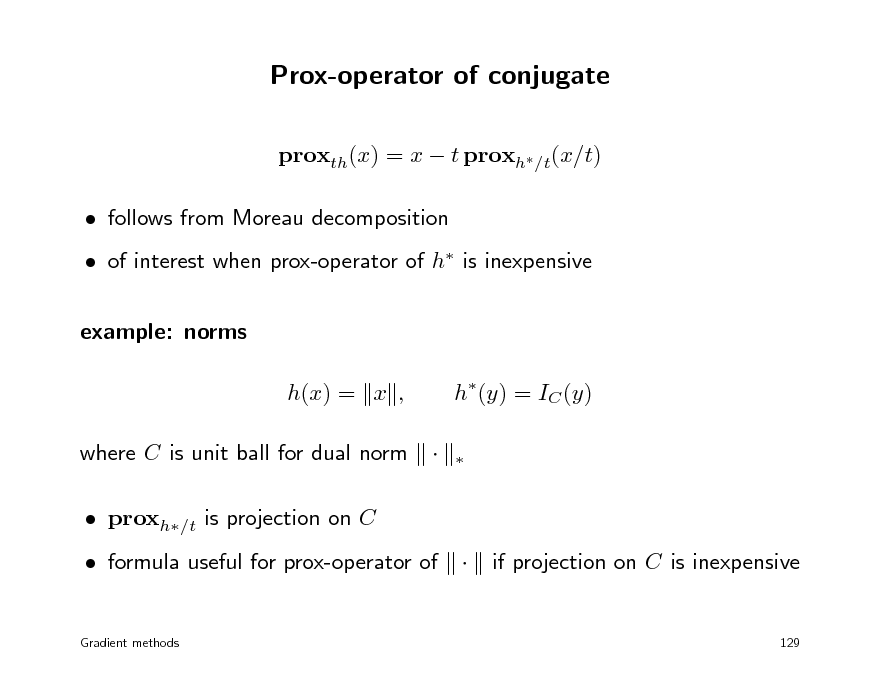
Prox-operator of conjugate
proxth(x) = x t proxh/t(x/t) follows from Moreau decomposition of interest when prox-operator of h is inexpensive example: norms h(x) = x , where C is unit ball for dual norm proxh/t is projection on C formula useful for prox-operator of
Gradient methods
h(y) = IC (y)
if projection on C is inexpensive
129
146
![Slide: Support function
many convex functions can be expressed as support functions h(x) = SC (x) = sup xT y
yC
with C closed, convex conjugate is indicator function of C: h(y) = IC (y) hence, can compute proxth via projection on C example: h(x) is sum of largest r components of x h(x) = x[1] + + x[r] = SC (x), C = {y | 0 y 1, 1T y = r}
Gradient methods
130](https://yosinski.com/mlss12/media/slides/MLSS-2012-Vandenberghe-Convex-Optimization_147.png)
Support function
many convex functions can be expressed as support functions h(x) = SC (x) = sup xT y
yC
with C closed, convex conjugate is indicator function of C: h(y) = IC (y) hence, can compute proxth via projection on C example: h(x) is sum of largest r components of x h(x) = x[1] + + x[r] = SC (x), C = {y | 0 y 1, 1T y = r}
Gradient methods
130
147
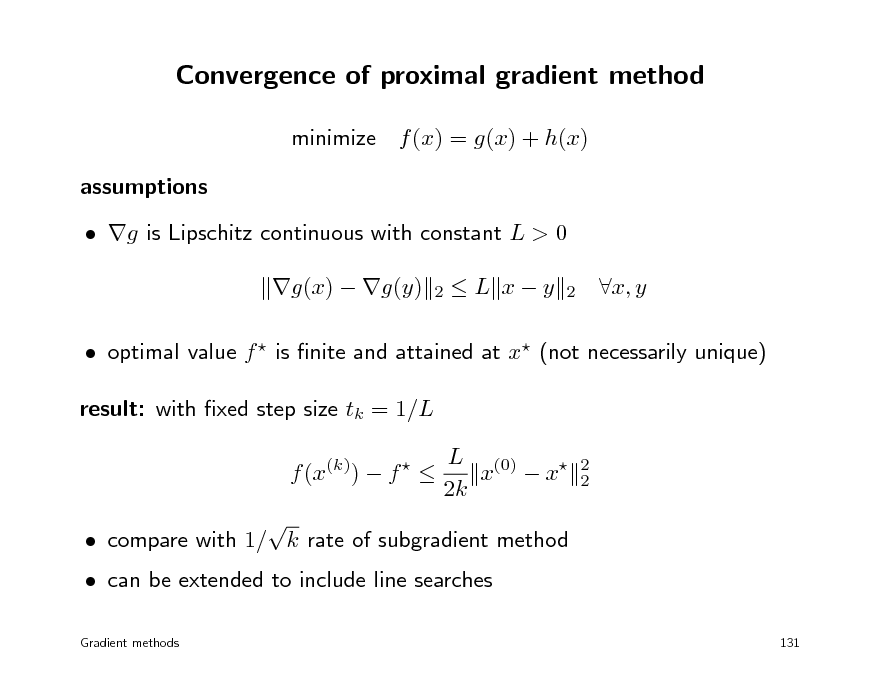
Convergence of proximal gradient method
minimize f (x) = g(x) + h(x) assumptions g is Lipschitz continuous with constant L > 0 g(x) g(y)
2
L xy
2
x, y
optimal value f is nite and attained at x (not necessarily unique) result: with xed step size tk = 1/L f (x(k)) f L (0) x x 2k
2 2
can be extended to include line searches
Gradient methods
compare with 1/ k rate of subgradient method
131
148
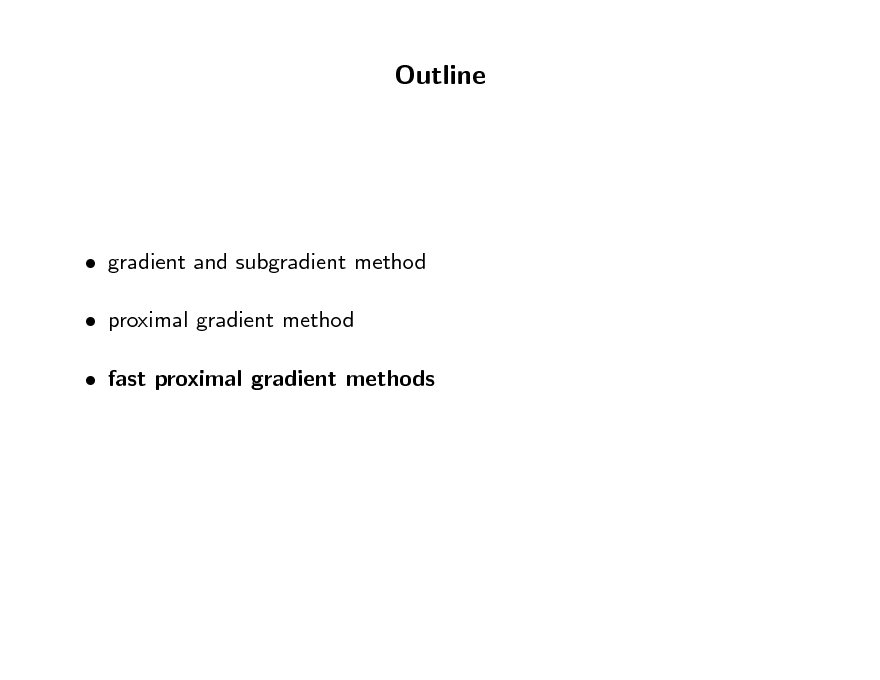
Outline
gradient and subgradient method proximal gradient method fast proximal gradient methods
149

Fast (proximal) gradient methods
Nesterov (1983, 1988, 2005): three gradient projection methods with 1/k 2 convergence rate Beck & Teboulle (2008): FISTA, a proximal gradient version of Nesterovs 1983 method Nesterov (2004 book), Tseng (2008): overview and unied analysis of fast gradient methods several recent variations and extensions this lecture: FISTA (Fast Iterative Shrinkage-Thresholding Algorithm)
Gradient methods
132
150
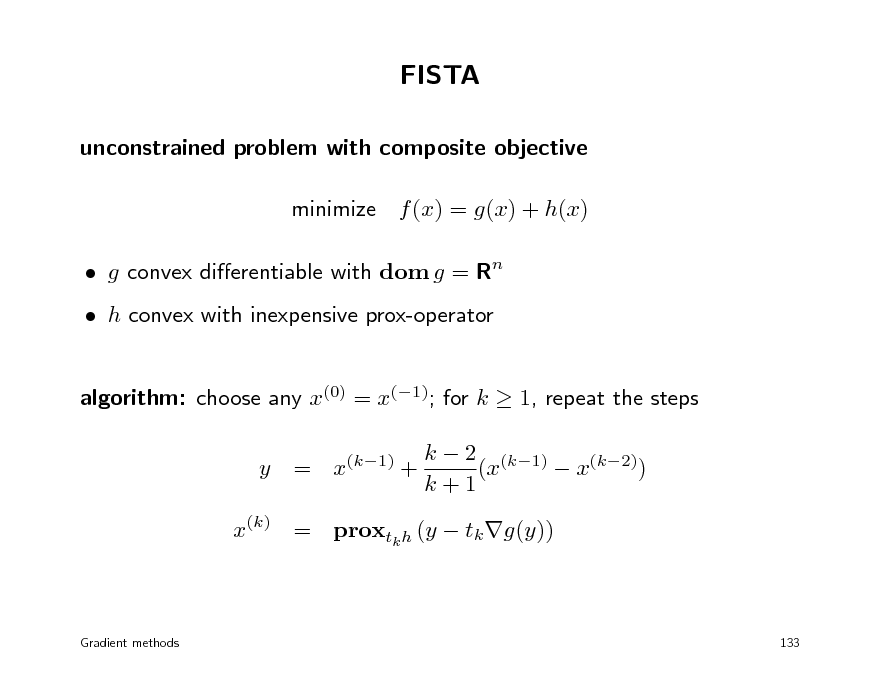
FISTA
unconstrained problem with composite objective minimize f (x) = g(x) + h(x) g convex dierentiable with dom g = Rn h convex with inexpensive prox-operator algorithm: choose any x(0) = x(1); for k 1, repeat the steps y = x(k1) + k 2 (k1) (x x(k2)) k+1
x(k) = proxtk h (y tk g(y))
Gradient methods
133
151
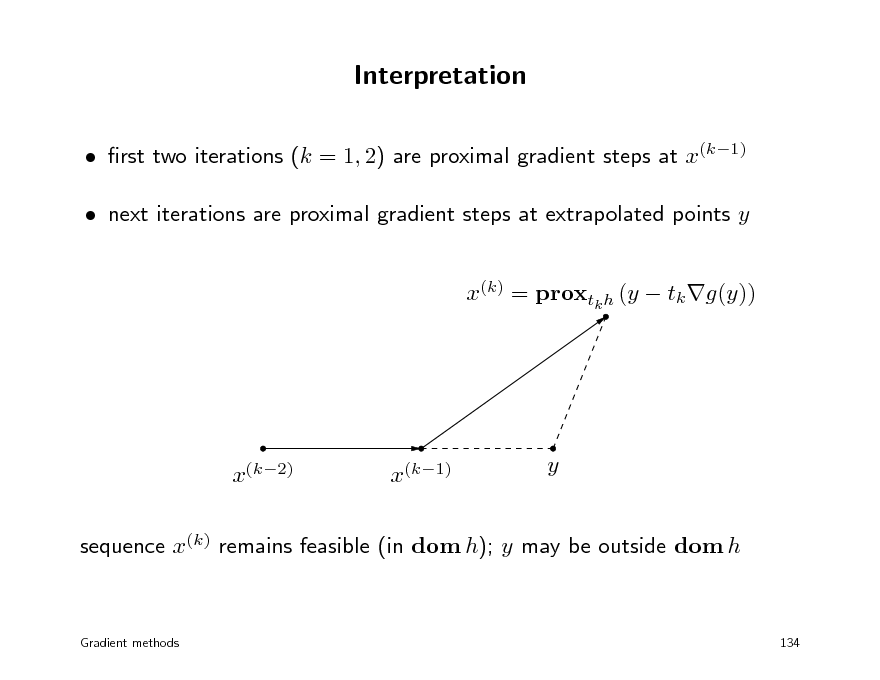
Interpretation
rst two iterations (k = 1, 2) are proximal gradient steps at x(k1) next iterations are proximal gradient steps at extrapolated points y x(k) = proxtk h (y tk g(y))
x(k2)
x(k1)
y
sequence x(k) remains feasible (in dom h); y may be outside dom h
Gradient methods
134
152
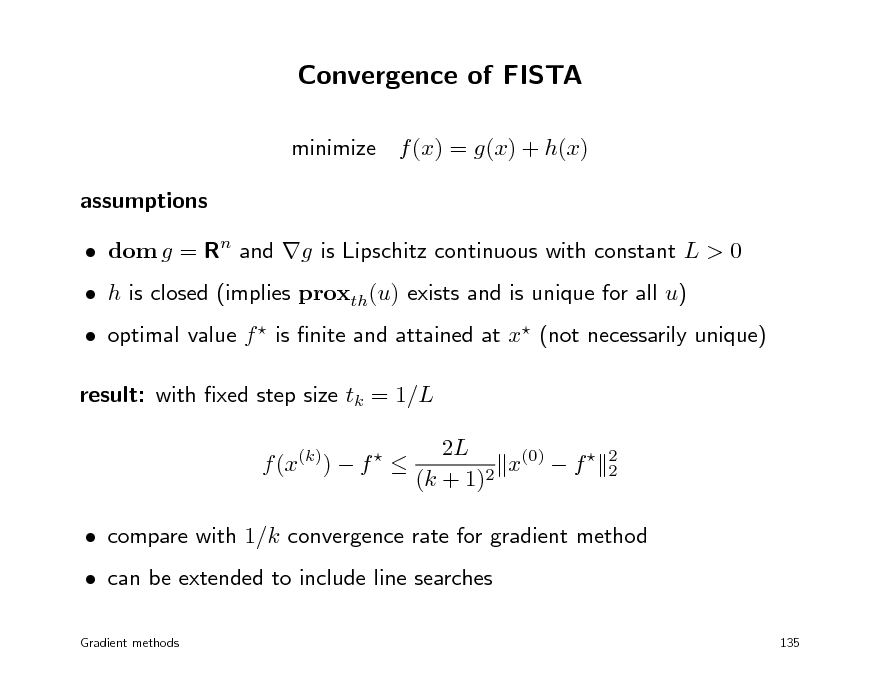
Convergence of FISTA
minimize f (x) = g(x) + h(x) assumptions dom g = Rn and g is Lipschitz continuous with constant L > 0 optimal value f is nite and attained at x (not necessarily unique) result: with xed step size tk = 1/L f (x(k)) f 2L x(0) f (k + 1)2
2 2
h is closed (implies proxth(u) exists and is unique for all u)
compare with 1/k convergence rate for gradient method can be extended to include line searches
Gradient methods 135
153
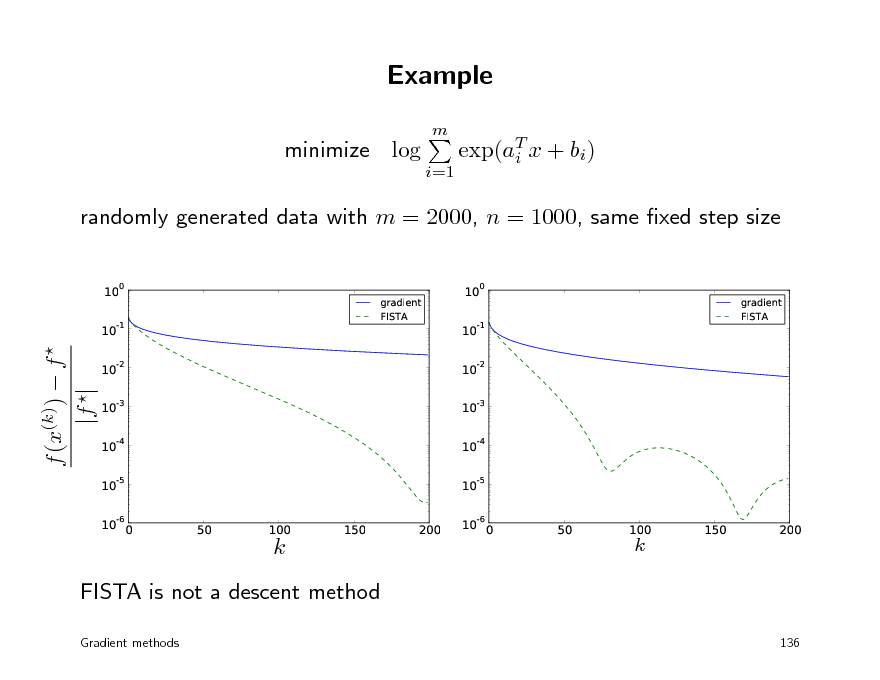
Example
m
minimize log
i=1
exp(aT x + bi) i
randomly generated data with m = 2000, n = 1000, same xed step size
100 10-1 100 10-1 10-2 10-3 10-4 10-5 50 100 150 200 10-6 0 50 100 150 200
gradient FISTA
gradient FISTA
f (x(k)) f |f |
10-2 10-3 10-4 10-5 10-6 0
k
k
FISTA is not a descent method
Gradient methods 136
154
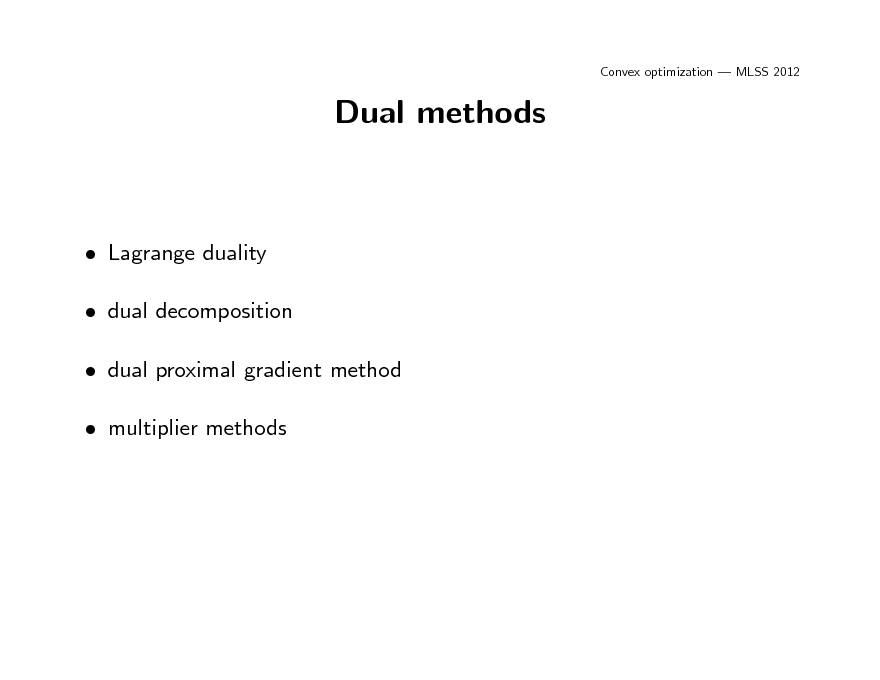
Convex optimization MLSS 2012
Dual methods
Lagrange duality dual decomposition dual proximal gradient method multiplier methods
155
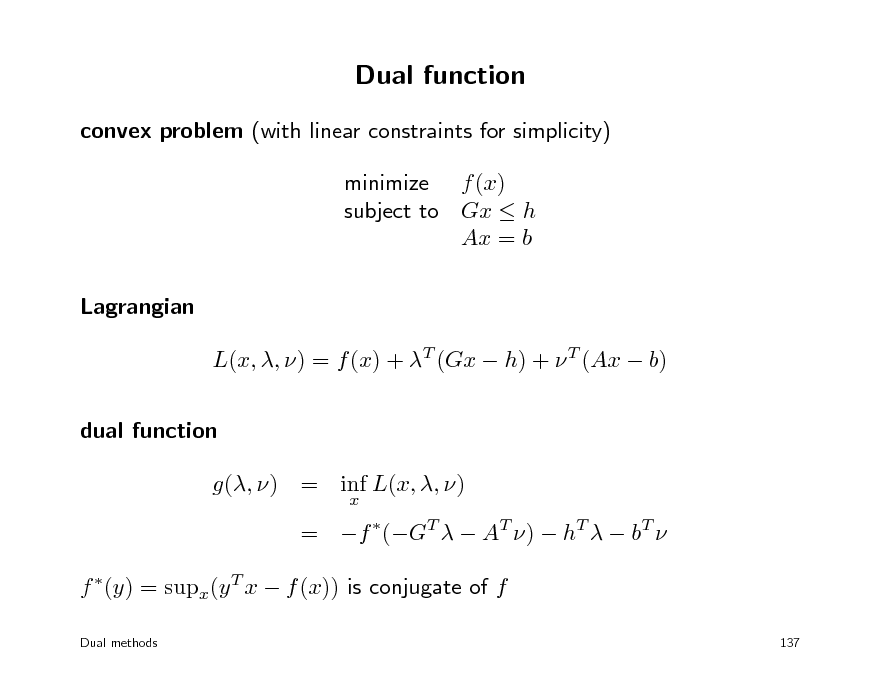
Dual function
convex problem (with linear constraints for simplicity) minimize f (x) subject to Gx h Ax = b Lagrangian L(x, , ) = f (x) + T (Gx h) + T (Ax b) dual function g(, ) = inf L(x, , )
x
= f (GT AT ) hT bT f (y) = supx(y T x f (x)) is conjugate of f
Dual methods 137
156
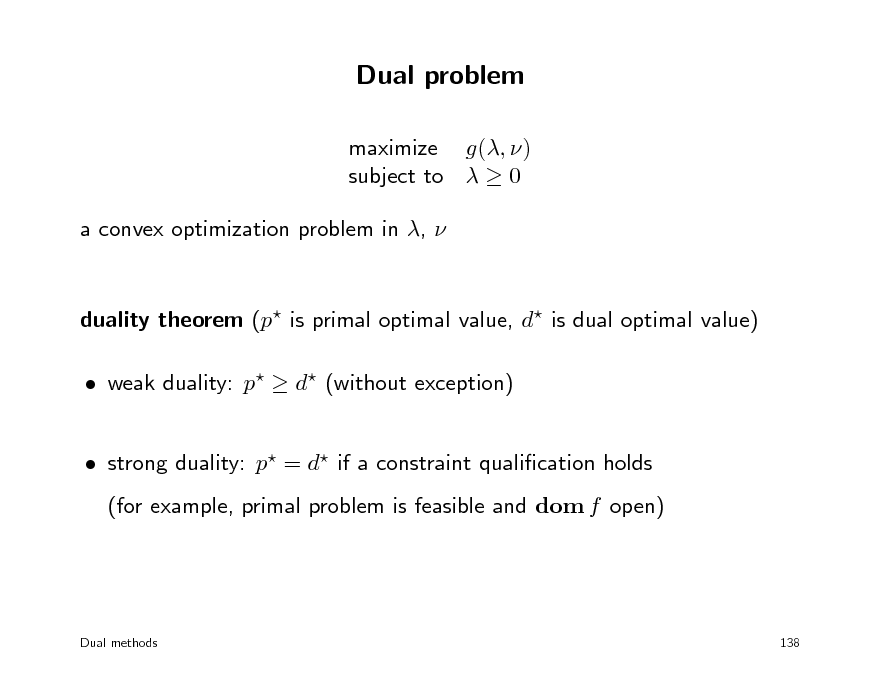
Dual problem
maximize g(, ) subject to 0 a convex optimization problem in ,
duality theorem (p is primal optimal value, d is dual optimal value) weak duality: p d (without exception) strong duality: p = d if a constraint qualication holds (for example, primal problem is feasible and dom f open)
Dual methods
138
157
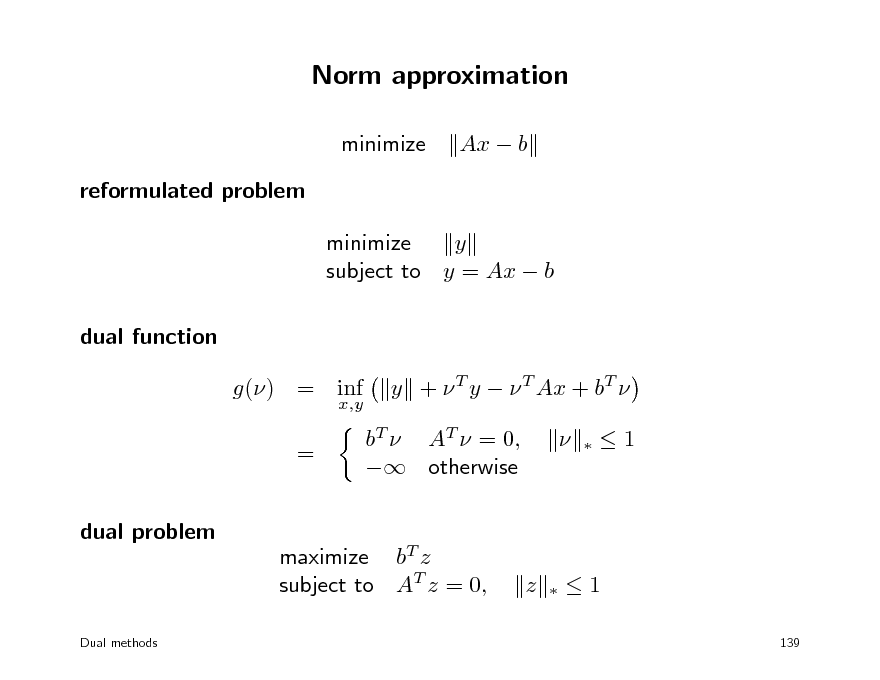
Norm approximation
minimize reformulated problem minimize y subject to y = Ax b dual function g() = inf = dual problem
x,y
Ax b
y + T y T Ax + bT bT AT = 0, otherwise
1
maximize bT z subject to AT z = 0,
z
1
139
Dual methods
158
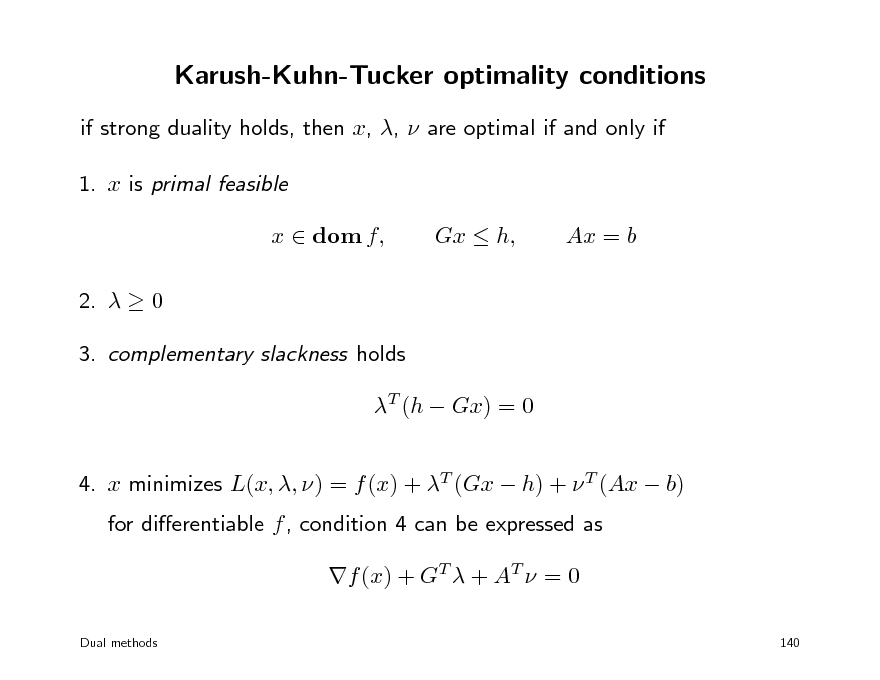
Karush-Kuhn-Tucker optimality conditions
if strong duality holds, then x, , are optimal if and only if 1. x is primal feasible x dom f, 2. 0 3. complementary slackness holds T (h Gx) = 0 4. x minimizes L(x, , ) = f (x) + T (Gx h) + T (Ax b) for dierentiable f , condition 4 can be expressed as f (x) + GT + AT = 0
Dual methods 140
Gx h,
Ax = b
159
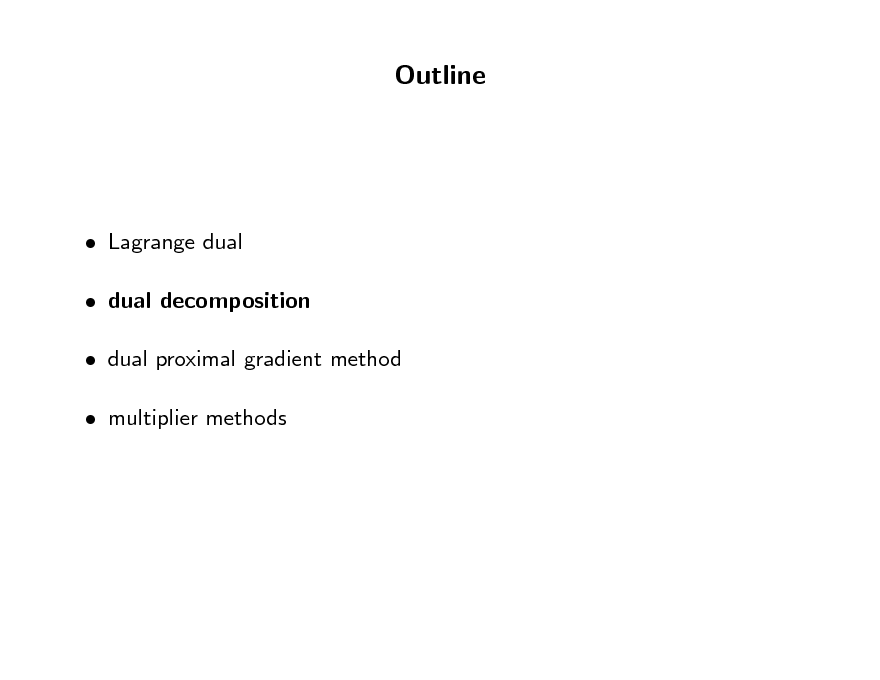
Outline
Lagrange dual dual decomposition dual proximal gradient method multiplier methods
160
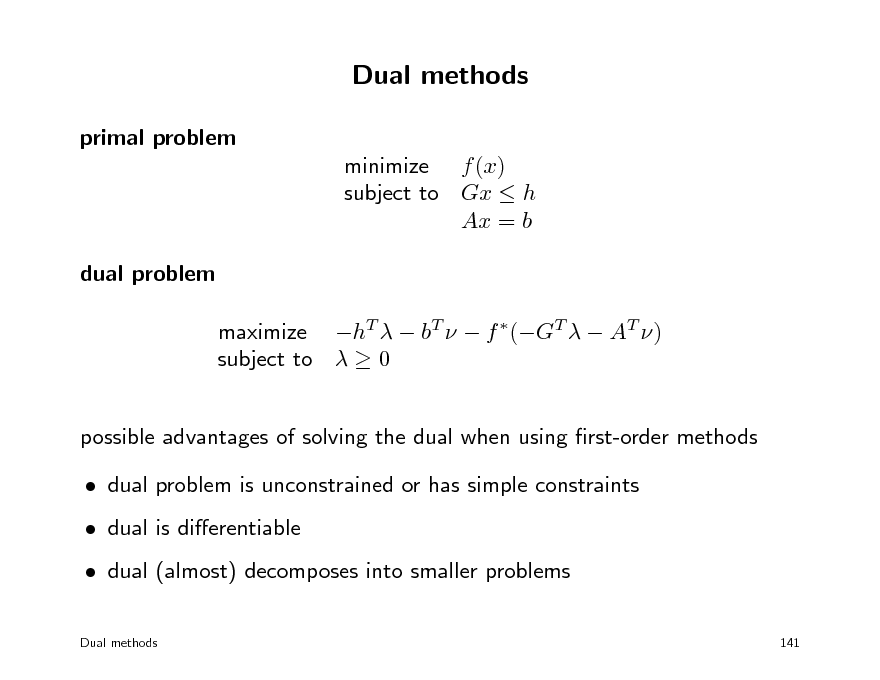
Dual methods
primal problem minimize f (x) subject to Gx h Ax = b dual problem maximize hT bT f (GT AT ) subject to 0 possible advantages of solving the dual when using rst-order methods dual problem is unconstrained or has simple constraints dual is dierentiable dual (almost) decomposes into smaller problems
Dual methods 141
161
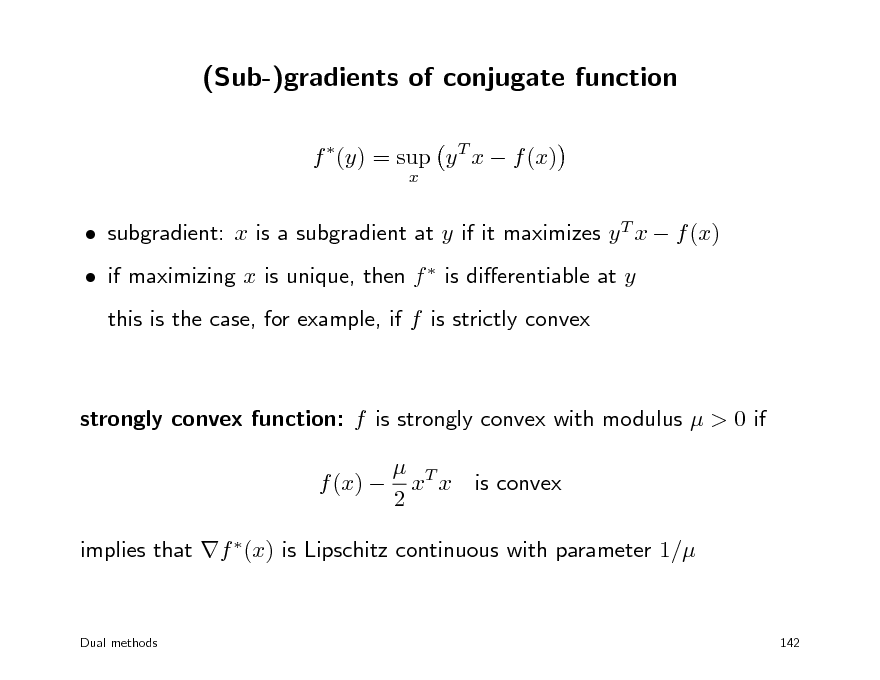
(Sub-)gradients of conjugate function
f (y) = sup y T x f (x)
x
subgradient: x is a subgradient at y if it maximizes y T x f (x) if maximizing x is unique, then f is dierentiable at y this is the case, for example, if f is strictly convex
strongly convex function: f is strongly convex with modulus > 0 if T f (x) x x 2 is convex
implies that f (x) is Lipschitz continuous with parameter 1/
Dual methods
142
162
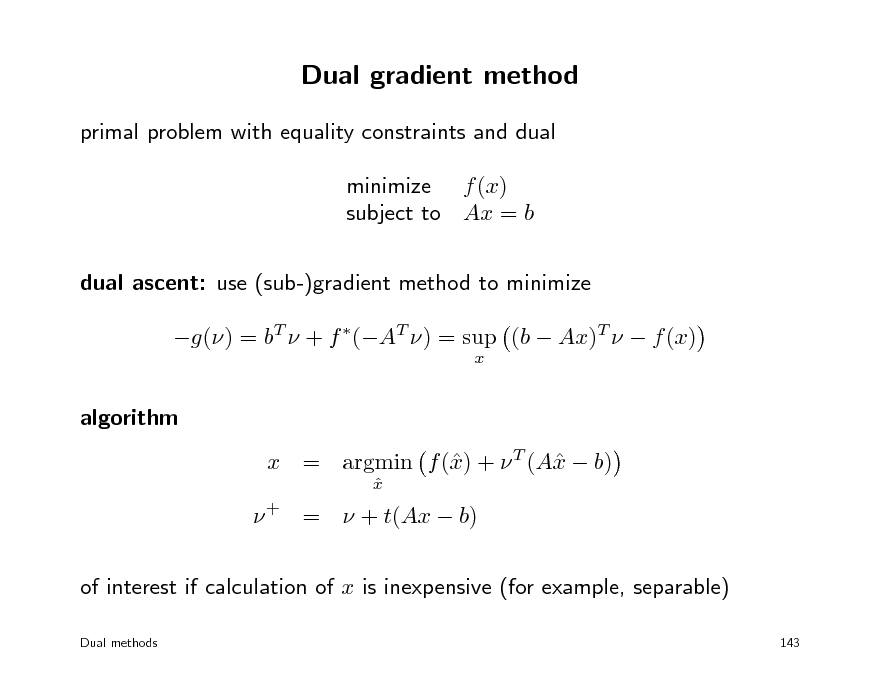
Dual gradient method
primal problem with equality constraints and dual minimize f (x) subject to Ax = b dual ascent: use (sub-)gradient method to minimize g() = bT + f (AT ) = sup (b Ax)T f (x)
x
algorithm x x x = argmin f () + T (A b)
x
+ = + t(Ax b) of interest if calculation of x is inexpensive (for example, separable)
Dual methods 143
163
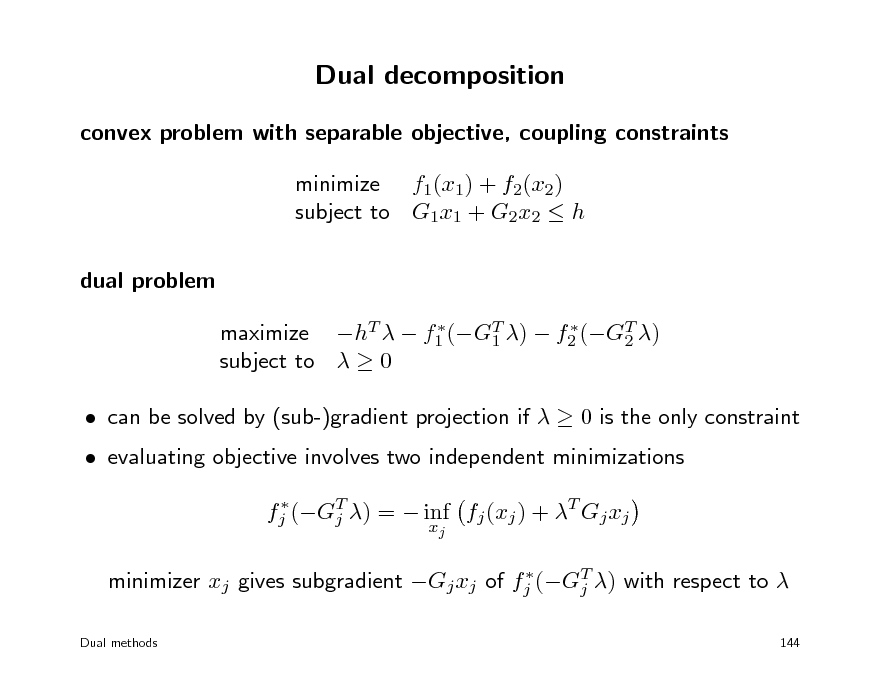
Dual decomposition
convex problem with separable objective, coupling constraints minimize f1(x1) + f2(x2) subject to G1x1 + G2x2 h dual problem
maximize hT f1 (GT ) f2 (GT ) 1 2 subject to 0
can be solved by (sub-)gradient projection if 0 is the only constraint evaluating objective involves two independent minimizations
fj (GT ) = inf fj (xj ) + T Gj xj j xj T minimizer xj gives subgradient Gj xj of fj (Gj ) with respect to
Dual methods 144
164
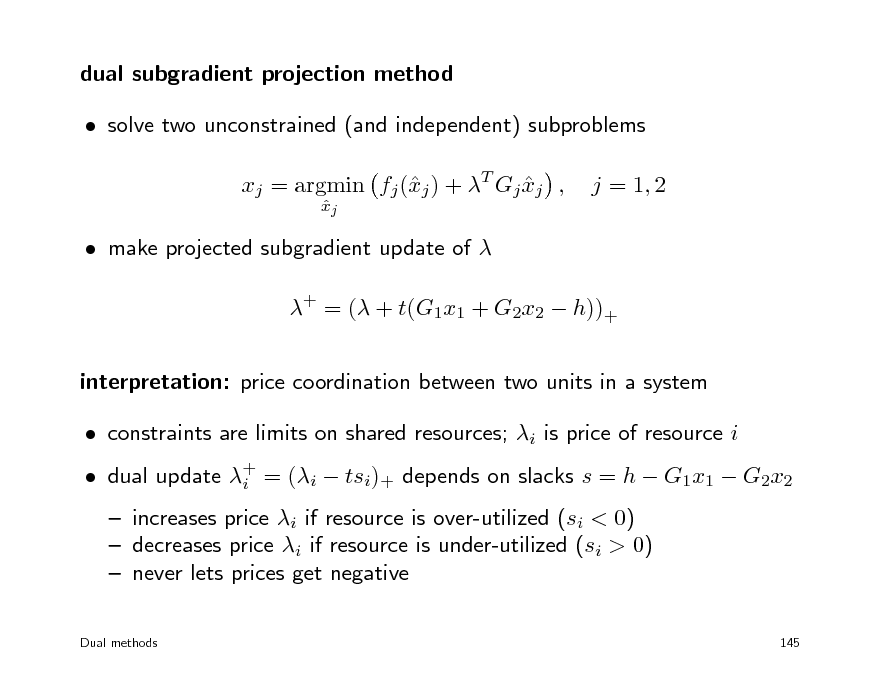
dual subgradient projection method solve two unconstrained (and independent) subproblems xj = argmin fj (j ) + T Gj xj , x
xj
j = 1, 2
make projected subgradient update of + = ( + t(G1x1 + G2x2 h))+ interpretation: price coordination between two units in a system constraints are limits on shared resources; i is price of resource i increases price i if resource is over-utilized (si < 0) decreases price i if resource is under-utilized (si > 0) never lets prices get negative
Dual methods 145
dual update + = (i tsi)+ depends on slacks s = h G1x1 G2x2 i
165
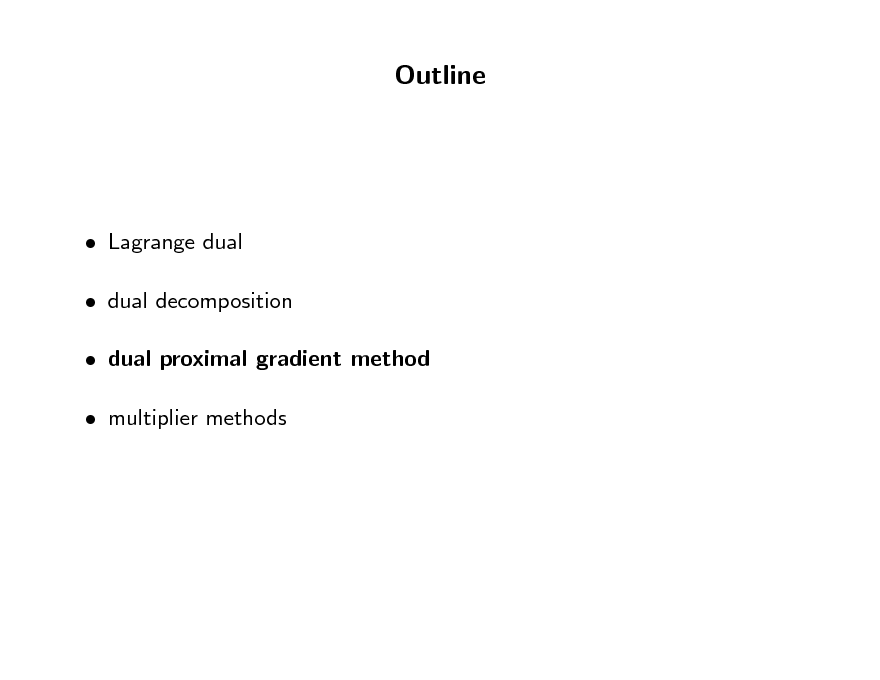
Outline
Lagrange dual dual decomposition dual proximal gradient method multiplier methods
166
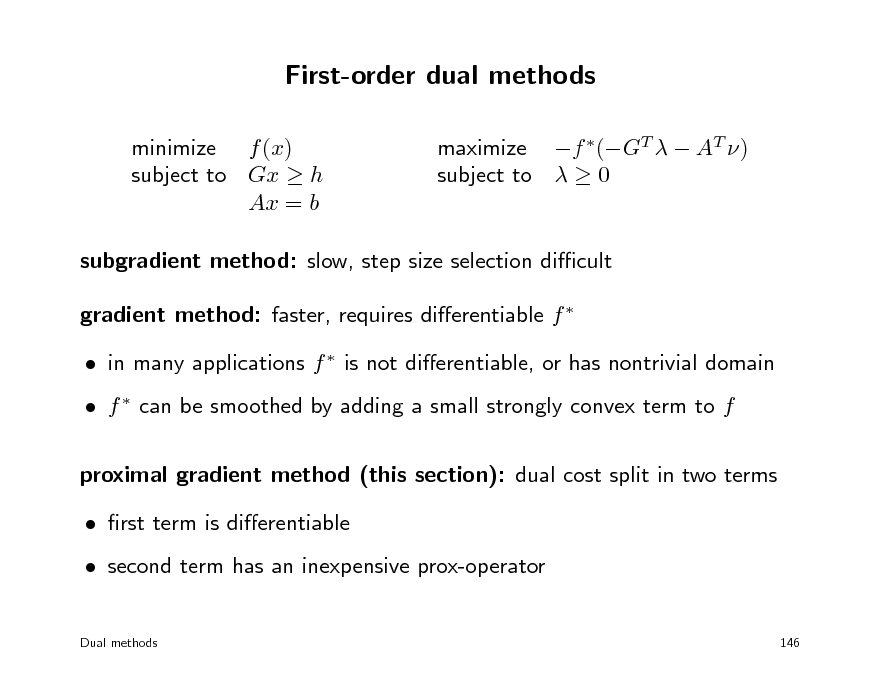
First-order dual methods
minimize f (x) subject to Gx h Ax = b maximize f (GT AT ) subject to 0
subgradient method: slow, step size selection dicult gradient method: faster, requires dierentiable f in many applications f is not dierentiable, or has nontrivial domain f can be smoothed by adding a small strongly convex term to f proximal gradient method (this section): dual cost split in two terms rst term is dierentiable second term has an inexpensive prox-operator
Dual methods 146
167
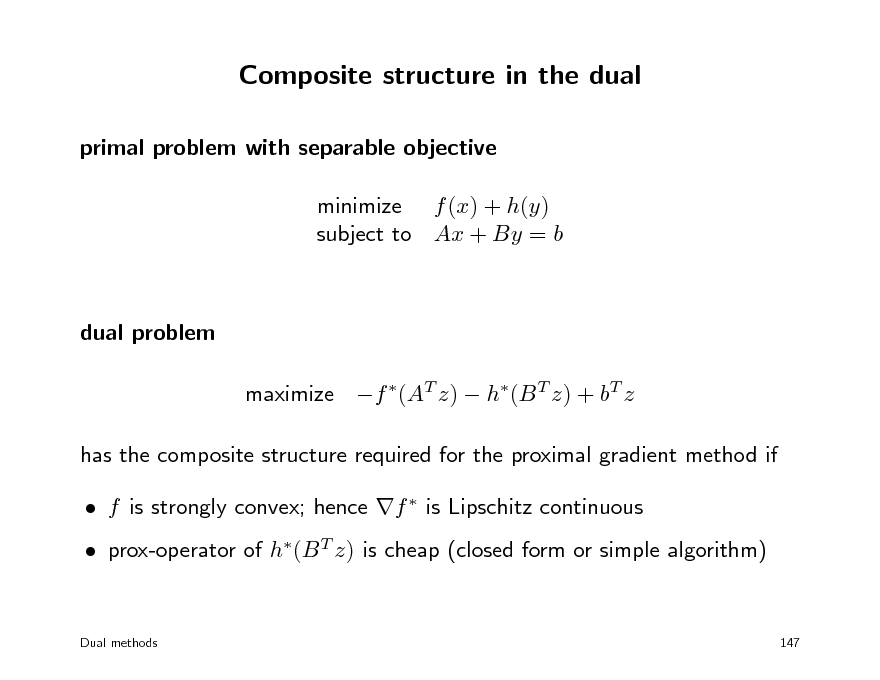
Composite structure in the dual
primal problem with separable objective minimize f (x) + h(y) subject to Ax + By = b
dual problem maximize f (AT z) h(B T z) + bT z has the composite structure required for the proximal gradient method if f is strongly convex; hence f is Lipschitz continuous prox-operator of h(B T z) is cheap (closed form or simple algorithm)
Dual methods
147
168
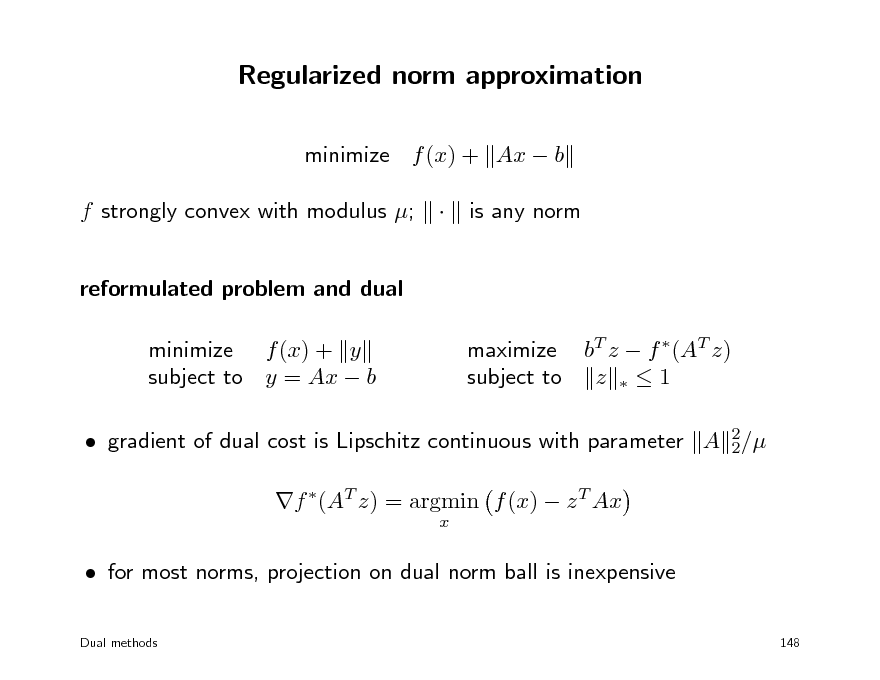
Regularized norm approximation
minimize f (x) + Ax b f strongly convex with modulus ; reformulated problem and dual minimize f (x) + y subject to y = Ax b maximize bT z f (AT z) subject to z 1 is any norm
gradient of dual cost is Lipschitz continuous with parameter A 2/ 2 f (AT z) = argmin f (x) z T Ax
x
for most norms, projection on dual norm ball is inexpensive
Dual methods 148
169
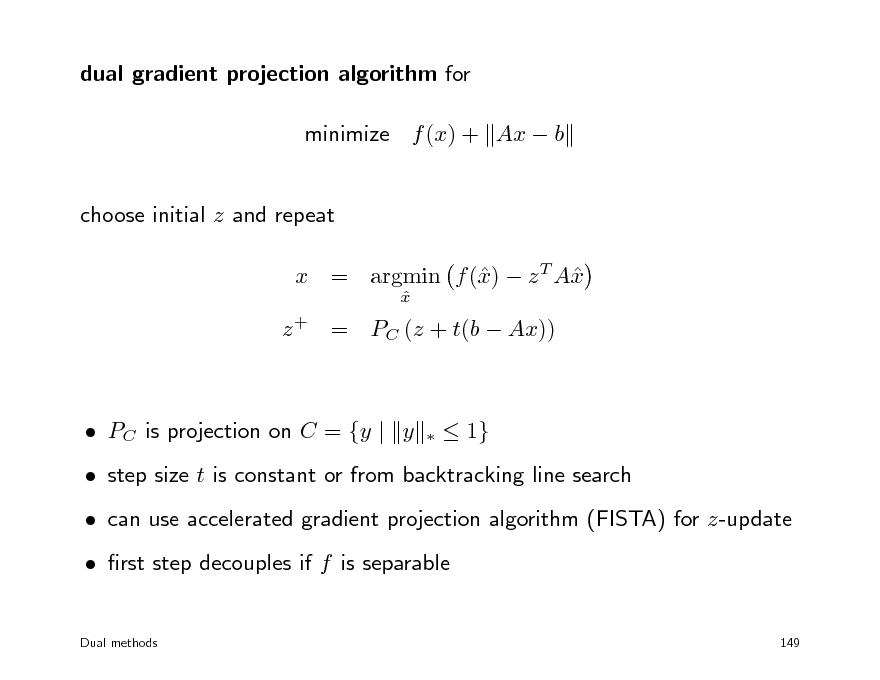
dual gradient projection algorithm for minimize f (x) + Ax b choose initial z and repeat x x x = argmin f () z T A
x
z + = PC (z + t(b Ax))
PC is projection on C = {y | y
1}
step size t is constant or from backtracking line search can use accelerated gradient projection algorithm (FISTA) for z-update rst step decouples if f is separable
Dual methods 149
170
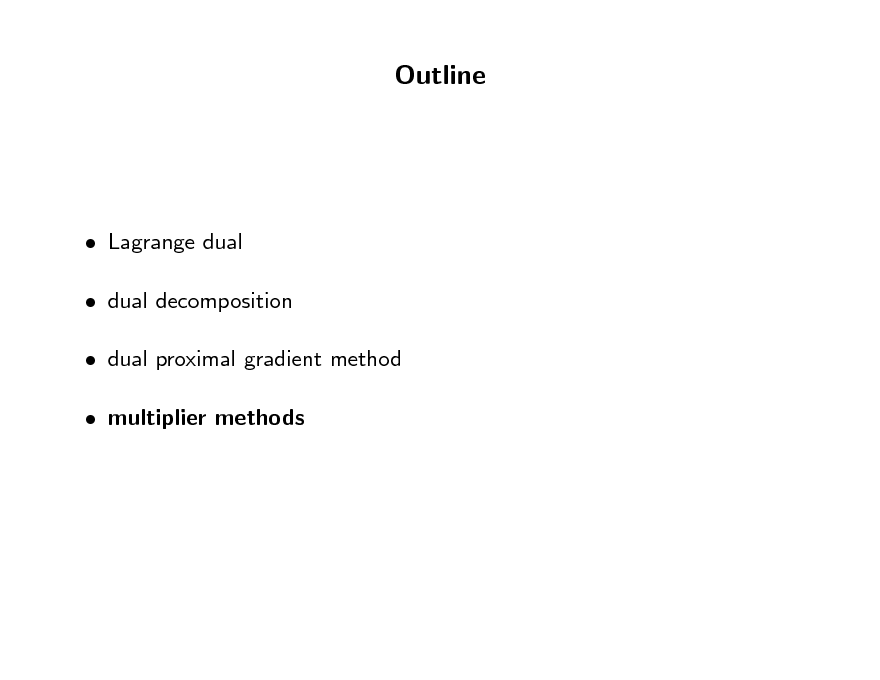
Outline
Lagrange dual dual decomposition dual proximal gradient method multiplier methods
171
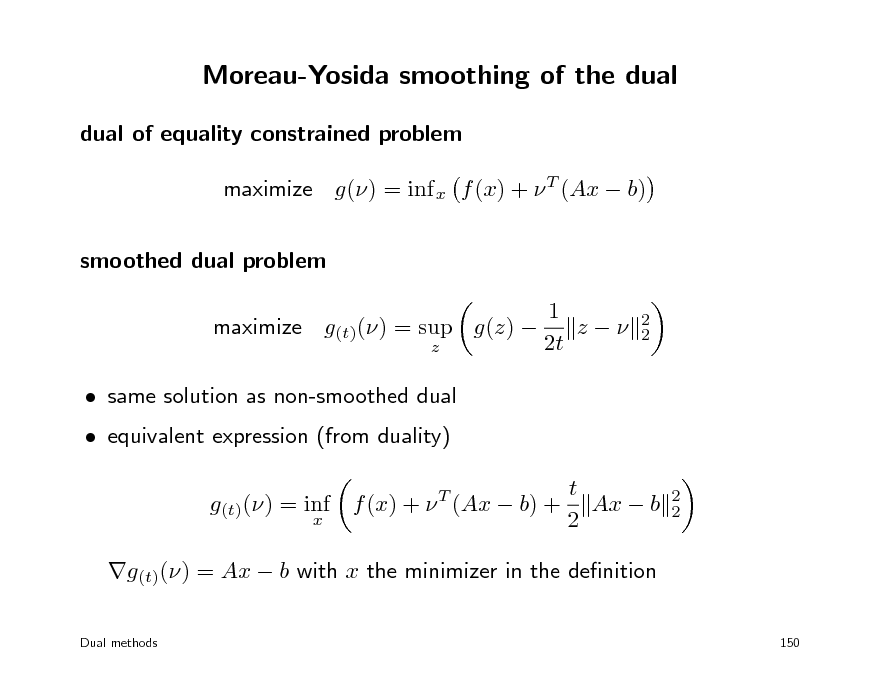
Moreau-Yosida smoothing of the dual
dual of equality constrained problem maximize g() = inf x f (x) + T (Ax b) smoothed dual problem 1 maximize g(t)() = sup g(z) z 2t z same solution as non-smoothed dual equivalent expression (from duality) g(t)() = inf f (x) + T (Ax b) +
x 2 2
t Ax b 2
2 2
g(t)() = Ax b with x the minimizer in the denition
Dual methods 150
172
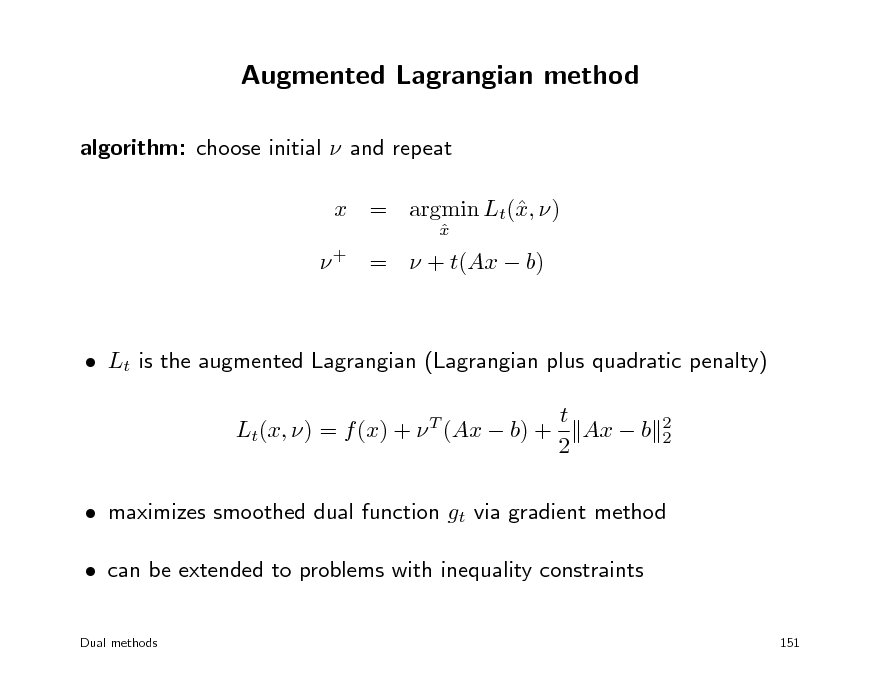
Augmented Lagrangian method
algorithm: choose initial and repeat x = argmin Lt(, ) x
x
+ = + t(Ax b)
Lt is the augmented Lagrangian (Lagrangian plus quadratic penalty) t Lt(x, ) = f (x) + (Ax b) + Ax b 2
T 2 2
maximizes smoothed dual function gt via gradient method can be extended to problems with inequality constraints
Dual methods 151
173
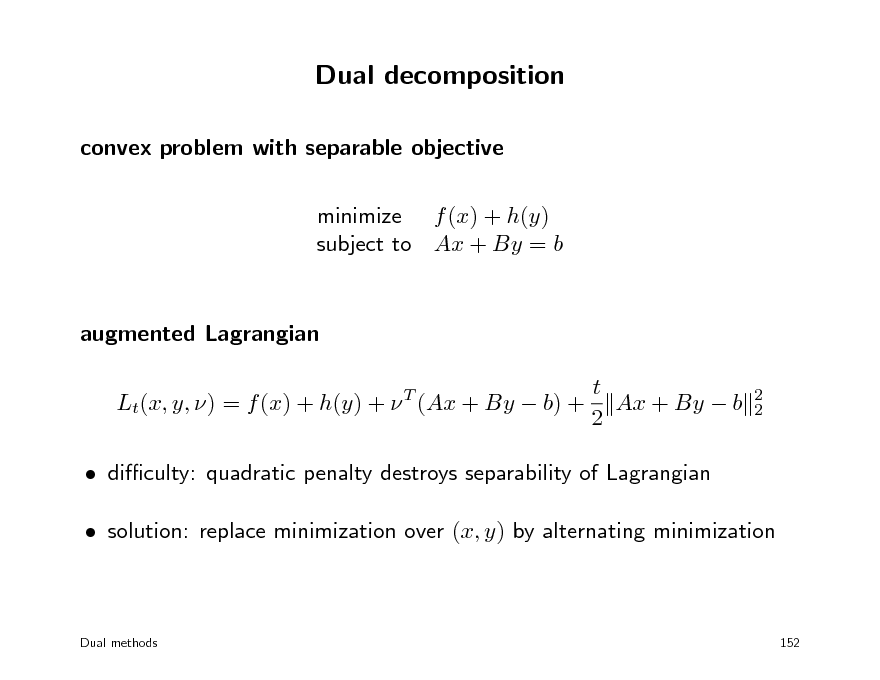
Dual decomposition
convex problem with separable objective minimize f (x) + h(y) subject to Ax + By = b
augmented Lagrangian t Lt(x, y, ) = f (x) + h(y) + (Ax + By b) + Ax + By b 2
T 2 2
diculty: quadratic penalty destroys separability of Lagrangian solution: replace minimization over (x, y) by alternating minimization
Dual methods
152
174
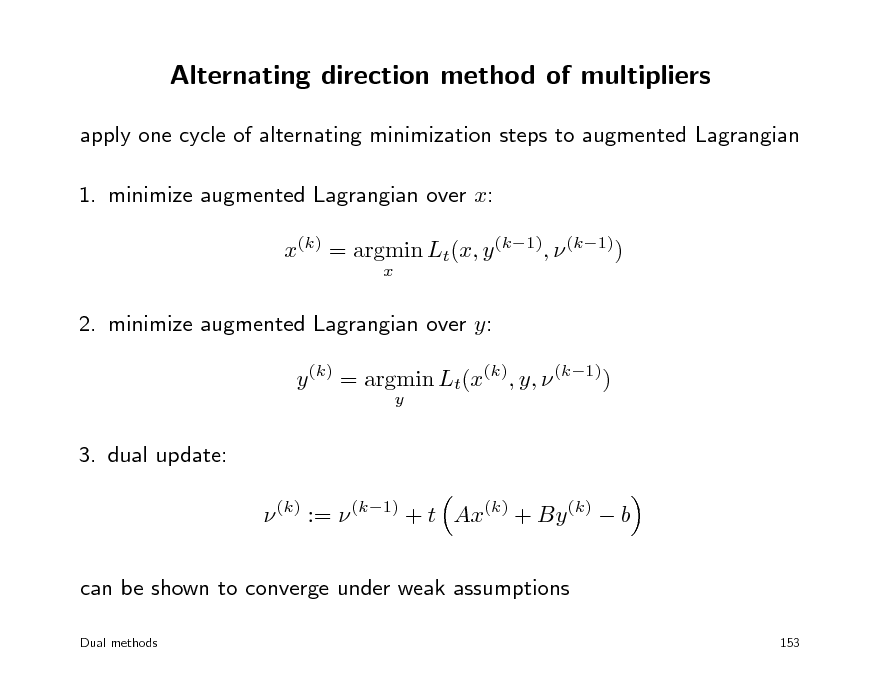
Alternating direction method of multipliers
apply one cycle of alternating minimization steps to augmented Lagrangian 1. minimize augmented Lagrangian over x: x(k) = argmin Lt(x, y (k1), (k1))
x
2. minimize augmented Lagrangian over y: y (k) = argmin Lt(x(k), y, (k1))
y
3. dual update: (k) := (k1) + t Ax(k) + By (k) b can be shown to converge under weak assumptions
Dual methods 153
175
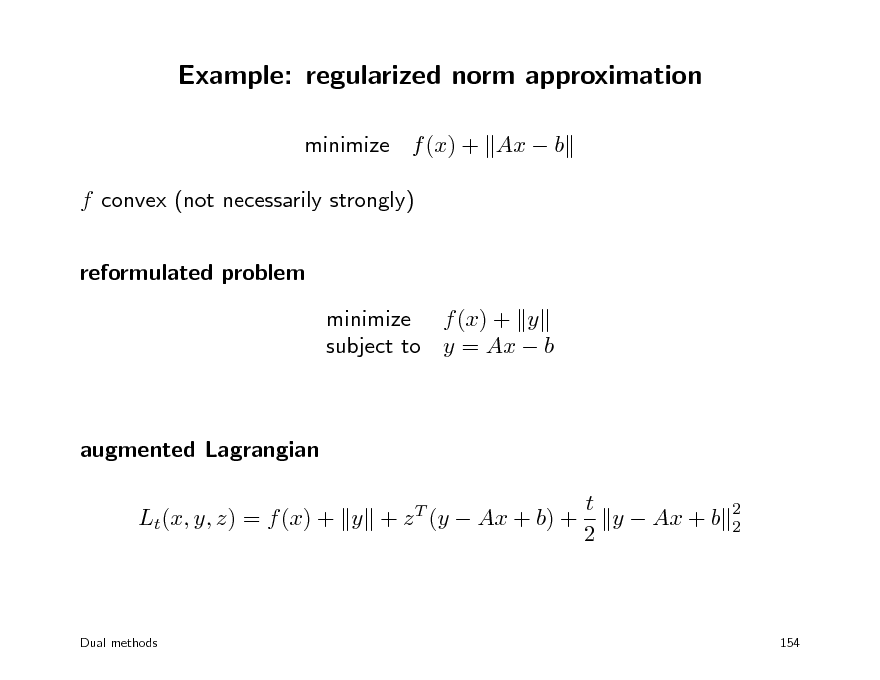
Example: regularized norm approximation
minimize f (x) + Ax b f convex (not necessarily strongly) reformulated problem minimize f (x) + y subject to y = Ax b
augmented Lagrangian t y Ax + b Lt(x, y, z) = f (x) + y + z (y Ax + b) + 2
T 2 2
Dual methods
154
176
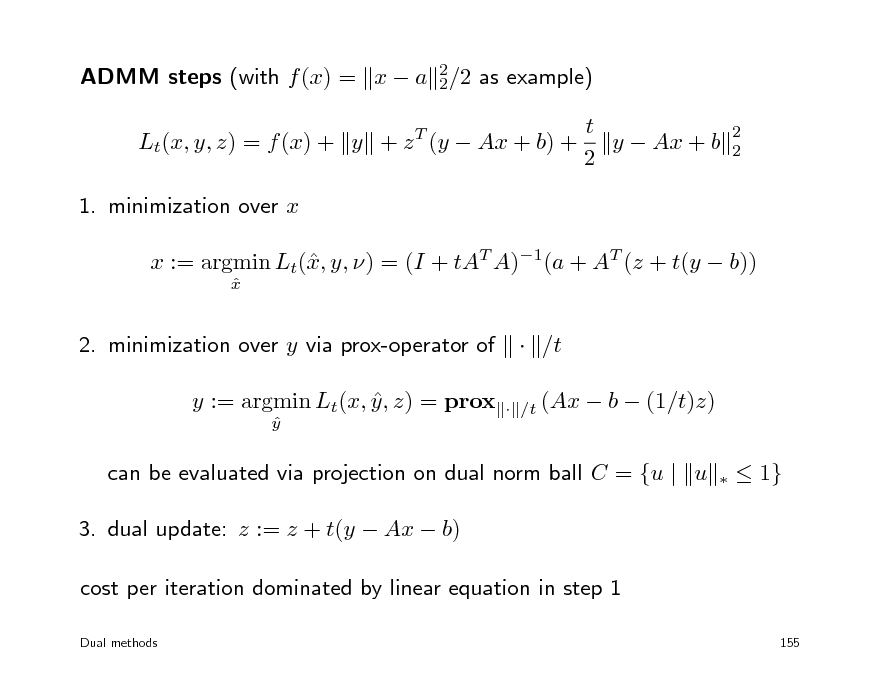
ADMM steps (with f (x) = x a 2/2 as example) 2 Lt(x, y, z) = f (x) + y + z T (y Ax + b) + 1. minimization over x x := argmin Lt(, y, ) = (I + tAT A)1(a + AT (z + t(y b)) x
x
t y Ax + b 2
2 2
2. minimization over y via prox-operator of y := argmin Lt(x, y , z) = prox
y
/t
/t (Ax
b (1/t)z)
can be evaluated via projection on dual norm ball C = {u | u 3. dual update: z := z + t(y Ax b) cost per iteration dominated by linear equation in step 1
Dual methods
1}
155
177
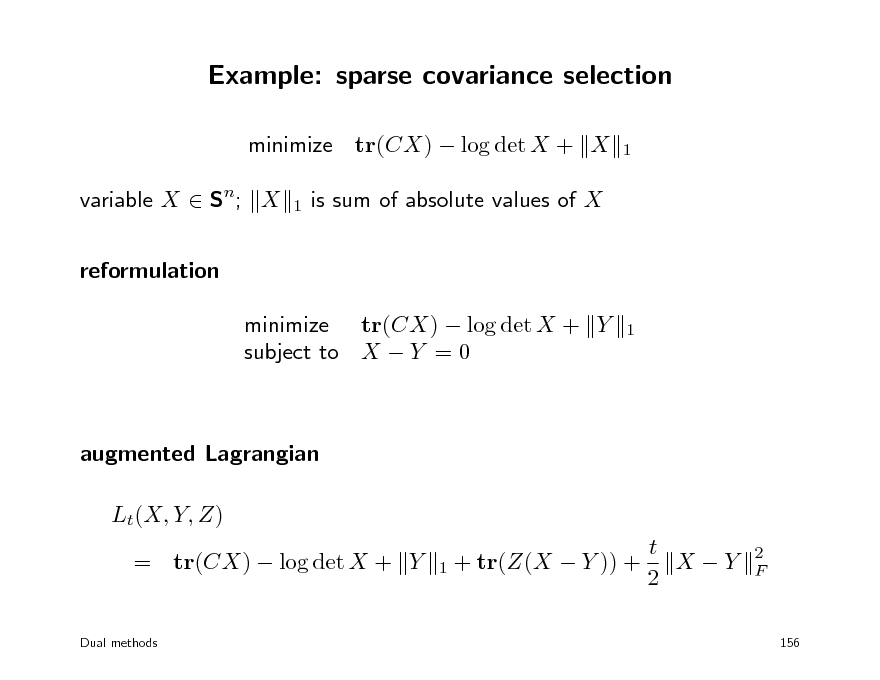
Example: sparse covariance selection
minimize tr(CX) log det X + X variable X Sn; X reformulation minimize tr(CX) log det X + Y subject to X Y = 0
1 1 1
is sum of absolute values of X
augmented Lagrangian Lt(X, Y, Z) t X Y = tr(CX) log det X + Y 1 + tr(Z(X Y )) + 2
Dual methods
2 F
156
178
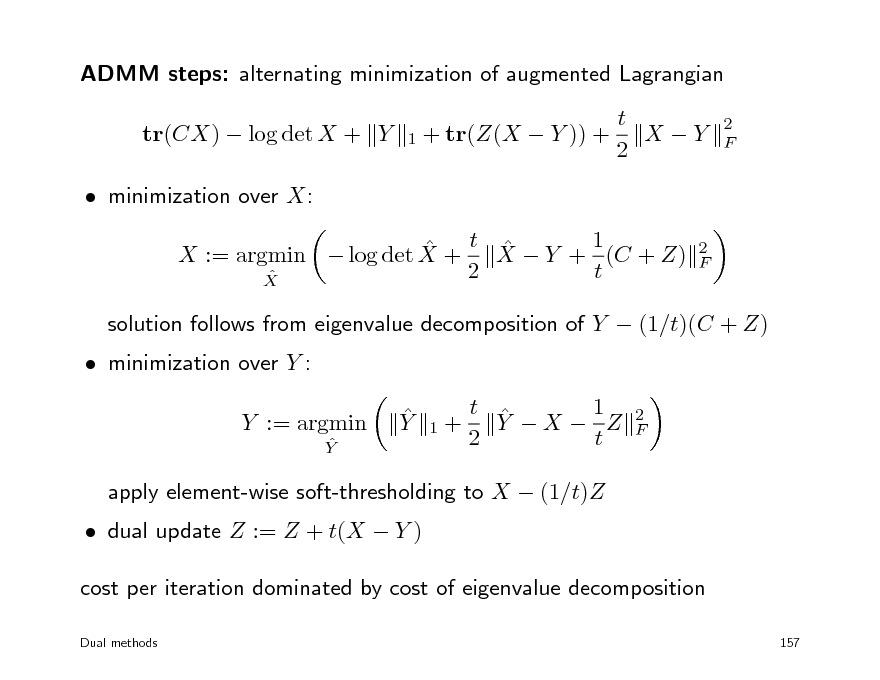
ADMM steps: alternating minimization of augmented Lagrangian tr(CX) log det X + Y minimization over X: t X Y + 1 (C + Z) X := argmin log det X + 2 t X
2 F 1 + tr(Z(X Y )) +
t X Y 2
2 F
minimization over Y :
solution follows from eigenvalue decomposition of Y (1/t)(C + Z) Y 1 t Y X Z 2 t
2 F
Y := argmin
Y
1+
dual update Z := Z + t(X Y )
apply element-wise soft-thresholding to X (1/t)Z
cost per iteration dominated by cost of eigenvalue decomposition
Dual methods 157
179
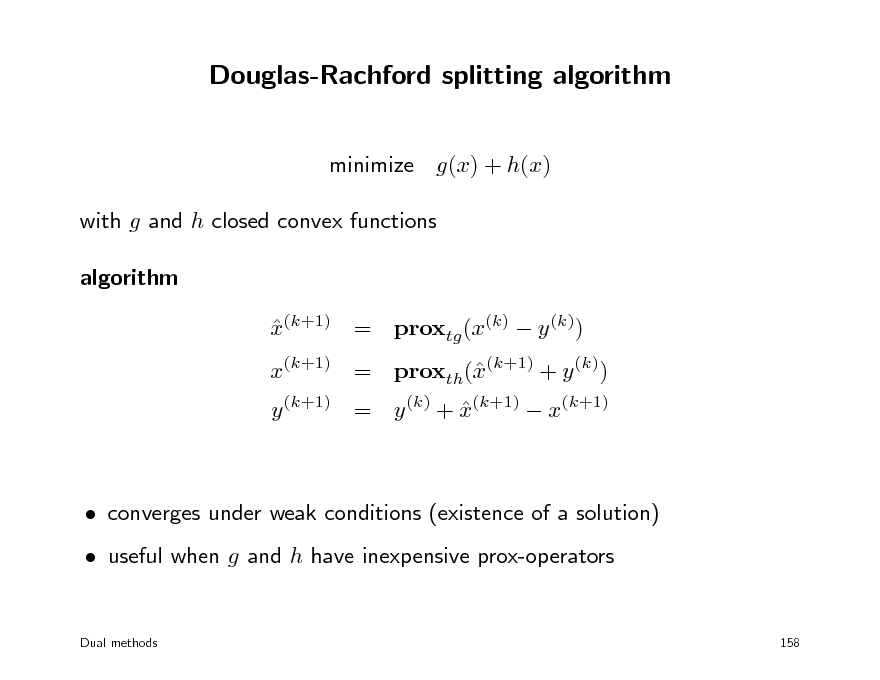
Douglas-Rachford splitting algorithm
minimize g(x) + h(x) with g and h closed convex functions algorithm x(k+1) = proxtg (x(k) y (k))
x(k+1) = proxth((k+1) + y (k)) x y (k+1) = y (k) + x(k+1) x(k+1)
converges under weak conditions (existence of a solution) useful when g and h have inexpensive prox-operators
Dual methods 158
180
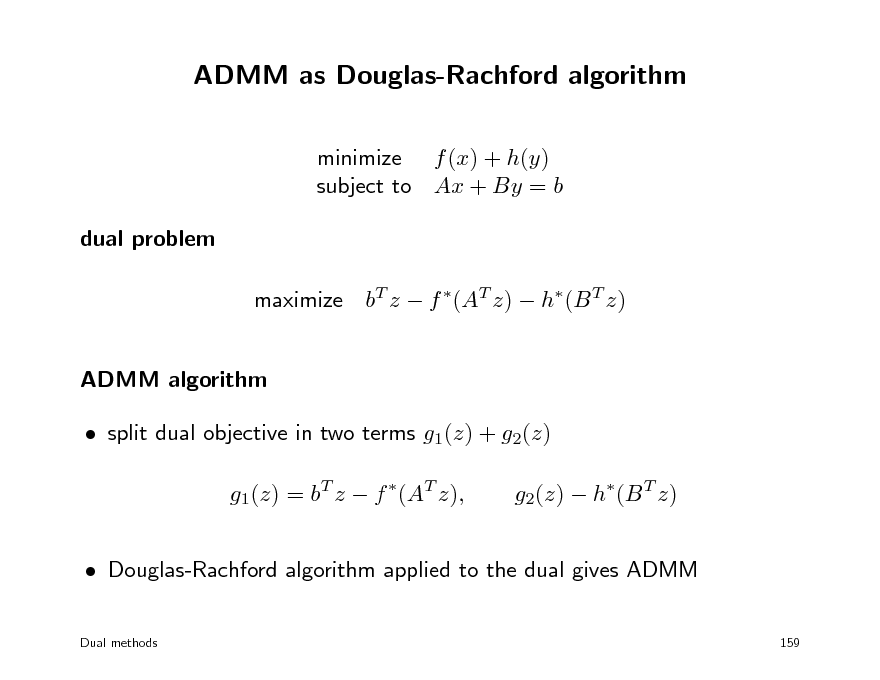
ADMM as Douglas-Rachford algorithm
minimize f (x) + h(y) subject to Ax + By = b dual problem maximize bT z f (AT z) h(B T z) ADMM algorithm split dual objective in two terms g1(z) + g2(z) g1(z) = bT z f (AT z), g2(z) h(B T z)
Douglas-Rachford algorithm applied to the dual gives ADMM
Dual methods 159
181
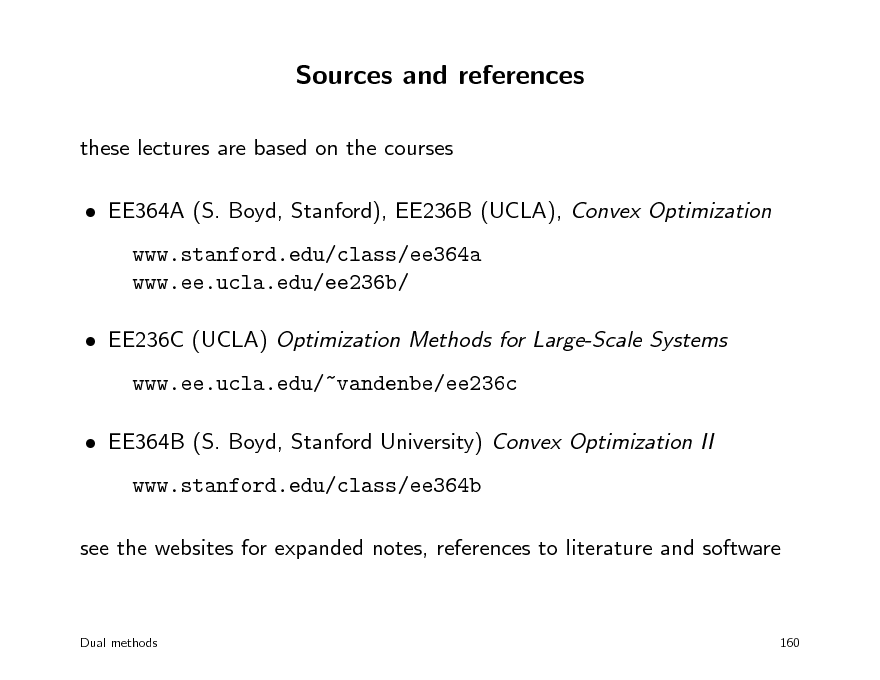
Sources and references
these lectures are based on the courses EE364A (S. Boyd, Stanford), EE236B (UCLA), Convex Optimization www.stanford.edu/class/ee364a www.ee.ucla.edu/ee236b/ EE236C (UCLA) Optimization Methods for Large-Scale Systems www.ee.ucla.edu/~vandenbe/ee236c EE364B (S. Boyd, Stanford University) Convex Optimization II www.stanford.edu/class/ee364b see the websites for expanded notes, references to literature and software
Dual methods
160
182
Site based on the django-slidedeck framework by Jason Yosinski.
Find a bug? Email Jason or submit a pull request on Github.